The Siege and Blockade of Tuzla,
Bosnia and Herzegovina Nov/Dec 1993
The Bosnian War was a complex military conflict in the region of Bosnia and Herzegovina, between April 6th 1992 and December 14th 1995. The war was caused by historical, political, social and ethnic crises following the end of the Cold War and the fall of the socialist system in Yugoslavia after the death of post war leader Josip Broz Tito (1892-1980).
In April 1992 a hurricane of violence was unleashed by the Army of Republika Srpska, (Bosnian Serb Army), against their Bosnian Muslim neighbours (Bosniaks) starting in Višegrad, the Drina valley and other parts of Bosnia. Within six weeks after a coordinated offensive the Bosnian Serb Army had brought two thirds of Bosnia and Herzegovina under its control. A frenzy of nationalism, ethnic cleansing, mass rape and genocide followed. An estimated 100,000 people were killed and 2 million displaced.
The following selection of photographs and interviews were taken during a 3 week assignment to the besieged and blockaded enclave of Tuzla in eastern Bosnia during late November and December 1993 on behalf of aid agency Oxfam. As a temporary member of the United Nations High Commission for Refugees (UNHCR), I made my way by UN Puma helicopters from Split, Croatia to the industrial city of Tuzla in eastern Bosnia, before returning via Sarajevo to Split.
My brief was to photograph the distribution of winter clothing and footwear to refugees (forced internally displaced people), provide publicity images that will be used to raise funding and public awareness to the plight facing refugees during the approaching winter and produce persuasive imagery for international aid agency Oxfam’s 1994 Cold Front Appeal.
I arrived in Tuzla in late November by UN Puma helicopter to the smell of wood smoke and sewage which permeated throughout the city. The city was blockaded by Serb Armed forces to the north and west and Croatian Nationalists to the south. The cities encirclement, blockade and siege had lasted for 10 months.
In order to terrorise and create fear in the population, Tuzla was randomly shelled each day from Serbian Army artillery positions in the Ozren mountains 25km away and near Majevica 14km away. Travel for residents and refugees was limited to within several miles of Tuzla. Small amounts of aid arrived sporadically through UNHCR designated aid corridors. The only way to enter or leave Tuzla was by UN helicopters or UNPROFOR armoured personnel carriers. The blockade was partially lifted in March 1994 when Tuzla airport opened to the first UN humanitarian aid flights.
The power station had been damaged, which meant only limited electricity was available each day, often only one hour per day. Burning wood and coal were the main source for heating and cooking, car batteries were charged when electricity was available which provided limited 12 volt lighting during the evenings.
The ethnic cleansing of Bosniaks by Serb paramilitaries from the surrounding districts had doubled the city population from 140,000 residents pre war, straining its already limited resources, refugees were housed in schools, sports halls and public buildings. Their lives were one of constant uncertainty, with no future and many a horrific past.
It was persistently cold working in Tuzla, a 7pm-7am curfew was strictly enforced as Serb raiding parties were known to enter the city at night. I shared a room with Andrew Chadwick, Oxfam’s Bosnia representative in Tuzla, making sure all the doors and windows were securely barricaded each night.
This commission was made especially challenging as there was resentment towards outsiders, making local assistance to me limited. Bosniaks justifiably considered they had been forgotten and abandoned by the western nations. However, with support from Andrew Chadwick and programme manager Jasmina Husanovic who was assigned as my translator and facilitator, I was able to complete this assignment. Their local knowledge and assistance was essential and greatly appreciated.
Images from this assignment were used widely in full page UK national newspaper campaigns and magazine articles to inform the public and appeal to governments to intervene in the forthcoming humanitarian catastrophe.
I was aware at the time that this series of photographs, text and interviews could eventually become an historic archive documenting this extraordinary time and place. Therefore I endeavoured to record these events with veracity.
Many refugees and residents of Tuzla did not wish to be identified by name, but all featured here consented to be photographed. My thanks and admiration goes to them and for the considerable hardships they endured through that harsh winter.
Thirty-three b/w A2 archival prints from this series have been acquired by the Humanitarian and Conflict Response Institute, John Rylans Institute and Library, The University of Manchester, UK in March 2024.
Fifty b/w and colour A3 archival prints have been acquired by the Museum of East Bosnia, Tuzla in February 2025. These prints will remain permanently in the museums war archive for reference and exhibition and will be available to researchers in the future.
Many thanks to:
Ljubiša Veljković: Director of the Museum of East Bosnia, Tuzla.
Jasmina Husanović: Professor of Cultural and Gender Studies, University of Tuzla.
Senad Begović: Curator at The Bosnian Cultural Centre, Tuzla.
Dennis McShane: Tuzla based Photographer.
All images and text are Strictly Copyright © Bill Stephenson All Rights Reserved
Journey from Split, Croatia, via Kisejak, to Tuzla airbase
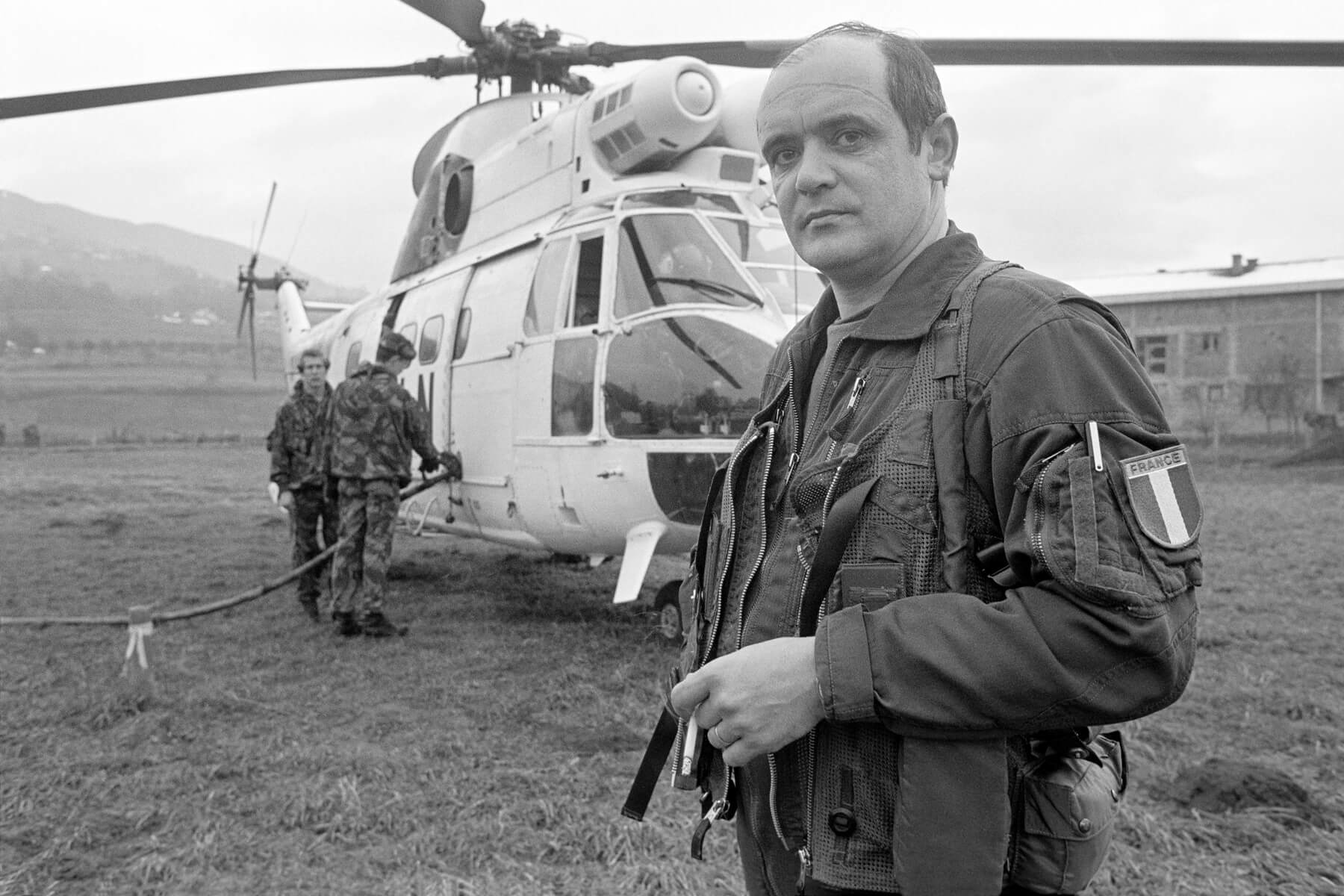
[BOS 01] French UN Puma pilot smokes a cigarette while his helicopter refuels at UNPROFOR headquarters at Kiseljak en route from Split, Croatia to Tuzla Air Base near Dubrave.
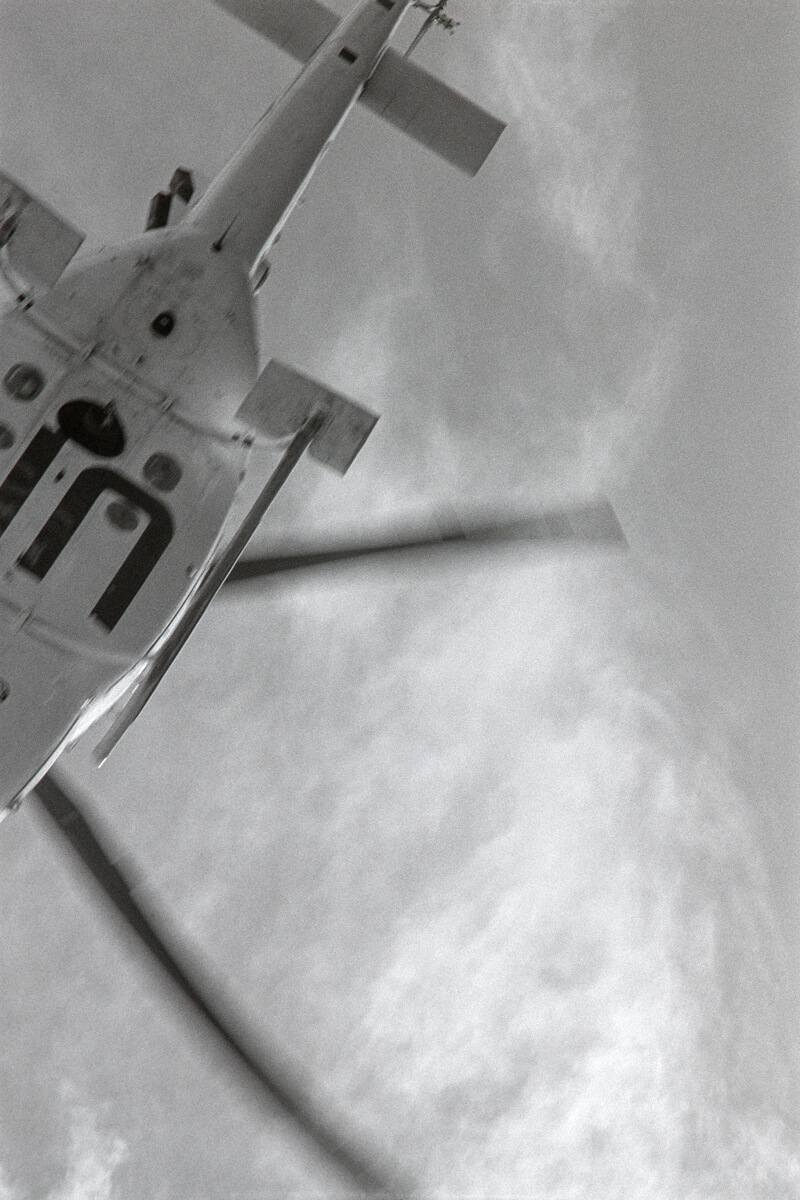
[BOS 02] UN Puma helicopter taking off from UNPROFOR HQ, Kiseljak airbase.
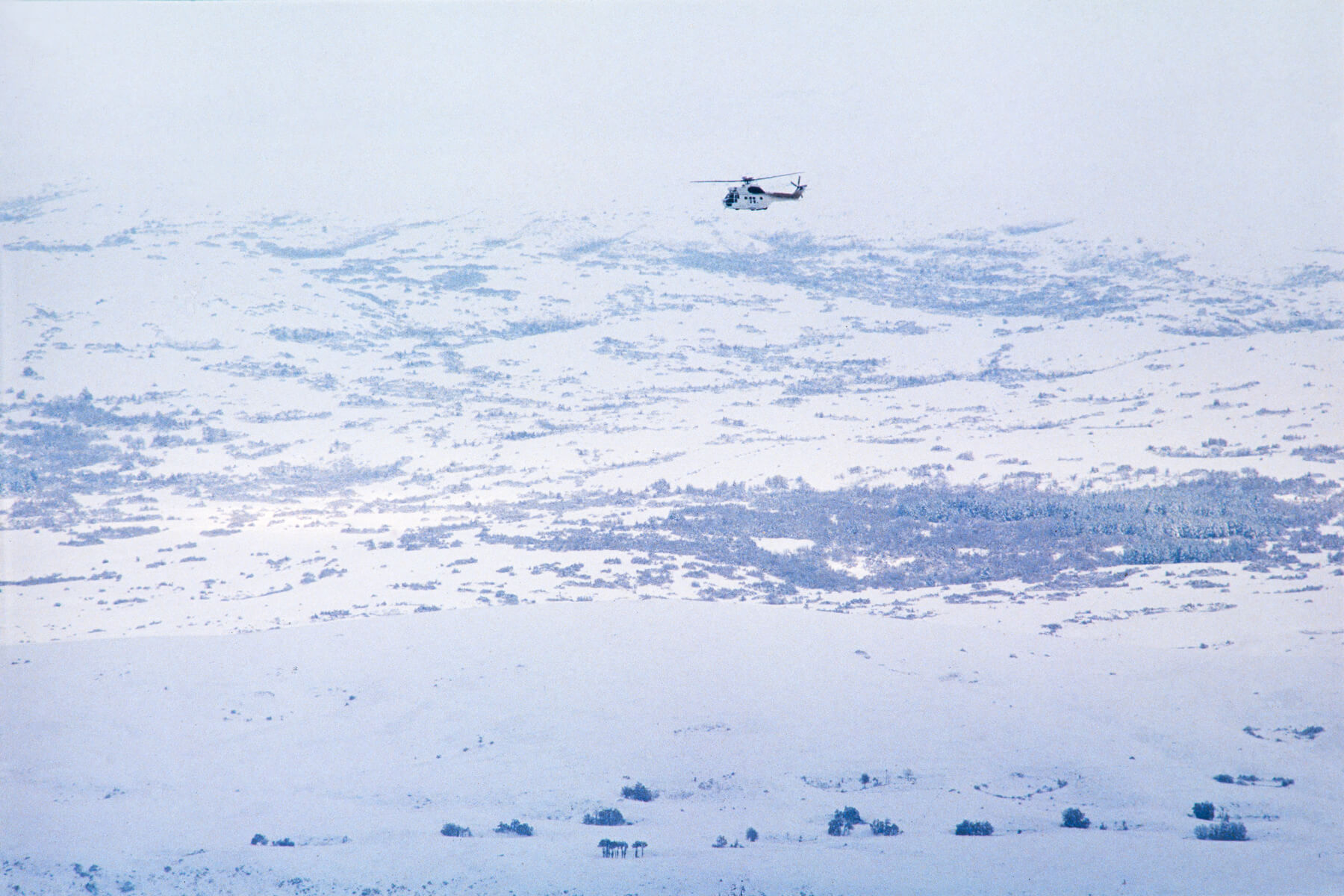
[BOS 03] View from our helicopter flying low, frequently changing direction to avoid detection over the Dinaric Alps en route to Tuzla. It was standard procedure for UN helicopters to fly in pairs for increased safety in hostile locations.
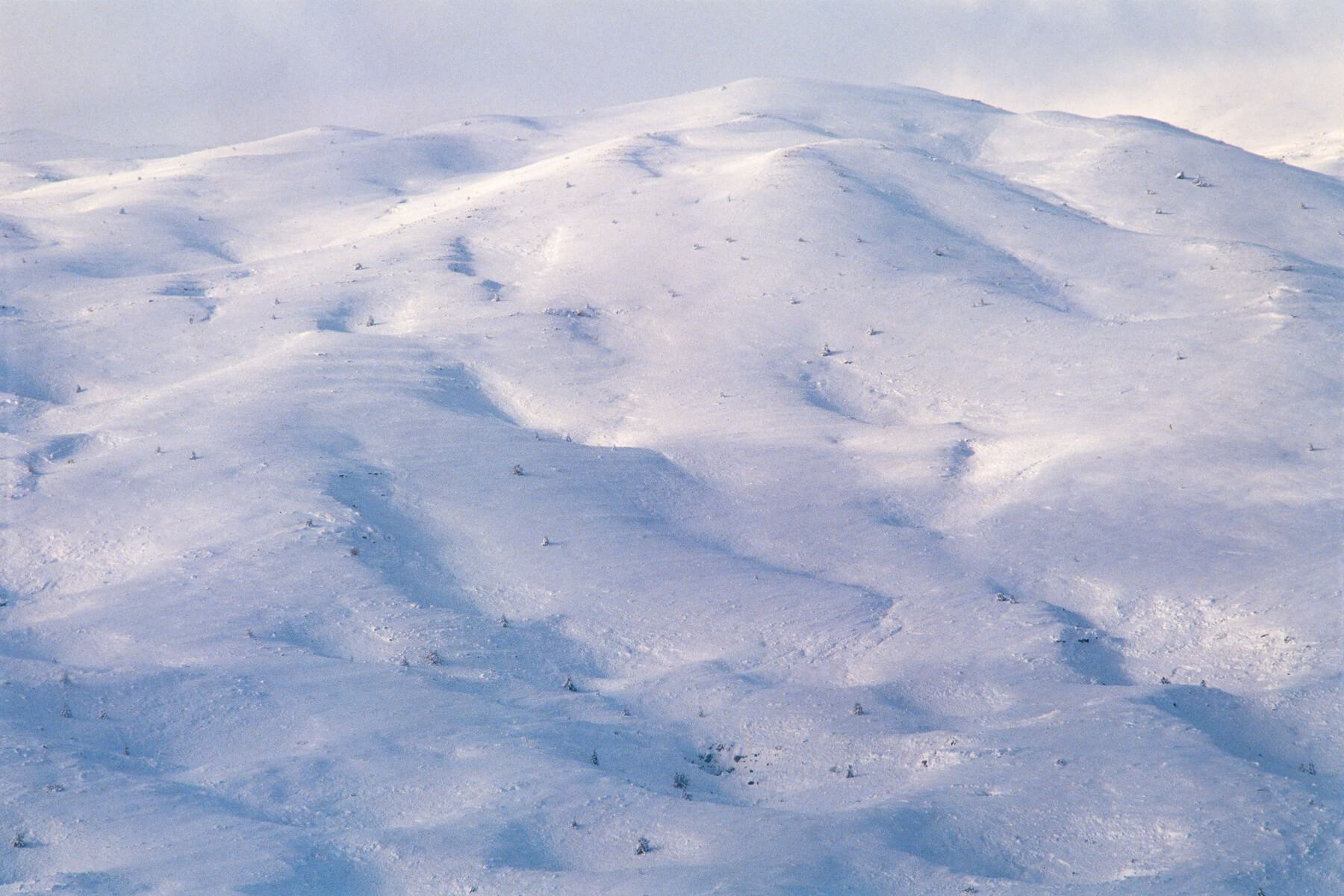
[BOS 04] View of the Dinaric Alps flying towards Tuzla.
The Siege and Blockade of Tuzla
Tuzla is the third largest city in Bosnia and had been blockaded by Serbian Armed Forces to the east and Croatian nationalists to the west for 10 months. The blockade was partly lifted in March 1994 when Tuzla airport opened to UN humanitarian aid flights. However in December 1993 all the key roads around Tuzla had been barricaded, the airport closed, resulting in only small amounts of food and humanitarian aid arriving overland irregularly by UNHCR convoys known as the Tuzla Nomads. The only other way to enter or leave Tuzla was by UNPROFOR armoured personal carriers or UN helicopters.
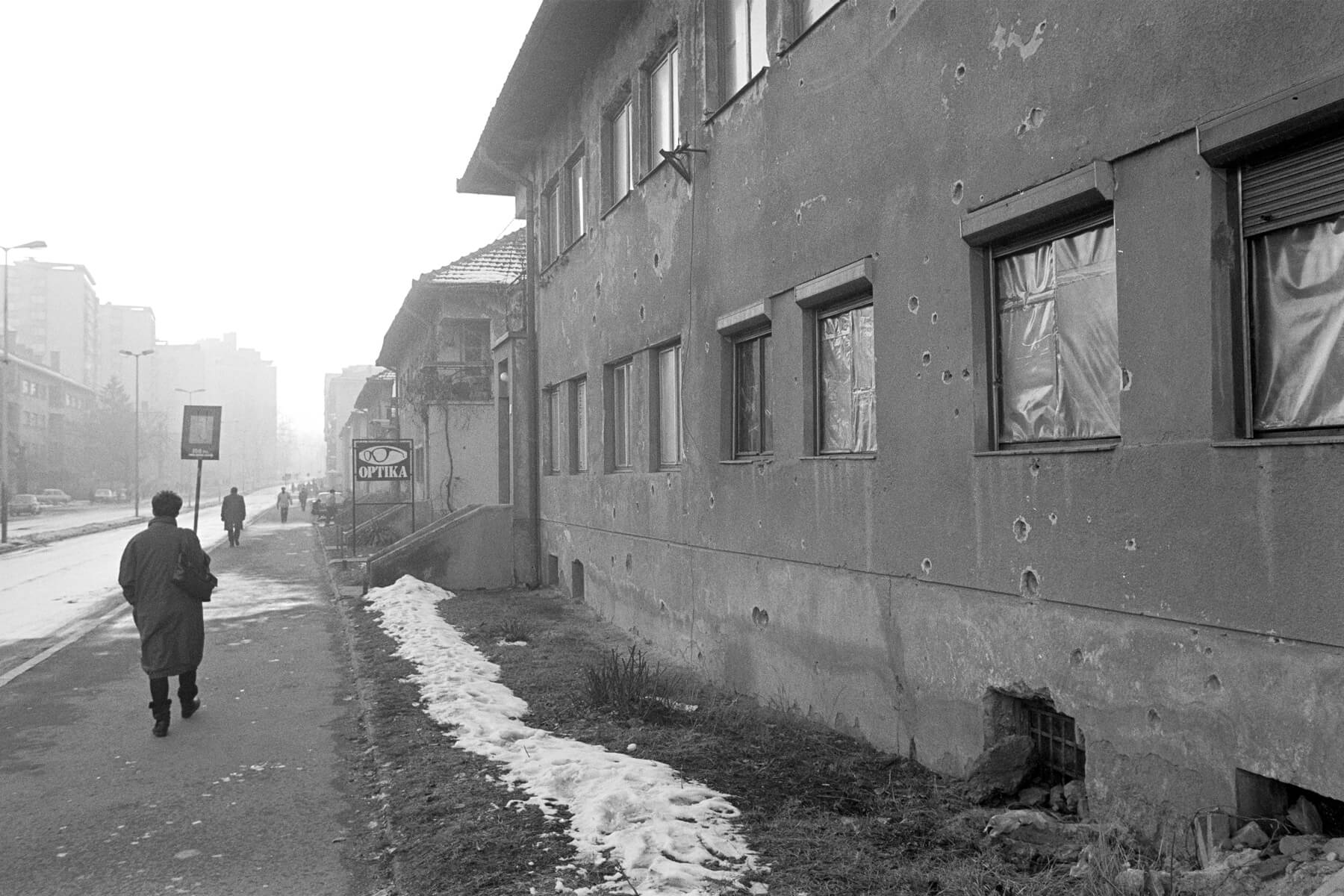
[BOS 05] Rudarska is the main highway running through Tuzla. The building on the right is pockmarked from gunfire. The 10 months blockade has meant that no petrol or diesel fuel has been delivered for public or private transport, therefore everyone has to walk.
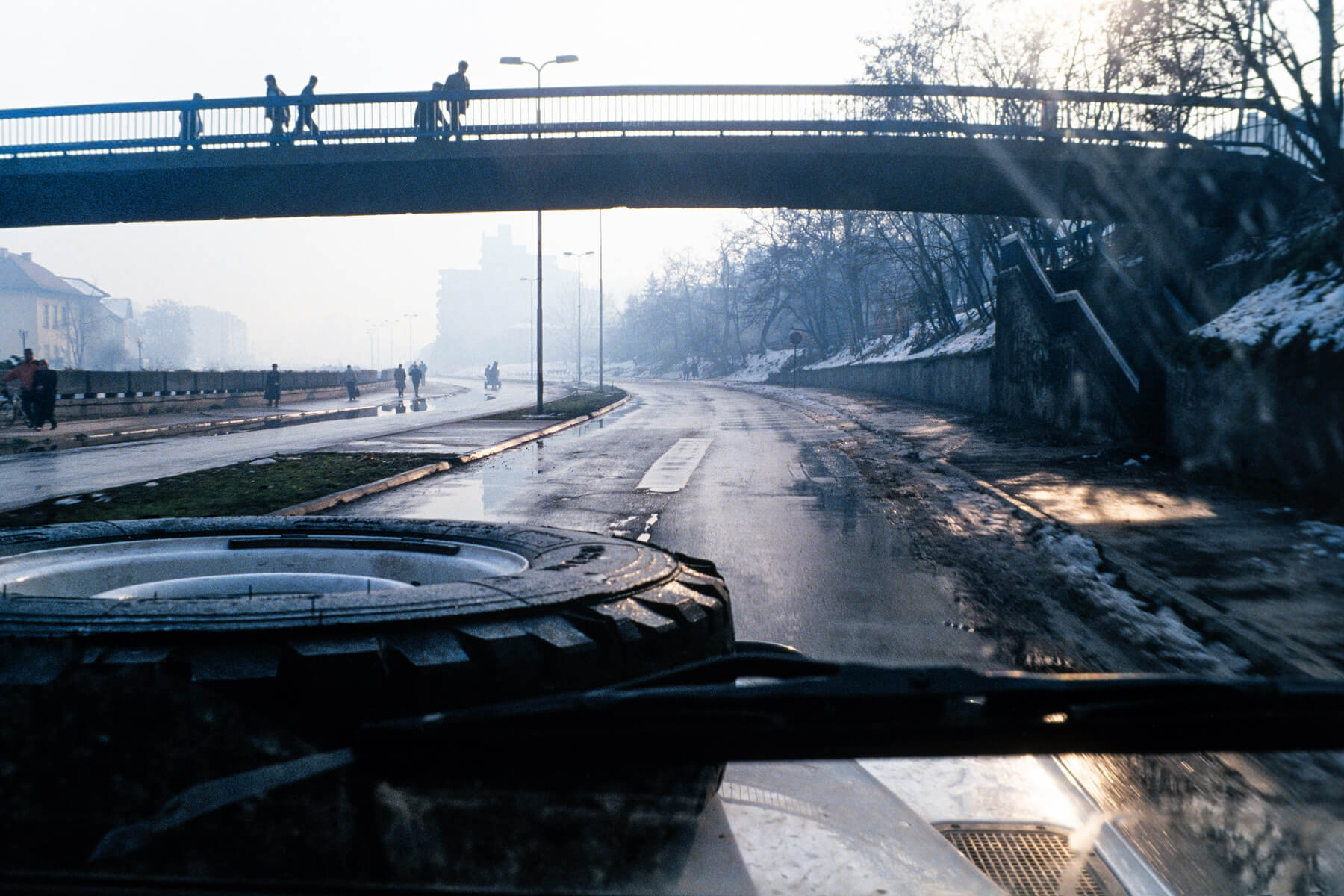
[BOS 06] View along the empty M4, the main road through Tuzla. Photograph taken from Oxfam’s Land Rover.
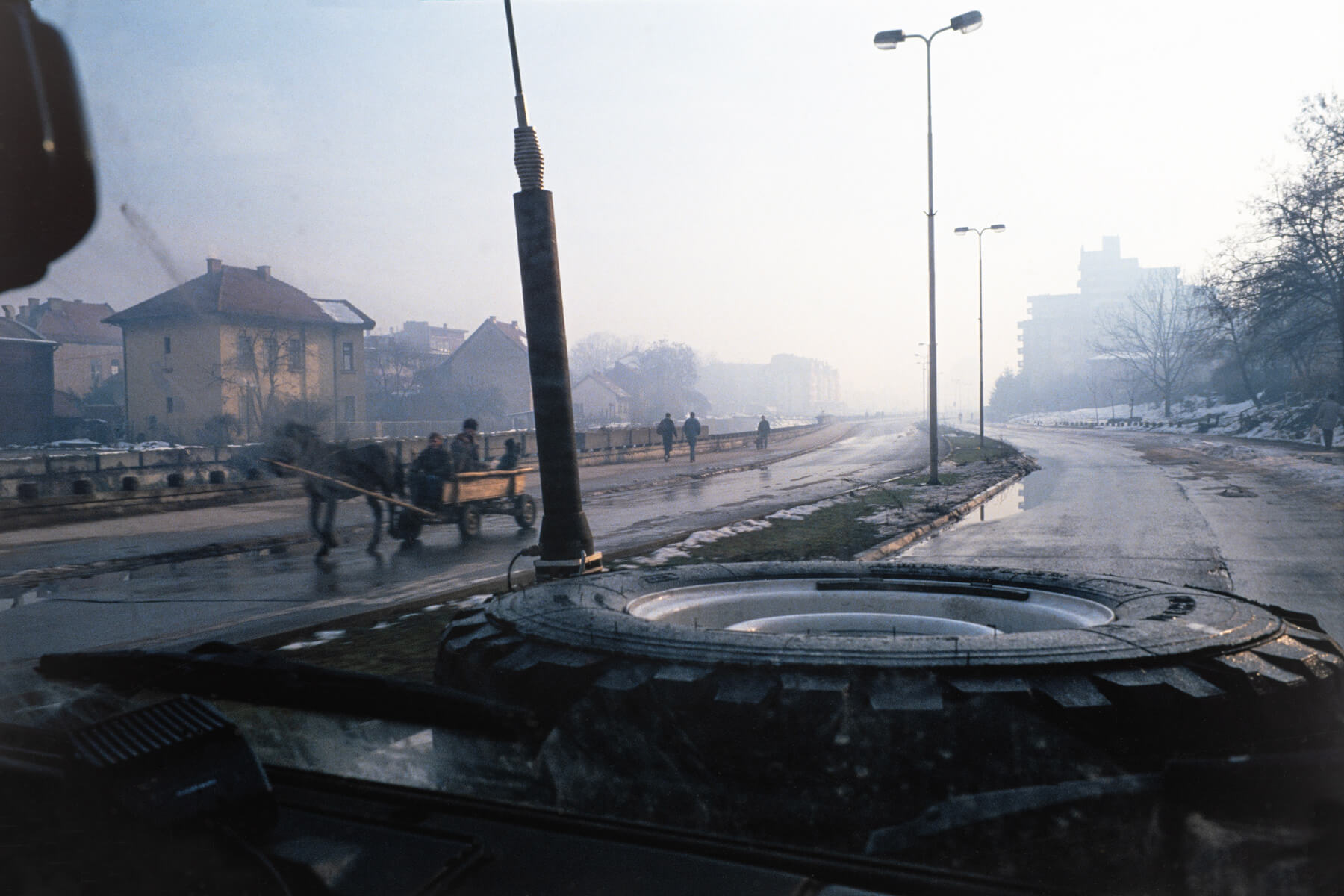
[BOS 07] View of the empty M4, the main road through Tuzla.
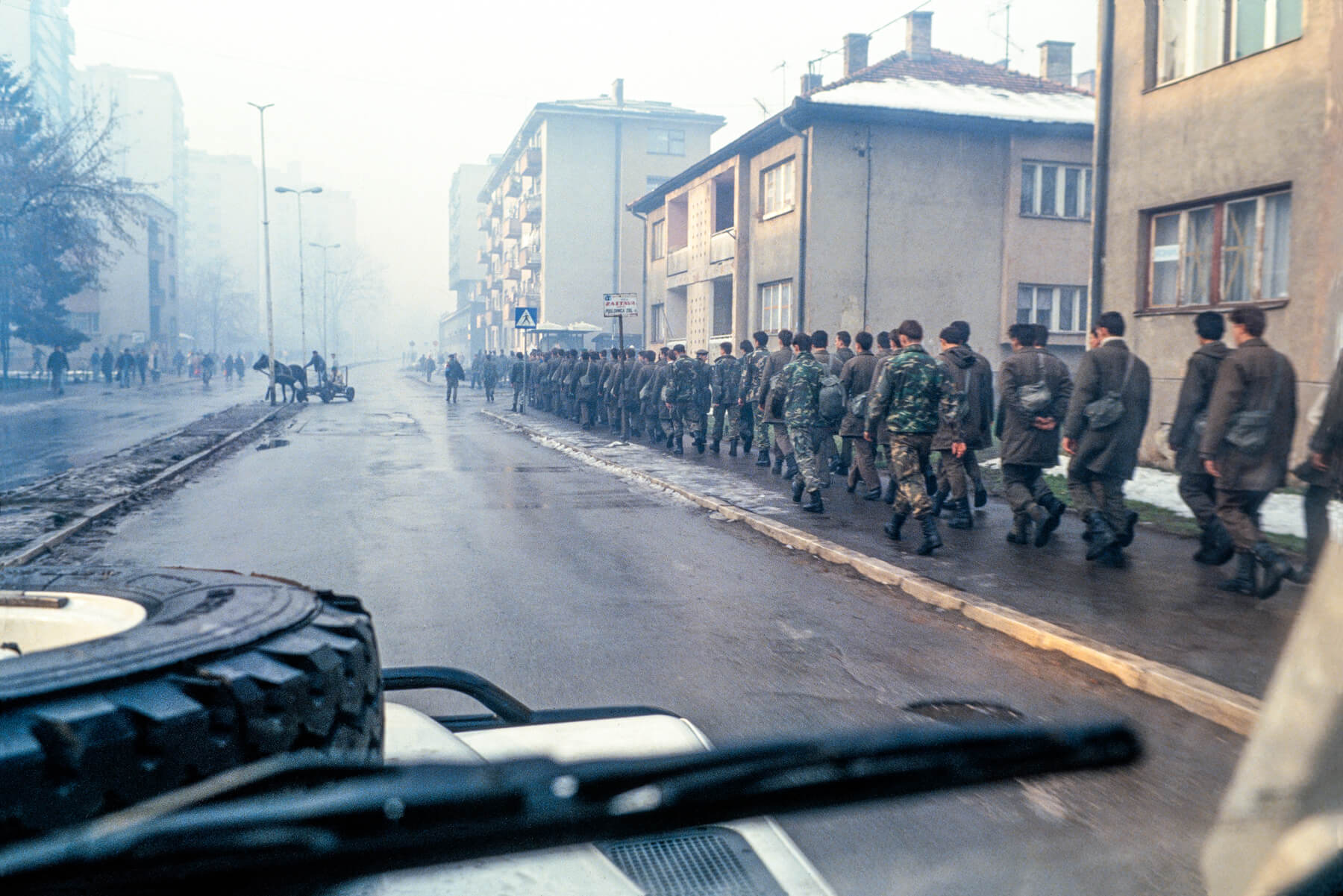
[BOS 08] Soldiers from the Army of the Republic of Bosnia and Herzegovina are mobilised for the defence of Tuzla, they are marching down the main road through Irac. The photograph was taken from Oxfam’s Land Rover.
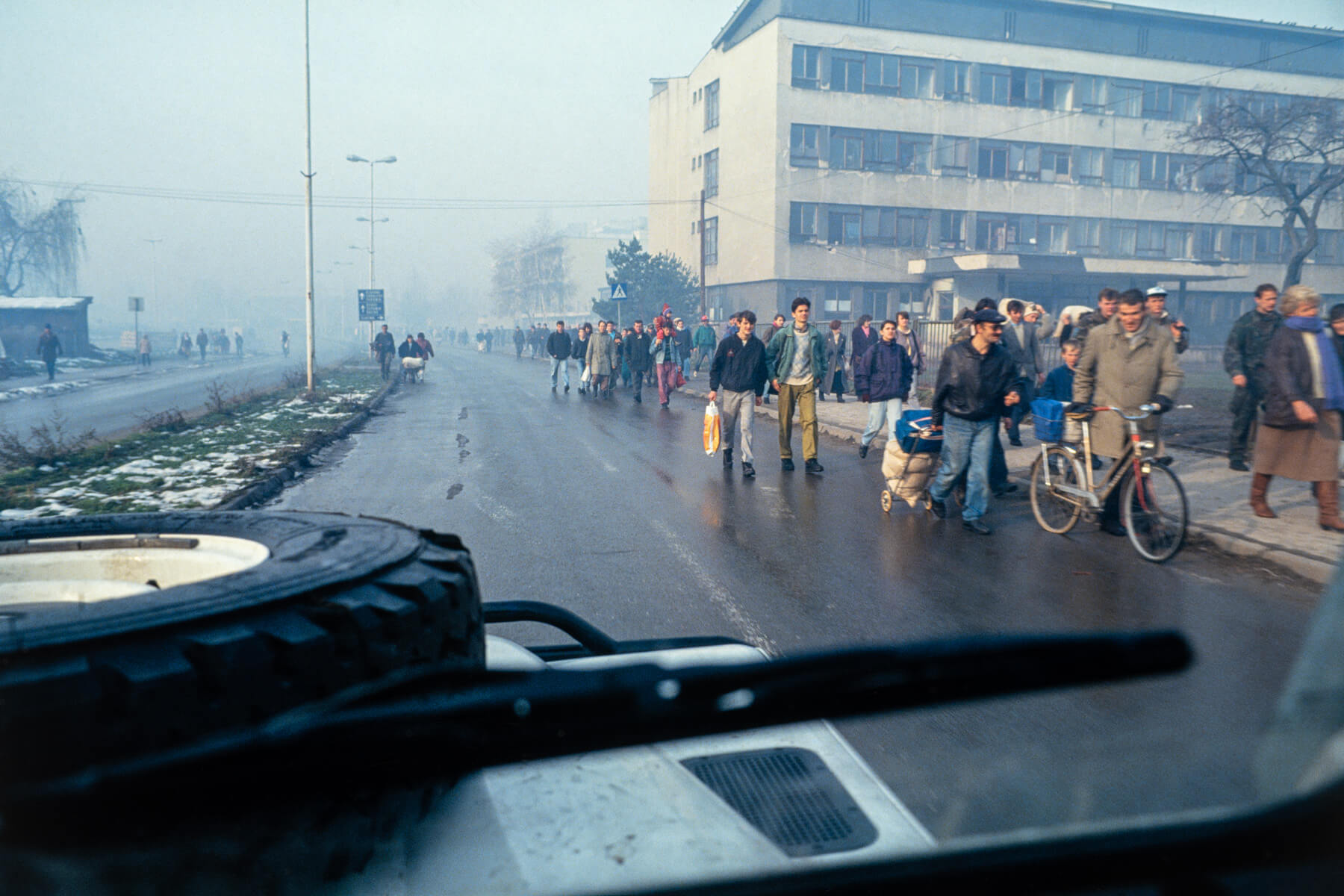
[BOS 09] People walking down the main road through Irac on their way to work. Many factories and businesses are located in this district. Everyone is on foot as there is no fuel for private cars or public transport.
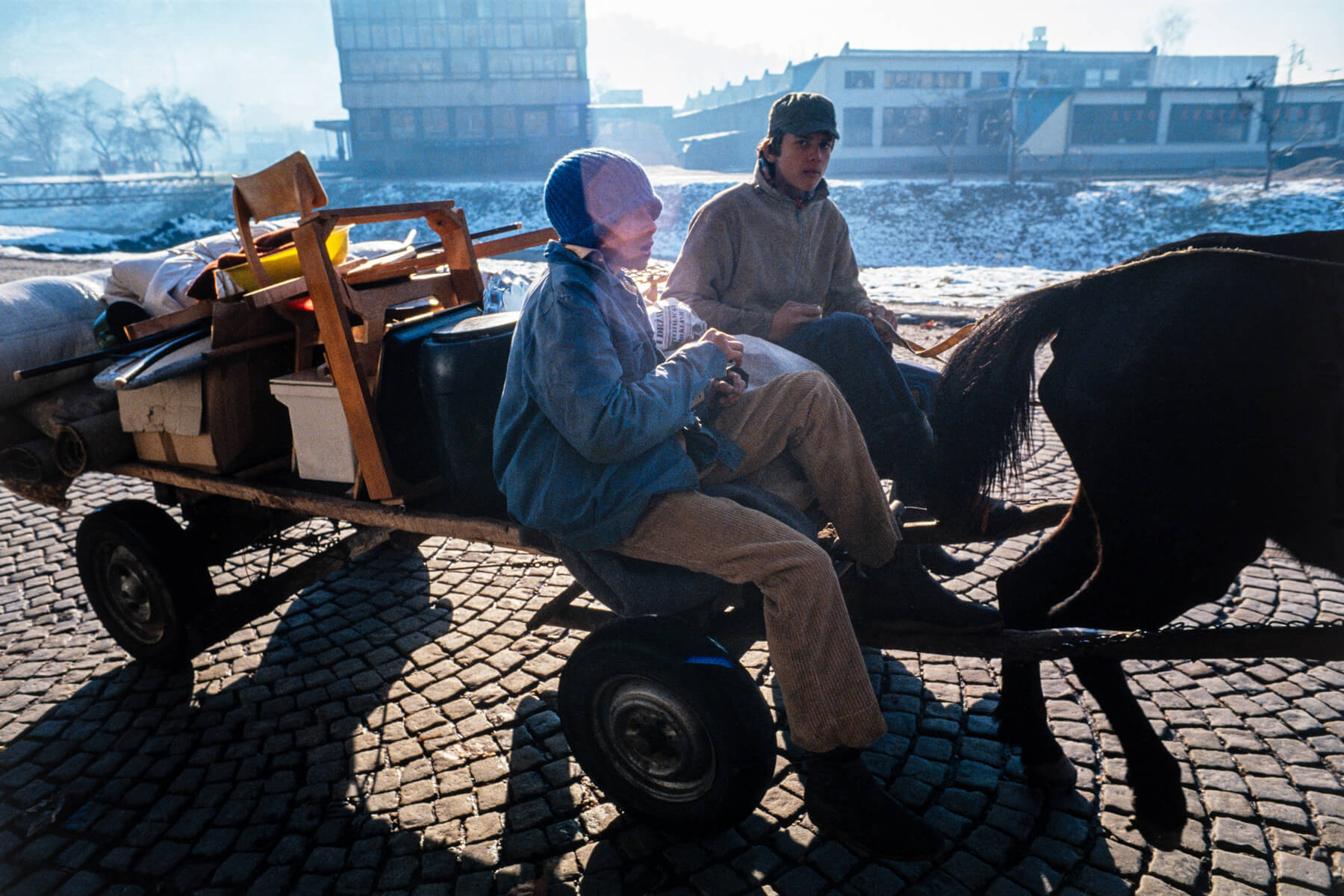
[BOS 10] Boys delivery goods on a horse drawn wagon past the river Jala.
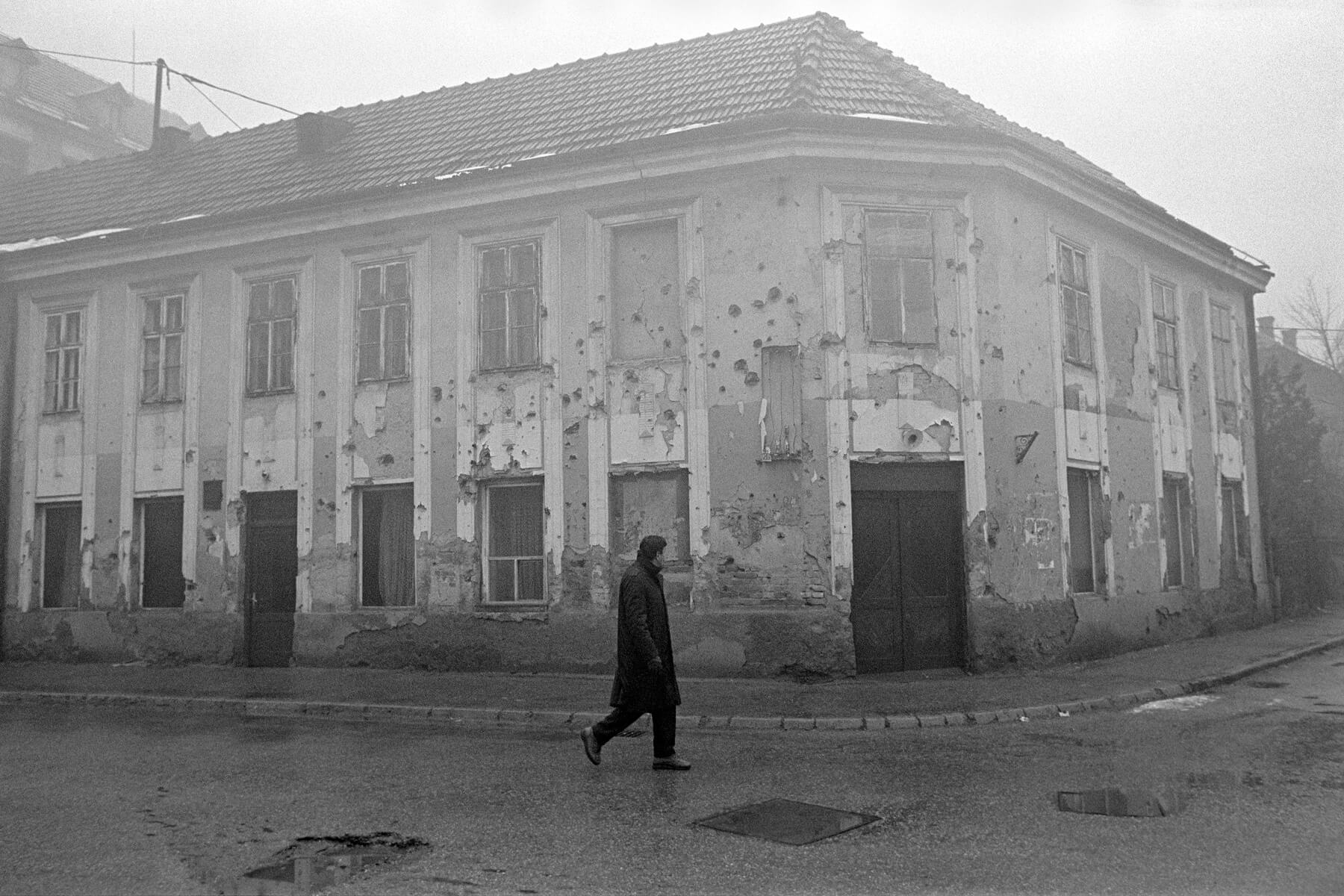
[BOS 11] Building in the central district of Korzo, pockmarked with shrapnel from an artillery shell. Tuzla was randomly shelled each day from Serbian artillery positions 9km away.
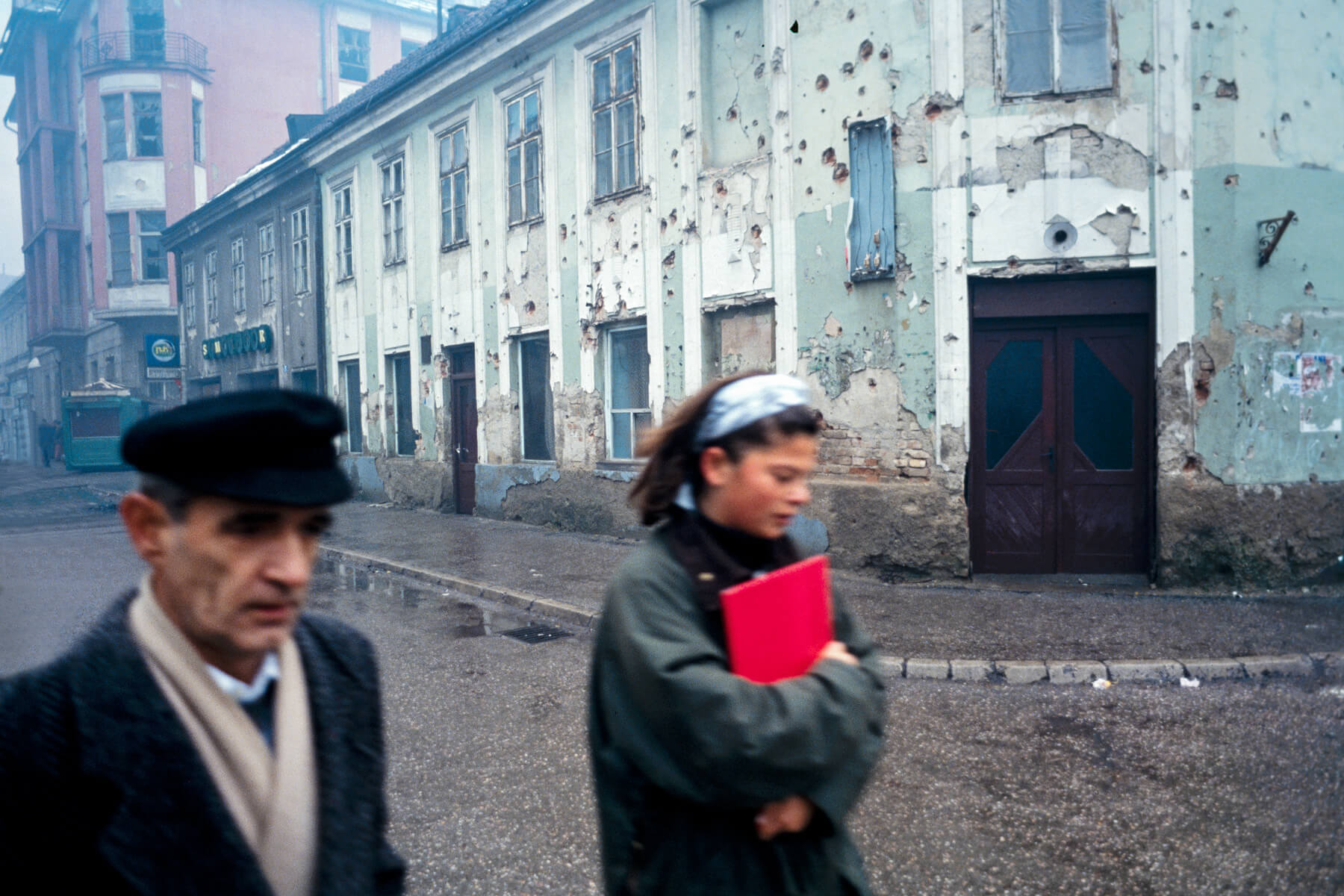
[BOS 12] People rush past the building recently pockmarked from an artillery shell in the central district of Korzo.
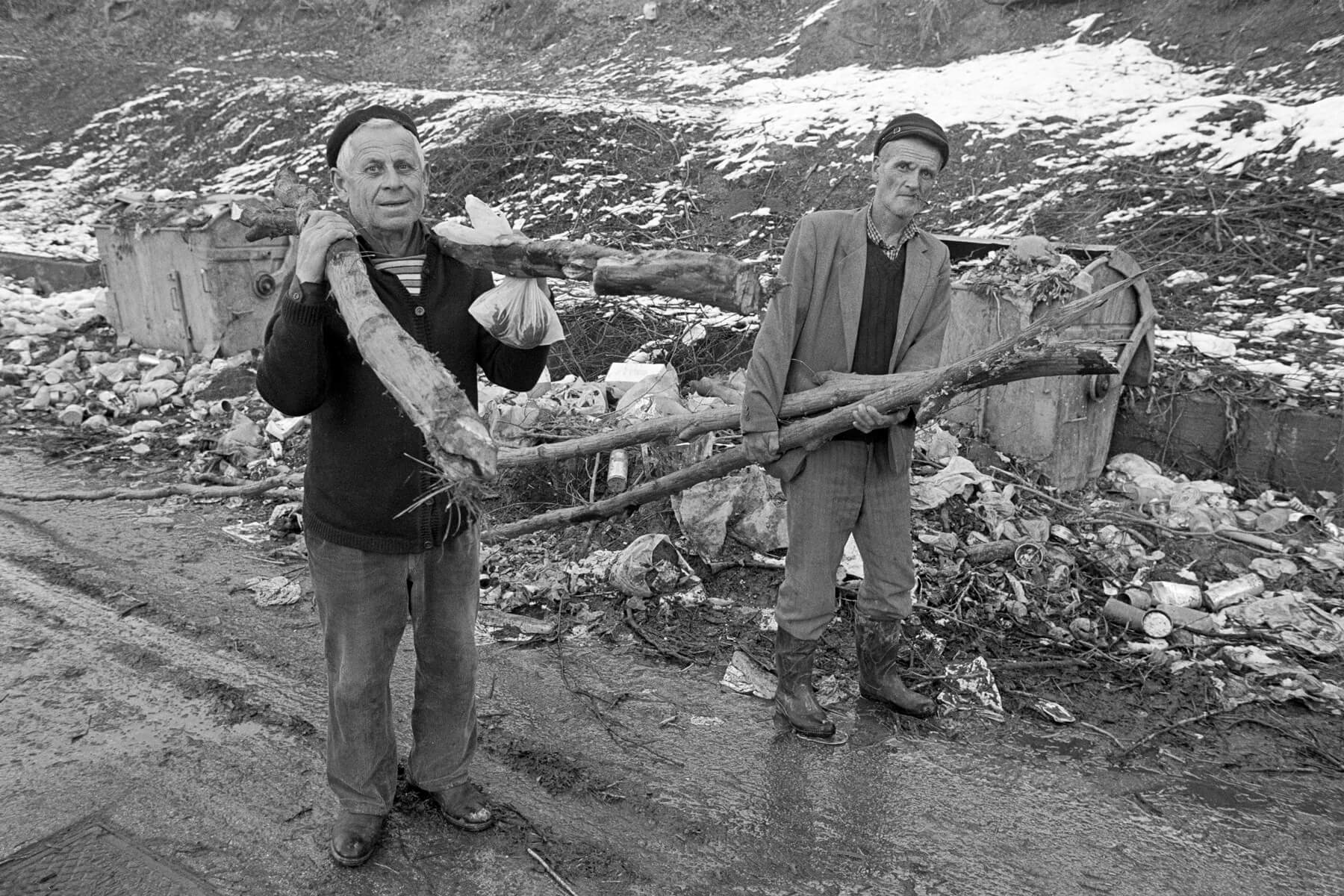
[BOS 13] Men collecting firewood from woodland in the Paša Bunar, Skojevska and Slavinovići districts of Tuzla for heating and cooking. Often only one hour of electricity is available each day.
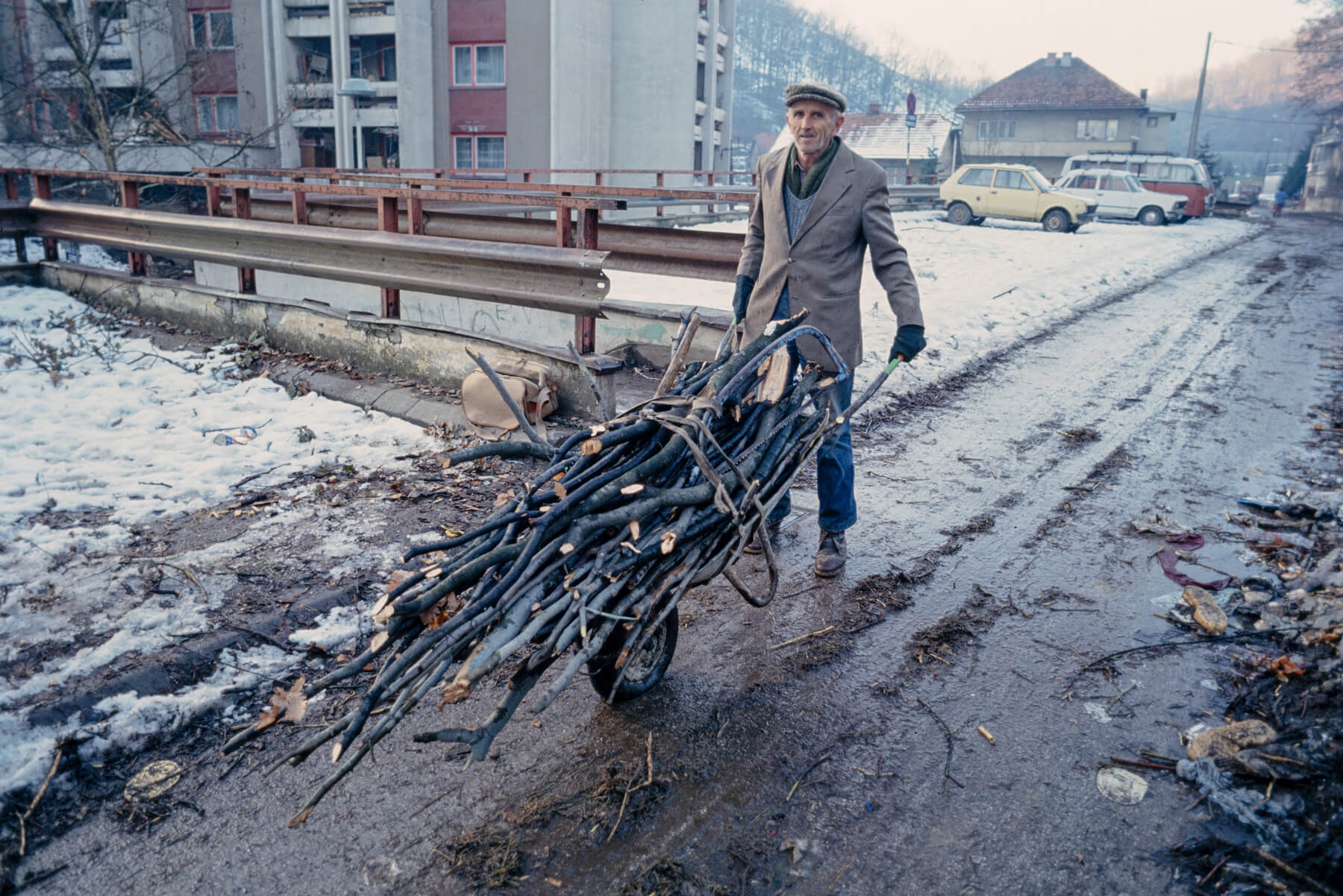
[BOS 14] Man returns with firewood from woodland on the outskirts of Tuzla.
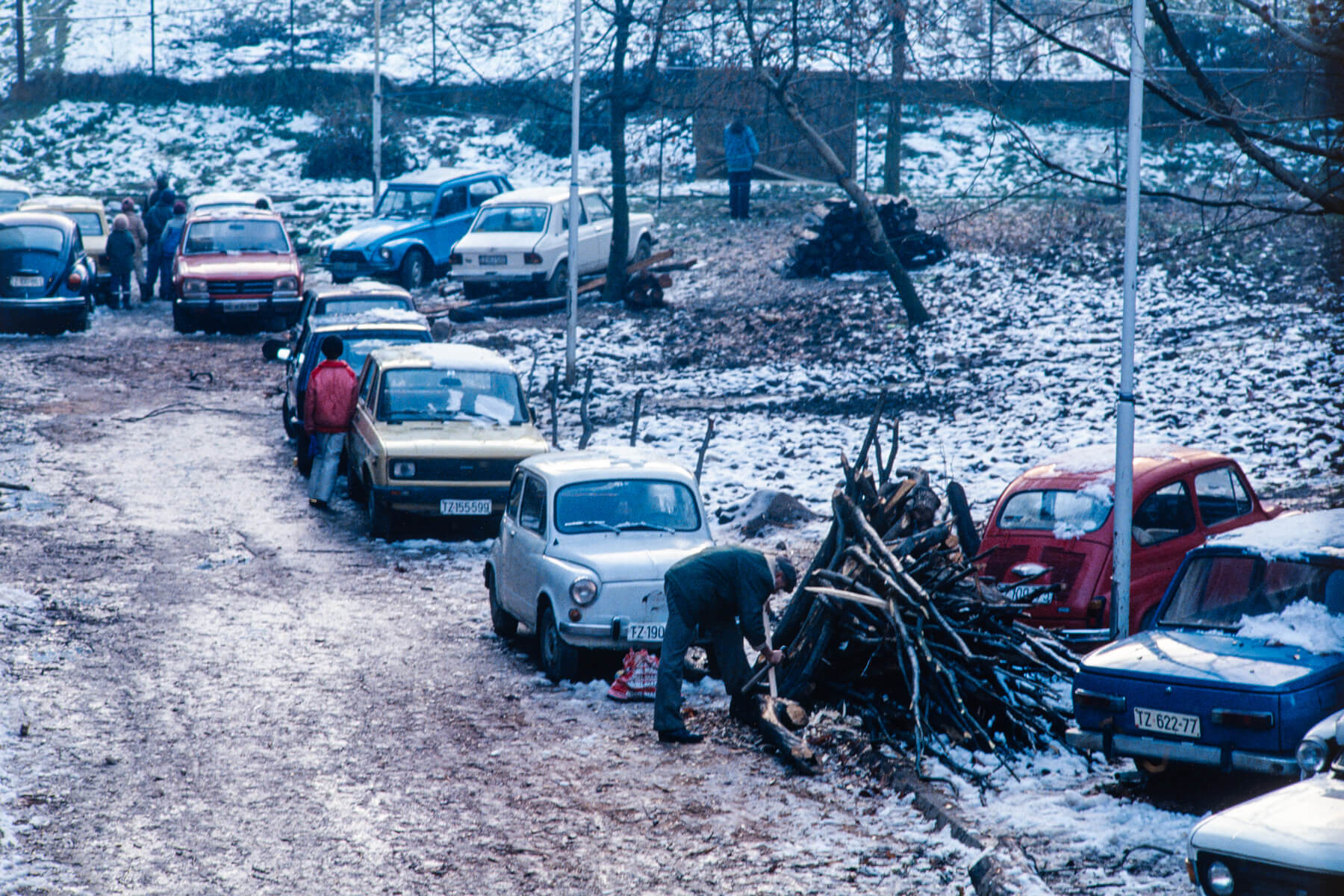
[BOS 15] Man stacks firewood near abandoned cars. No diesel or petrol has been available for 10 months therefore unused cars are everywhere.
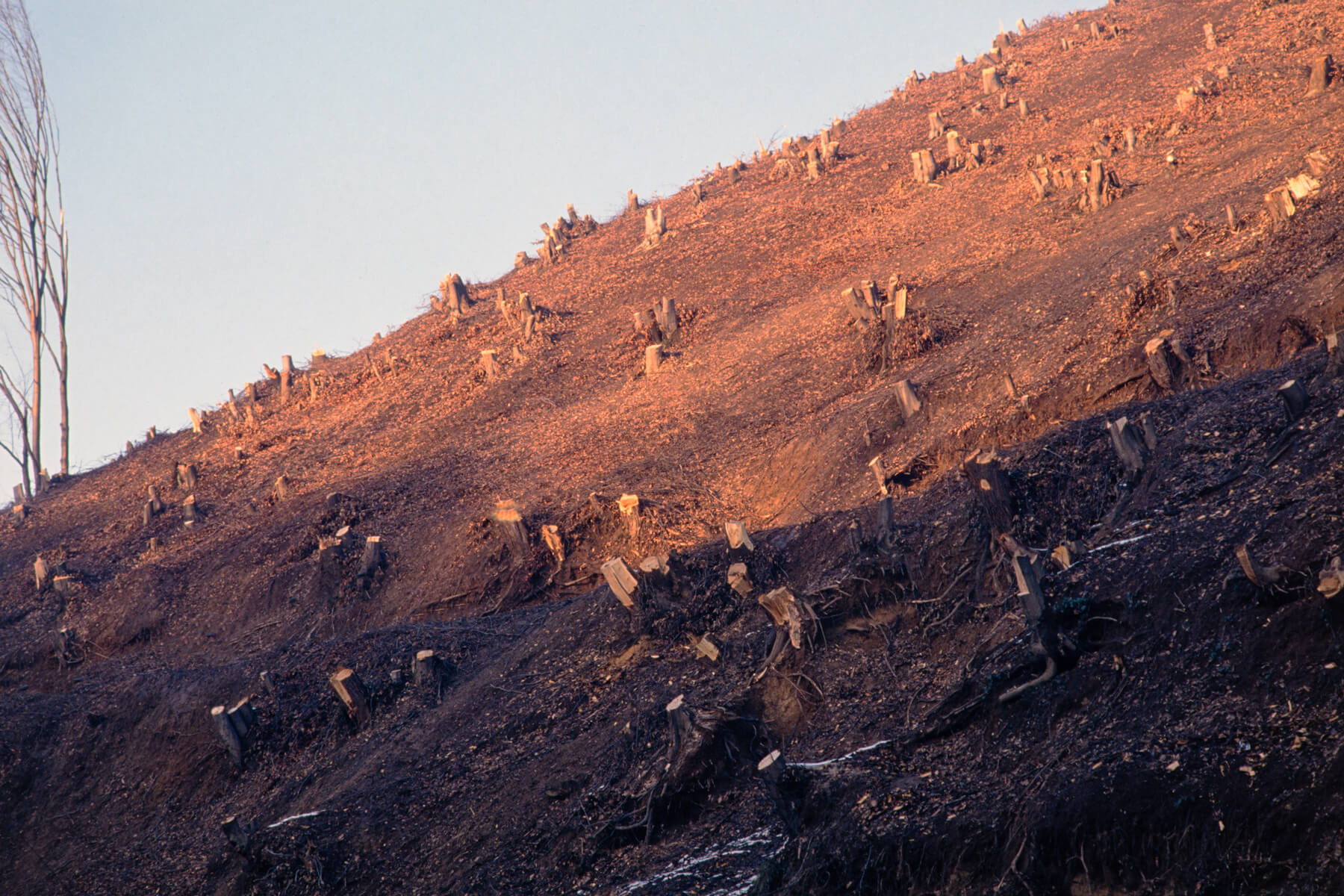
[BOS 16] Trees have been cut down for firewood on a hillside on the edge of Tuzla.
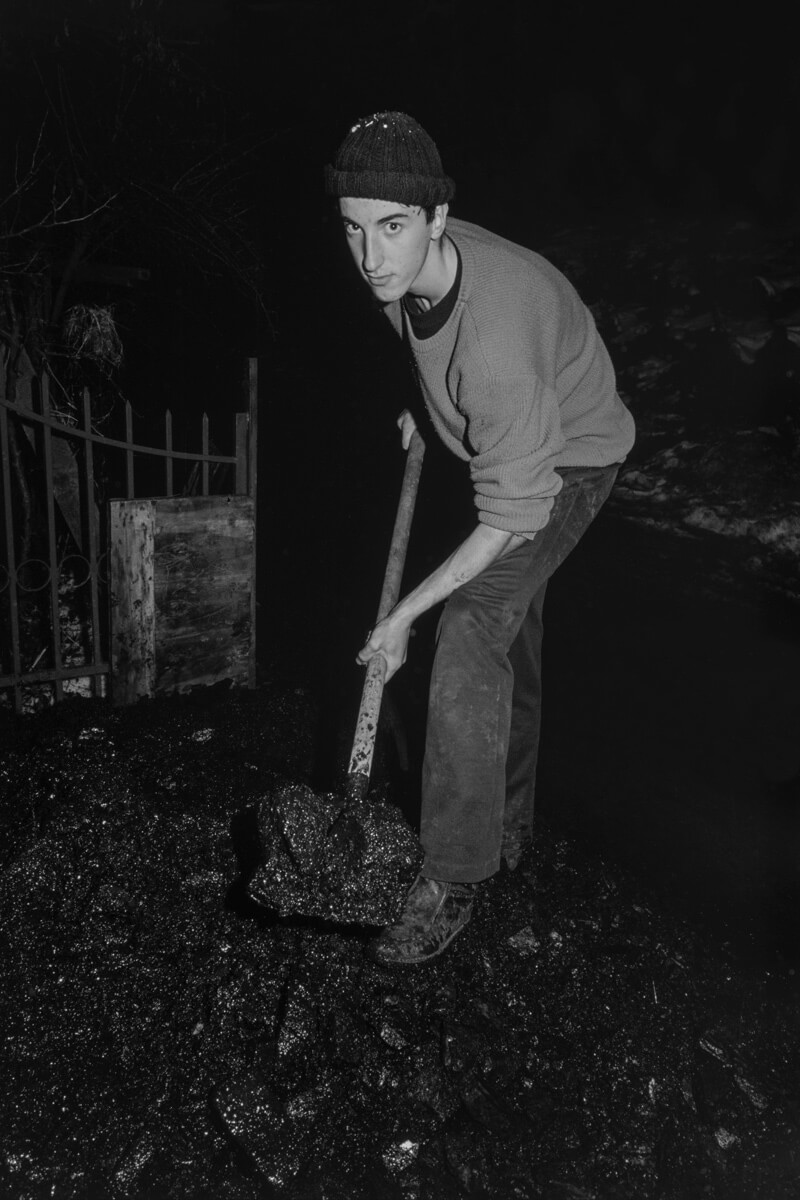
[BOS 17] Man shovels through wet coal looking for anything that is suitable to burn.
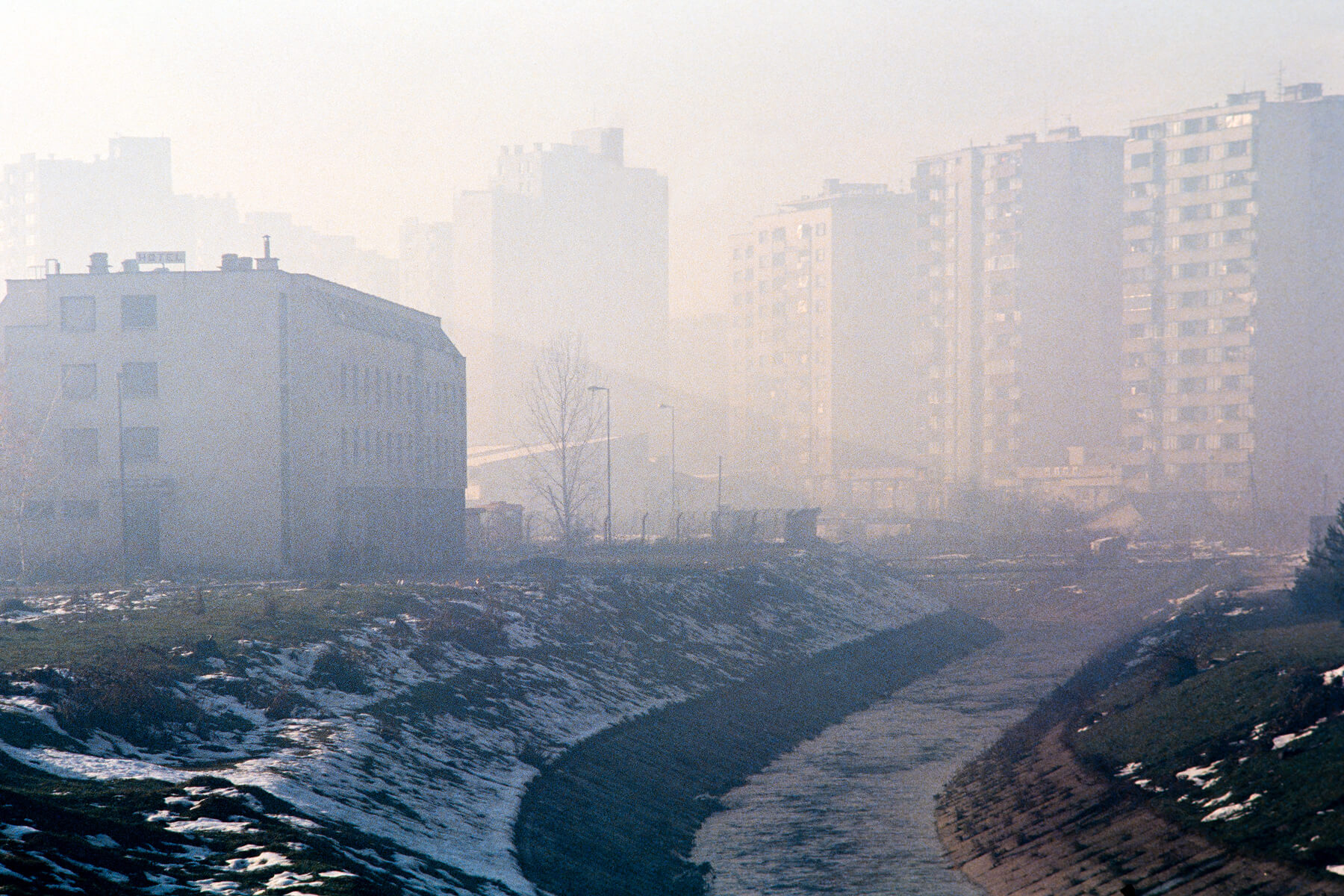
[BOS 18] Wood and coal smoke from domestic fires partly obscures the city at sunset. Photograph taken from the bridge at Irac overlooking the river Jala.
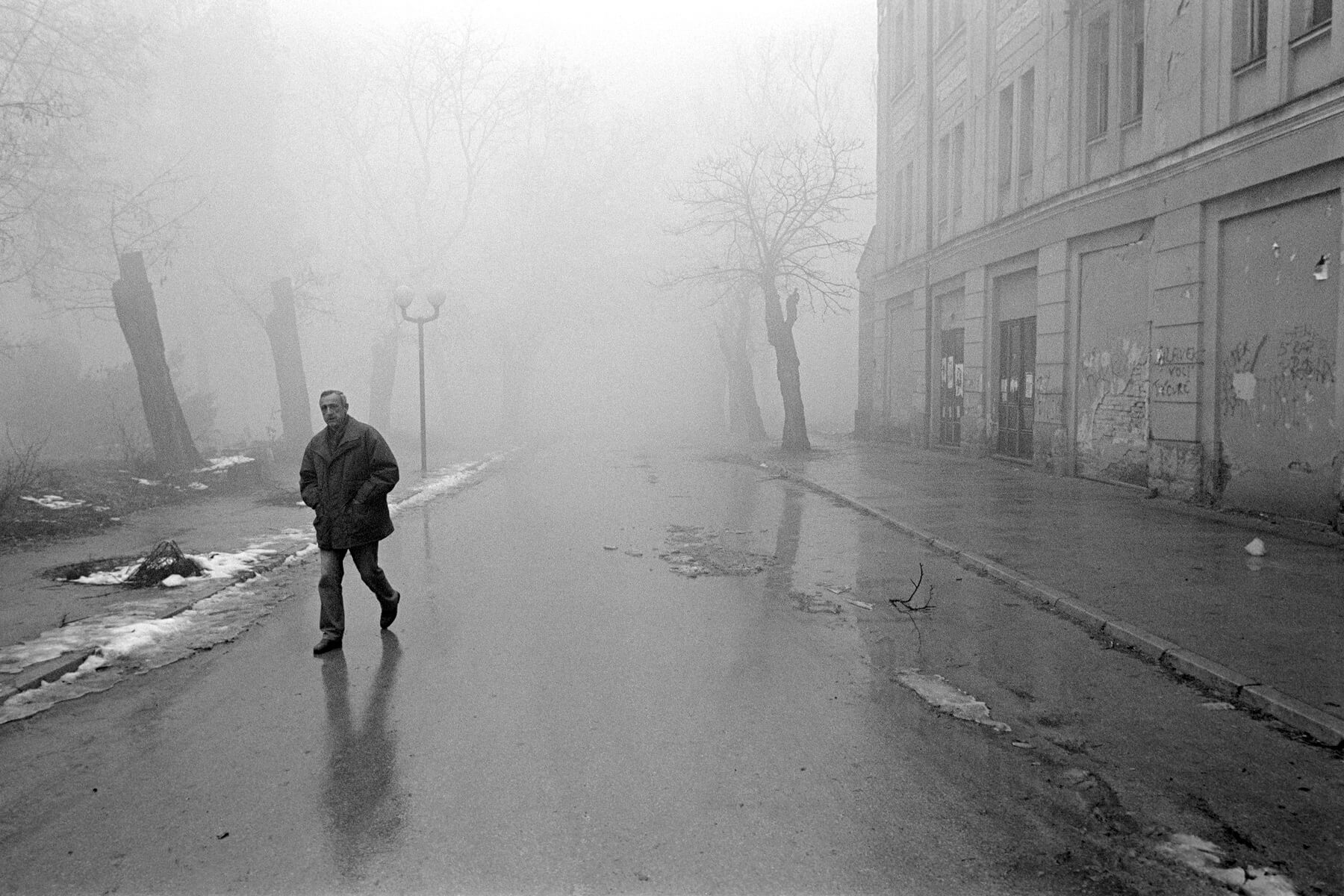
[BOS 19] With no cars or lorries, a man walks through the silent streets in the old city. This area contains historic buildings from the Austro-Hungarian period. Wood smoke and fog permeate the air. The tree tops (left) have been cut down and burnt for cooking and heating.
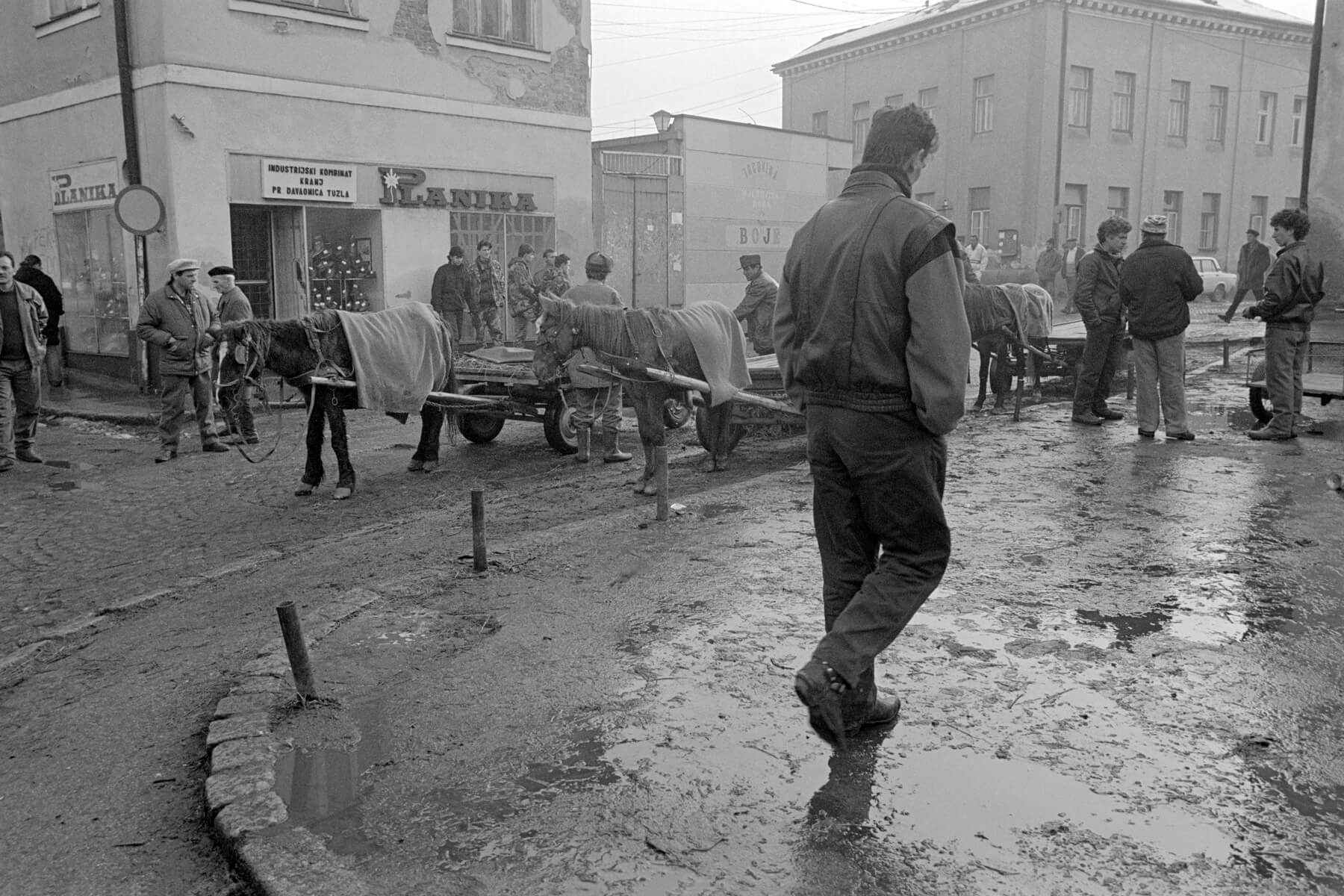
[BOS 20] Horse drawn wagons wait to haul goods from the Gradska Pijaca market place.

[BOS 21] Men drink wine and smoke in the market place at Gradska Pijaca, where used wood and coal burning cooking stoves are being sold and are in great demand.
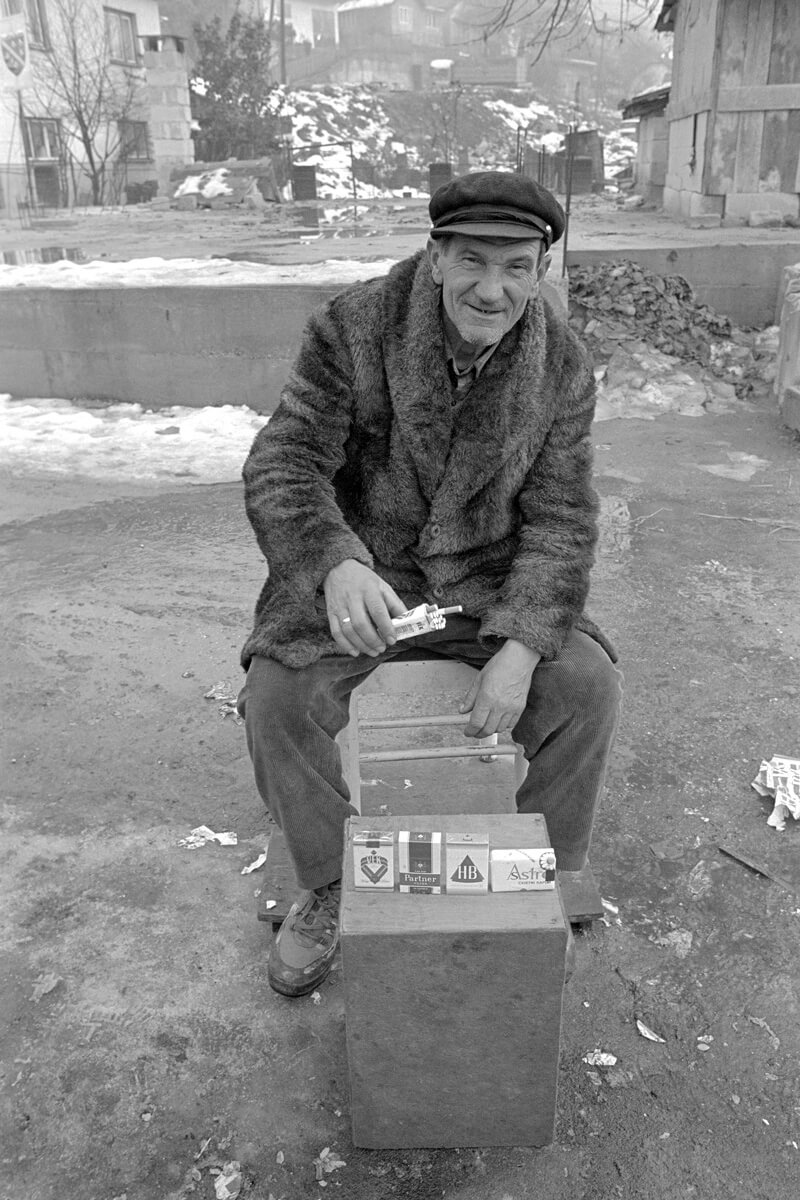
[BOS 22] Man selling single cigarettes, packets of cigarettes and soap from a box in the Mosnik district. Despite food and medical shortages, smuggled contraband cigarettes were easily available everywhere.
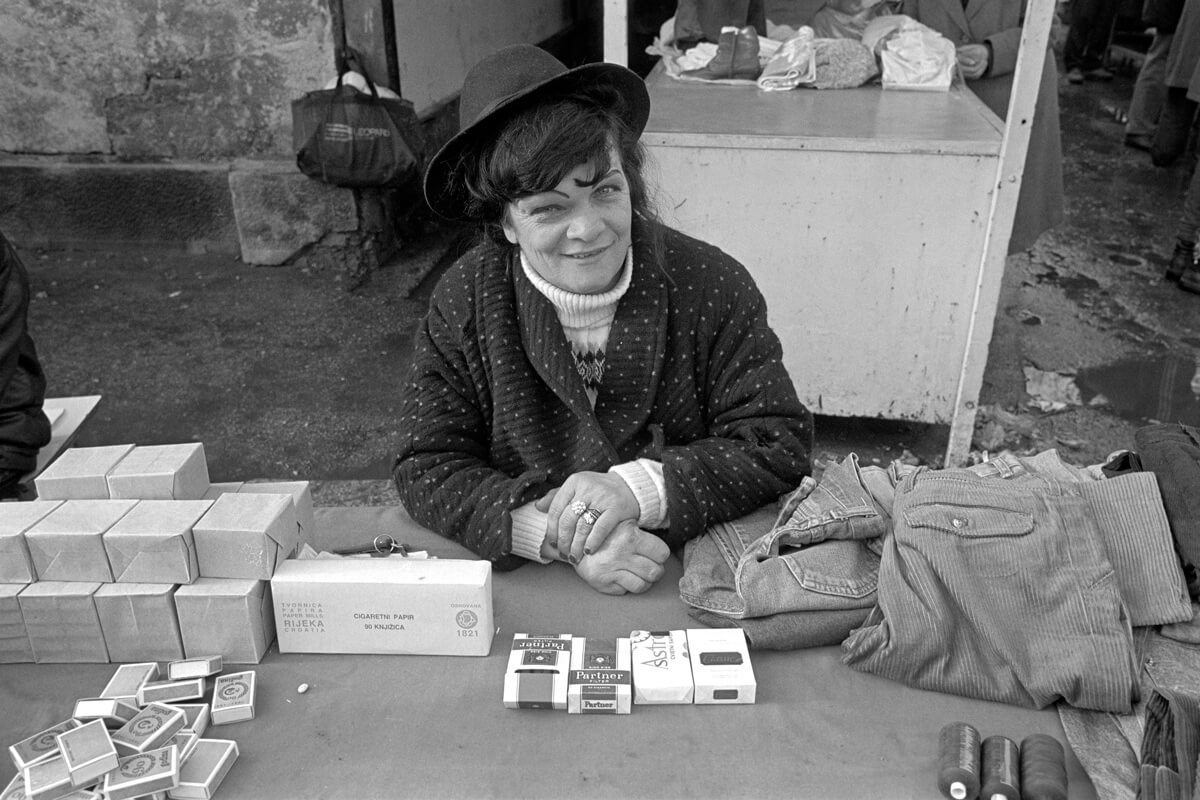
[BOS 23] Woman selling cigarettes, matches and secondhand clothing from a makeshift stall.
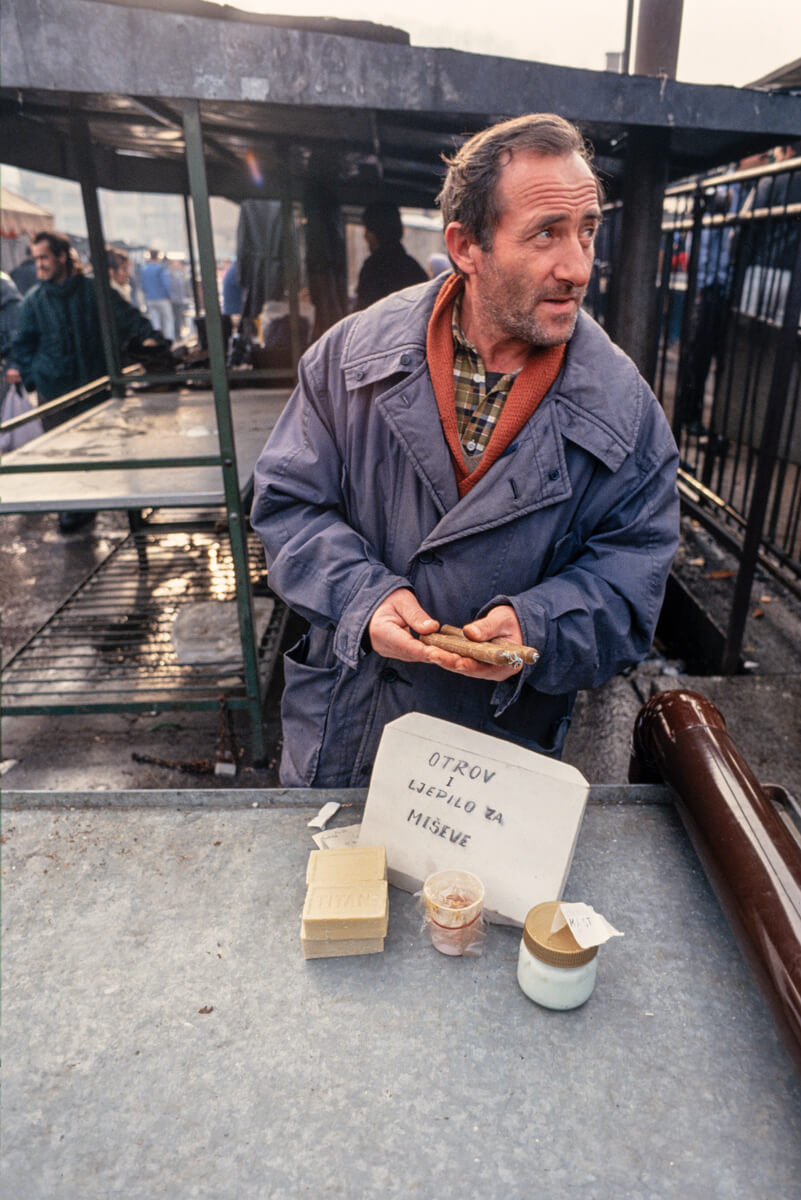
[BOS 24] Man selling mouse poison, mouse glue and soap in the Gradska Pijaca market place. As the collection of household waste has been curtailed the rodent population has multiplied causing infestations throughout the city.
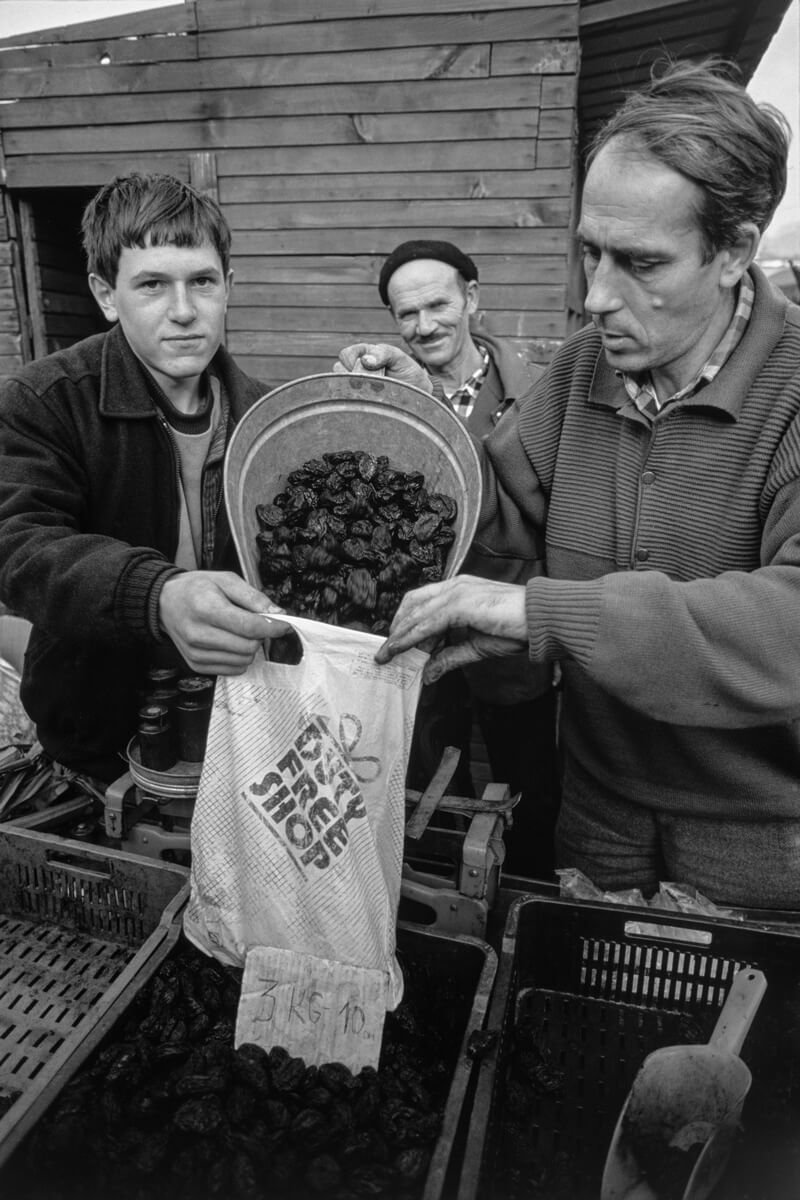
[BOS 25] Weighing out prunes (preserved dried plums) at a market place stall. They were harvested during the previous autumn.
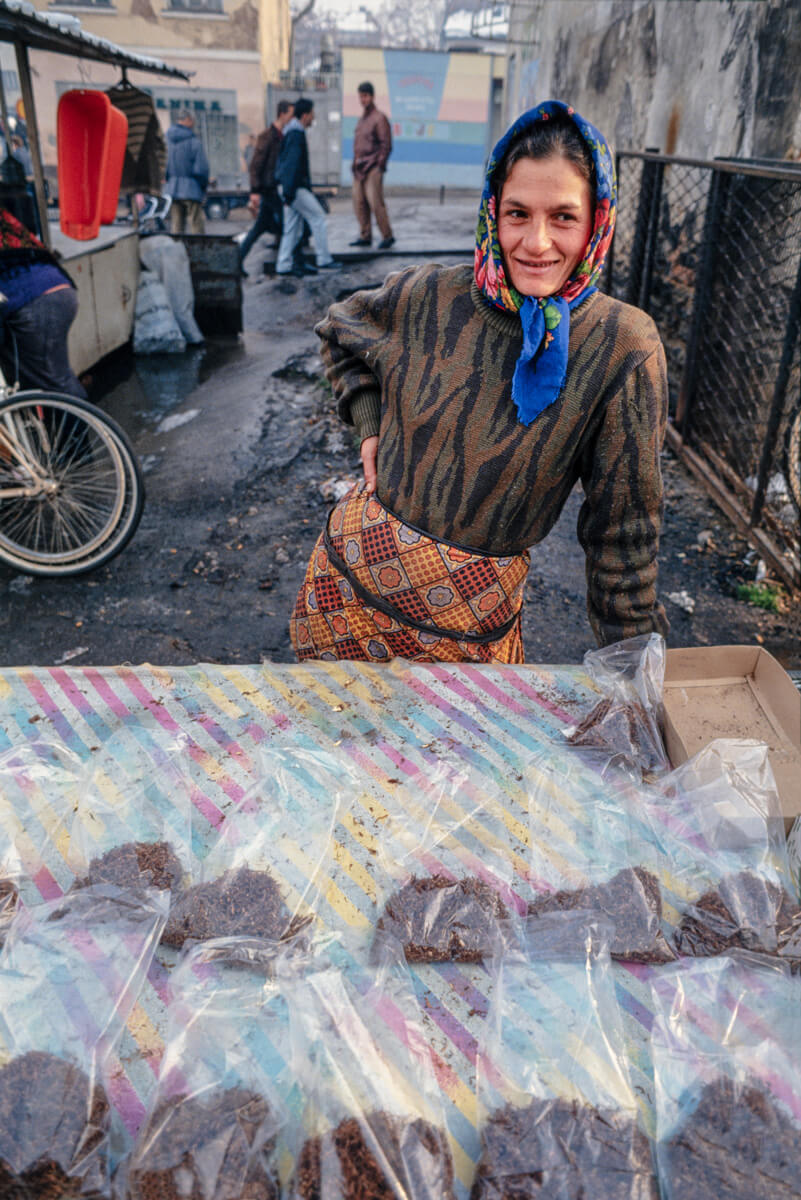
[BOS 26] Woman selling tobacco in the market place.
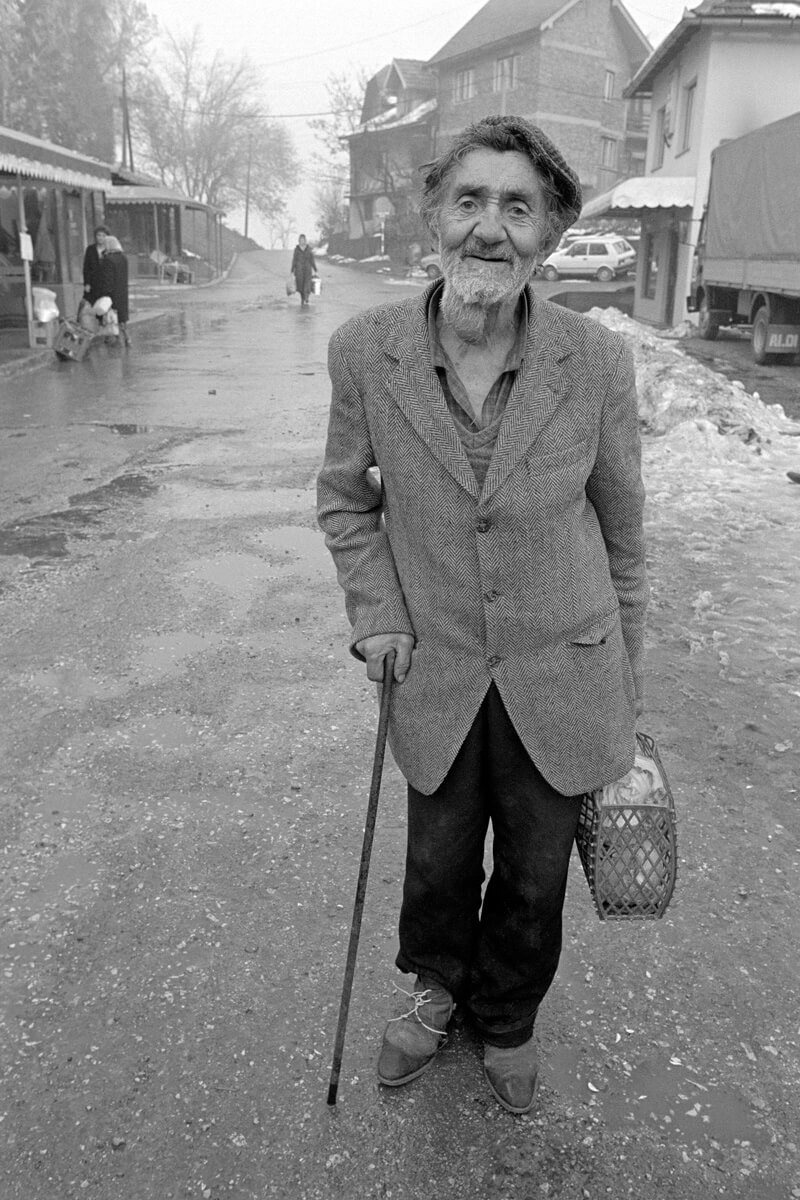
[BOS 27] Elderly man with neck goitre returns home through the Mosnik district from the market with the only food that is available and can afford, a cabbage.
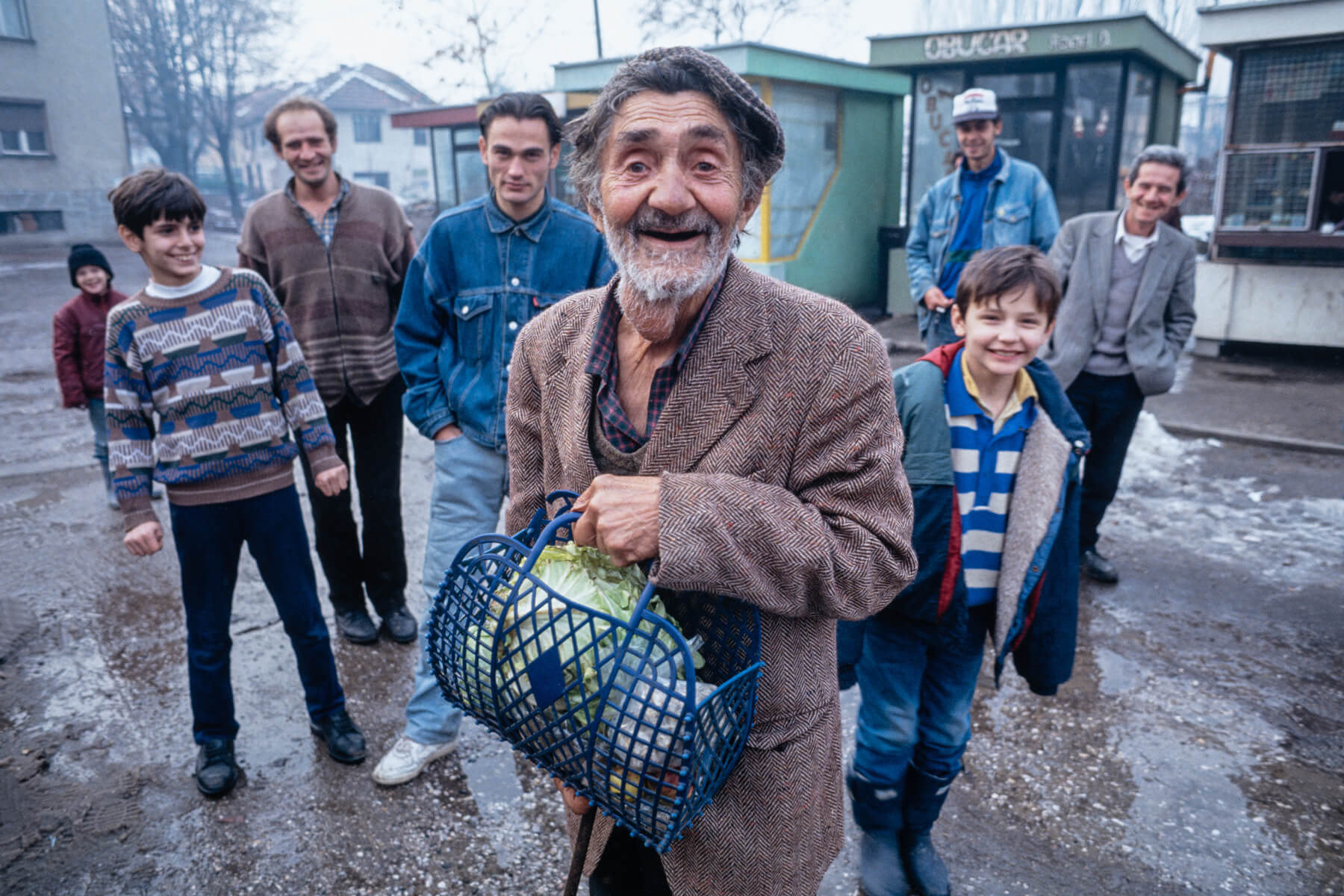
[BOS 28] The man (and others) make a joke with me.
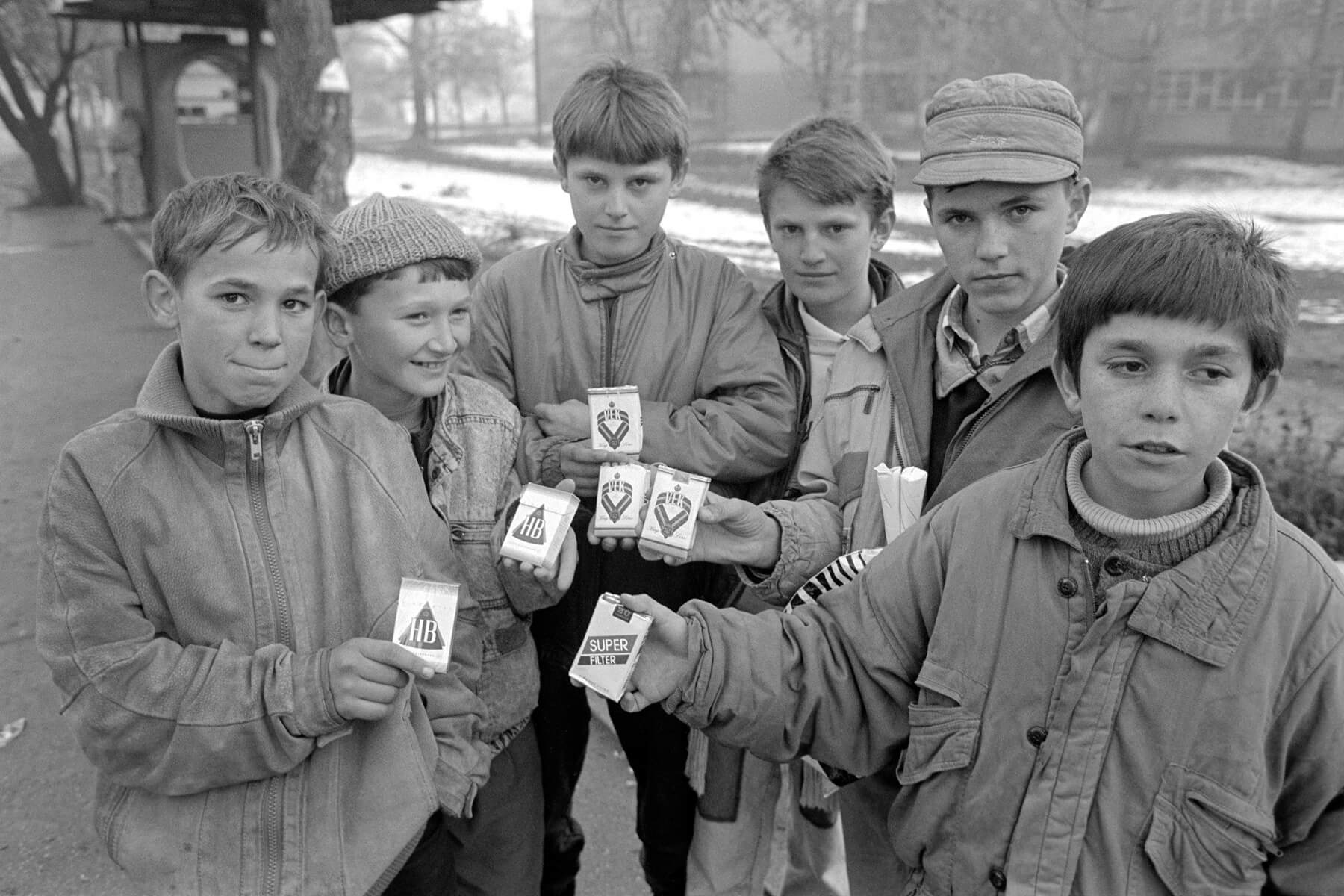
[BOS 29] Boys try to make a little extra money for themselves and their families selling smuggled cigarettes near the UNHCR office.
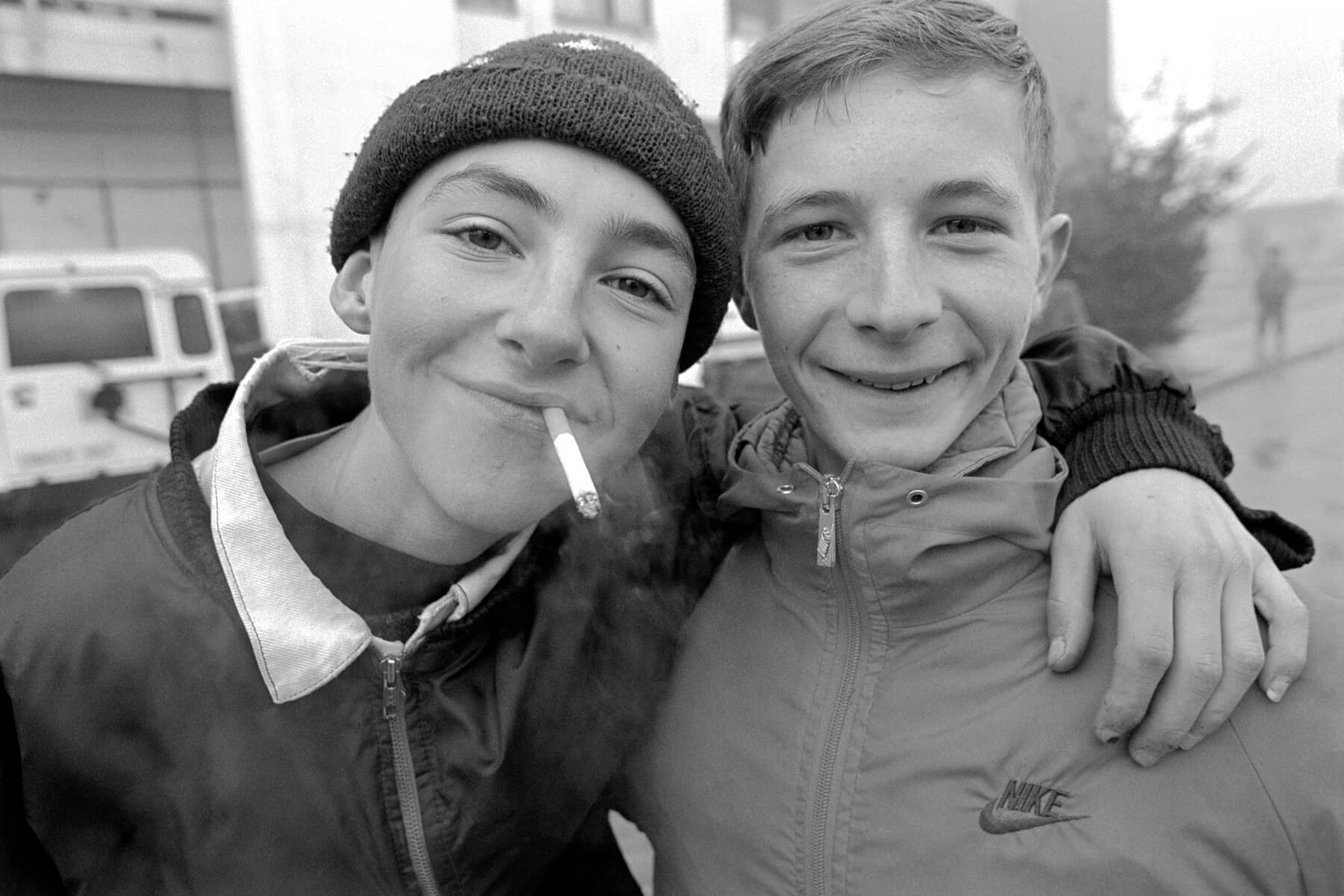
[BOS 30] Boys wander the streets getting into mischief.

[BOS 31] Intoxicated man wanders around the streets near the stadium at Batva asking for alcohol and cigarettes.
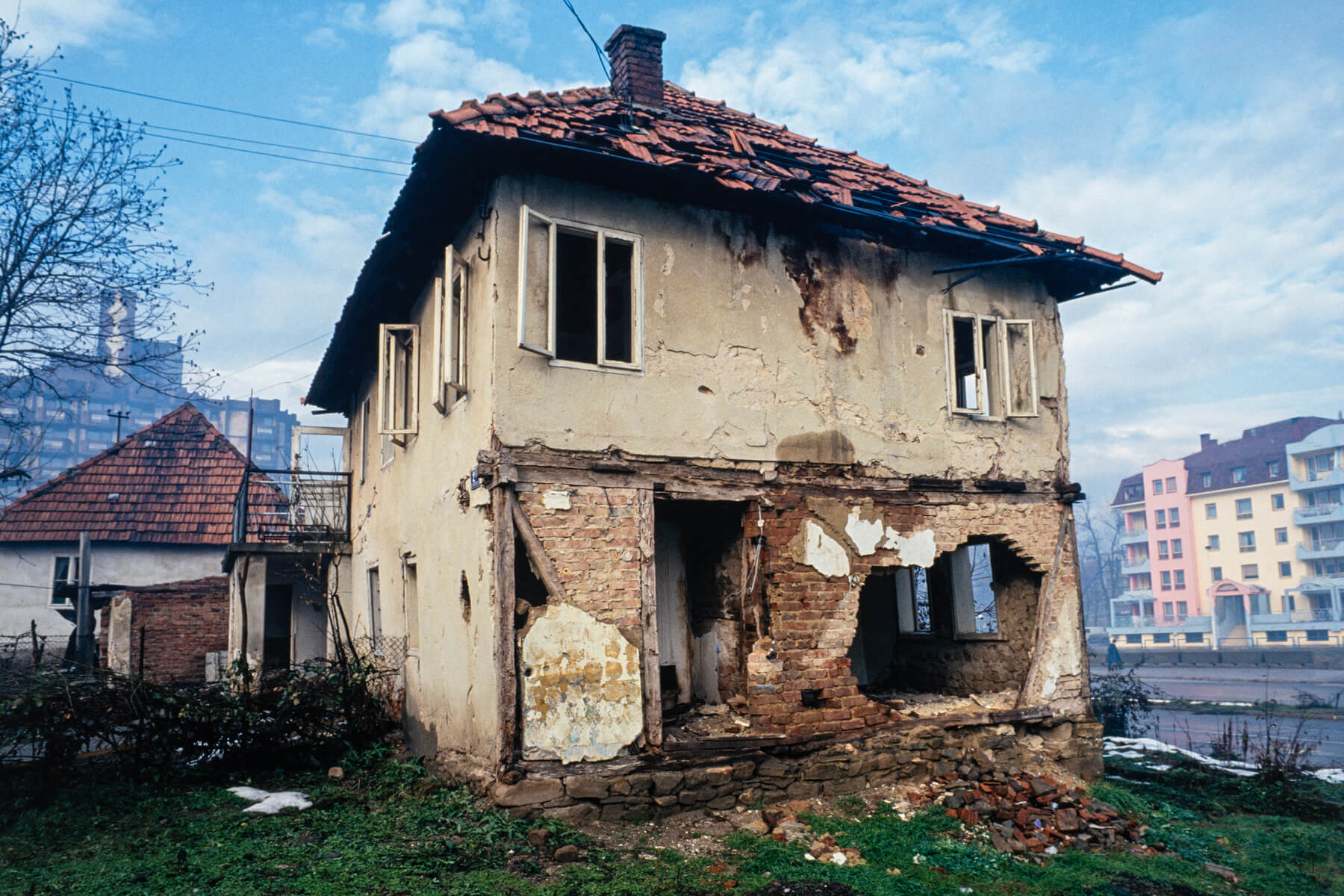
[BOS 32] A house recently destroyed by a Serbian artillery shell fired from 9km away.
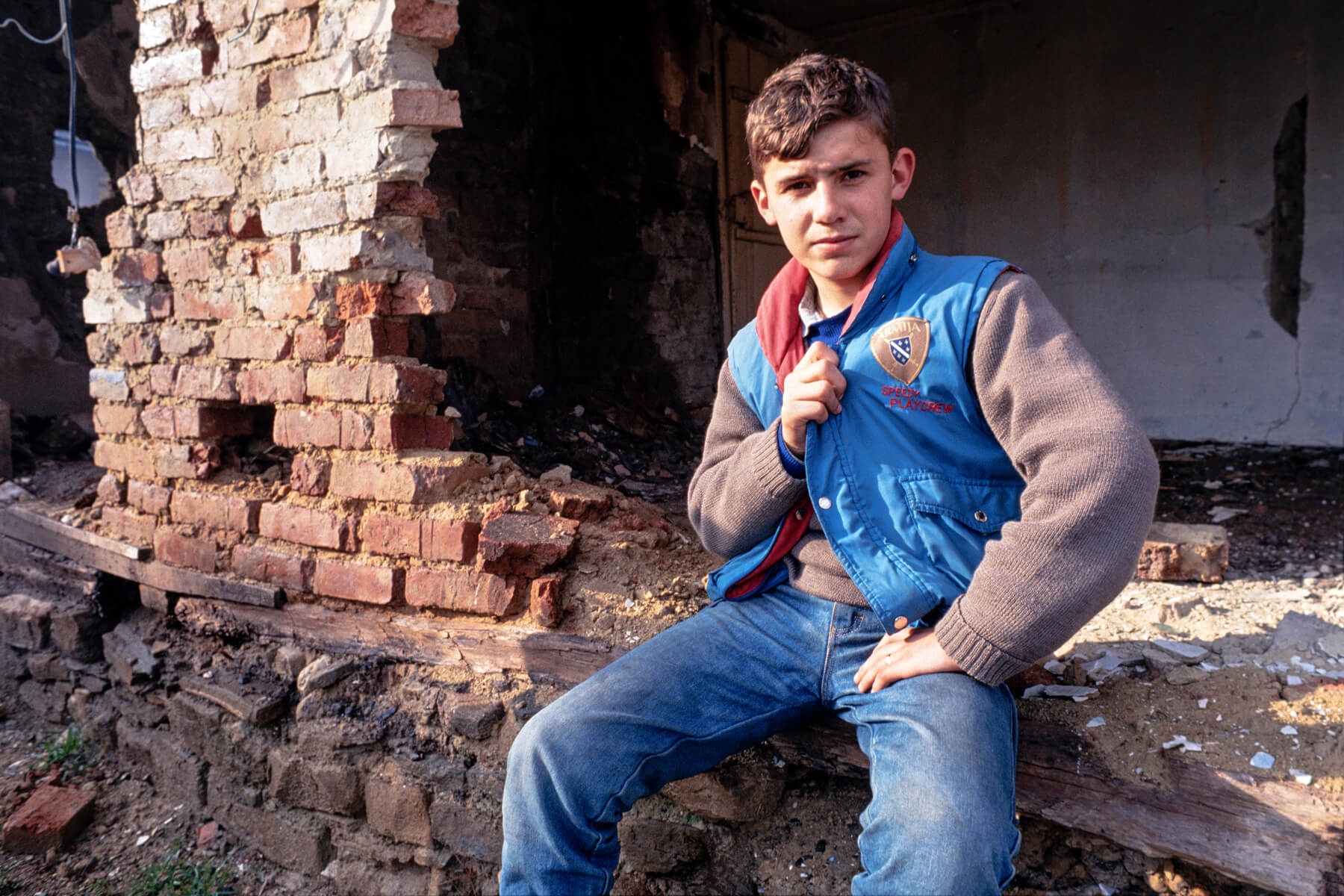
[BOS 33] Boy sits in the ruins of a house in the district of Kula near the city centre, destroyed by a Serbian artillery shell earlier that week. His badge says ARMIJ which is the Army of the Republic of Bosnia and Herzegovina, also known as the Bosnian Army or Bosniak Army. He says he will join the army as soon as he is old enough.
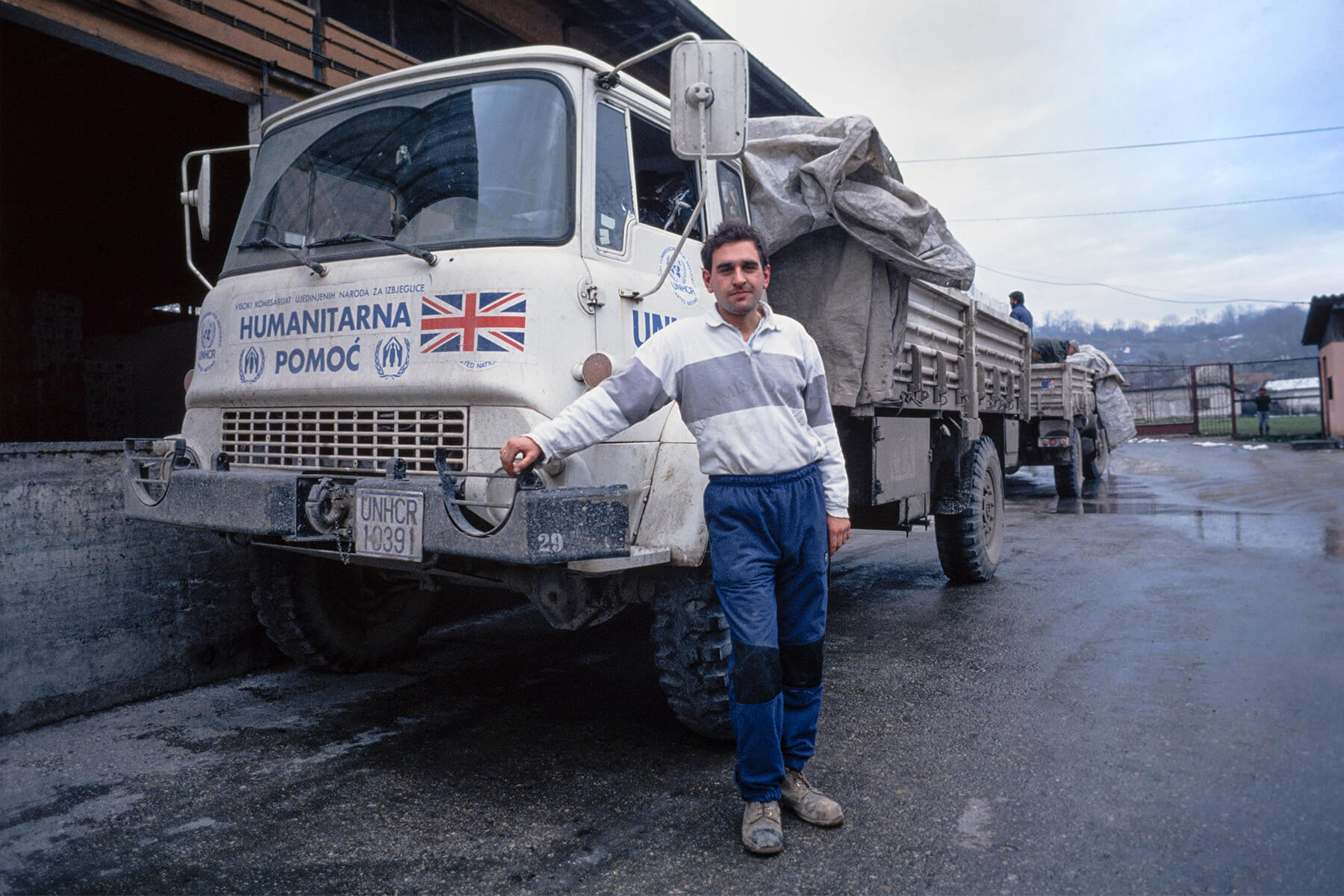
[BOS 34] Terry Hopper is a UNHCR convoy driver from Cambridgeshire, UK. He has been a driver for 6 months. He said that at first he started driving for the money but now it’s for humanitarian reasons. He says, “The drivers ease the stress of each day by talking about their often dangerous journey with each other… we are called The Tuzla Nomads”. A particularly risky section of the road to Tuzla is nicknamed Bomb Alley as UN convoys are frequently attacked along it.
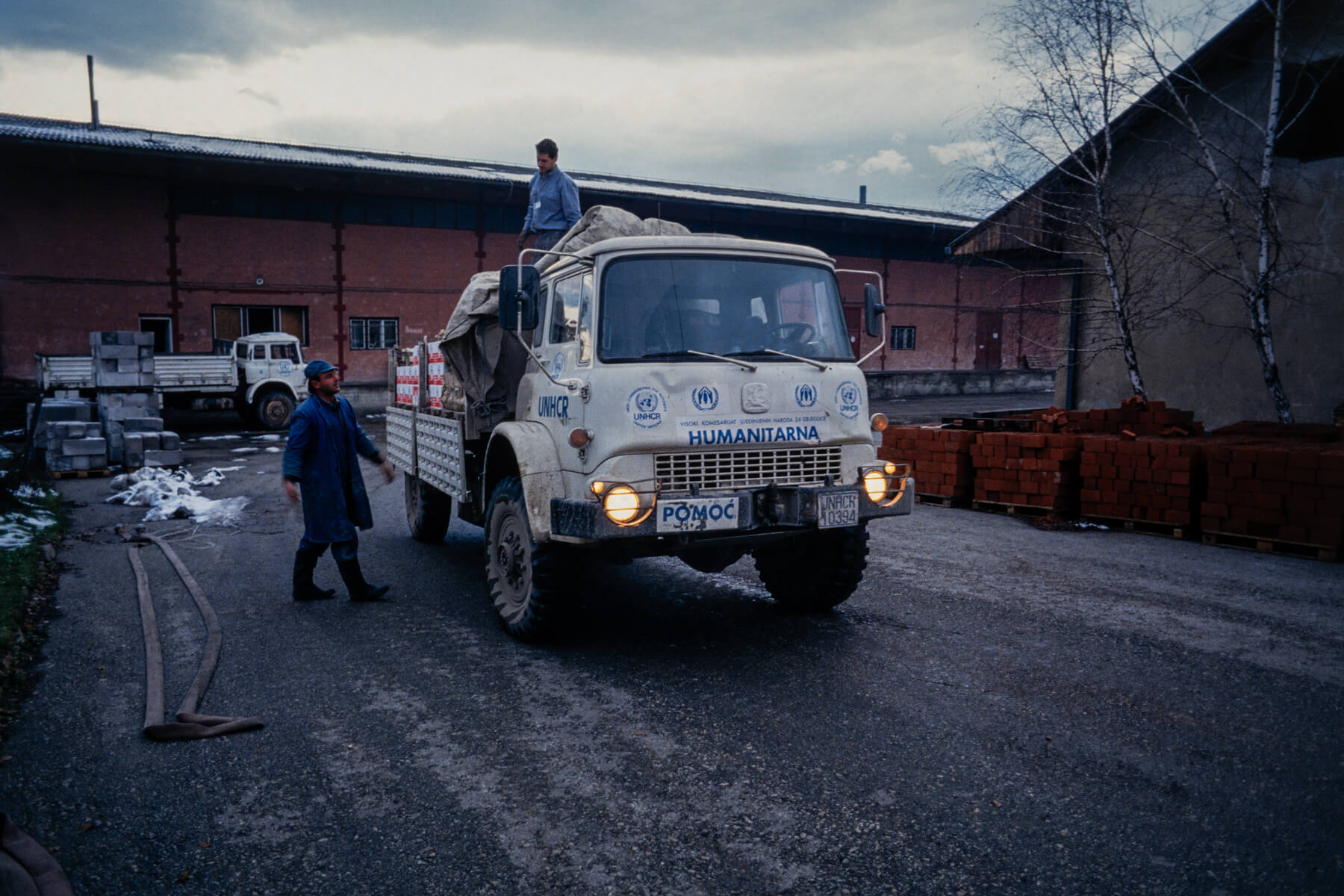
[BOS 35] A newly arrived UNHCR convoy lorry is quickly unloaded at a secure UN storage depot, before the 7pm curfew.
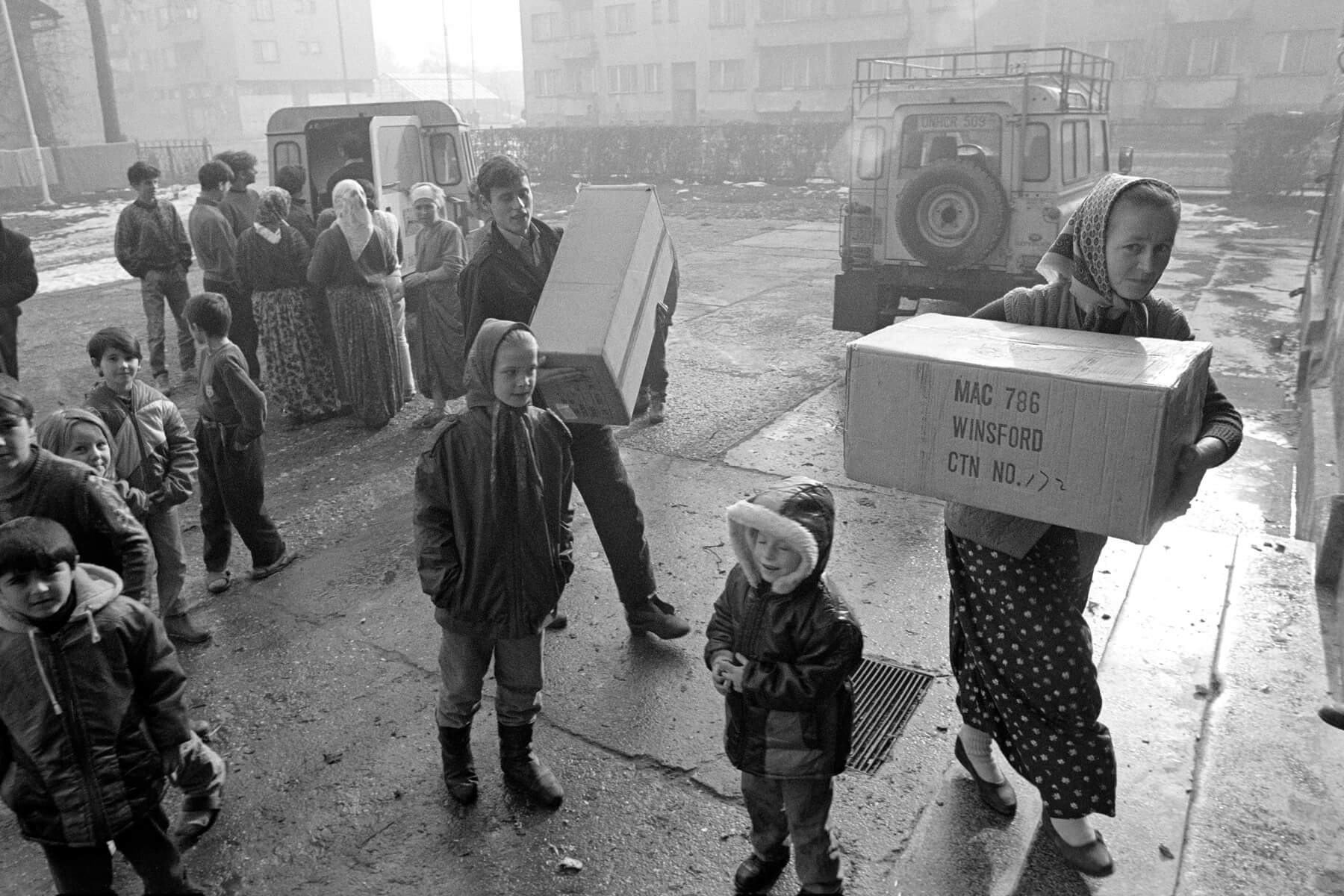
[BOS 36] Winter clothing and shoes being unloaded from the Oxfam Land Rovers by young men and women volunteers into a secure distribution centre.
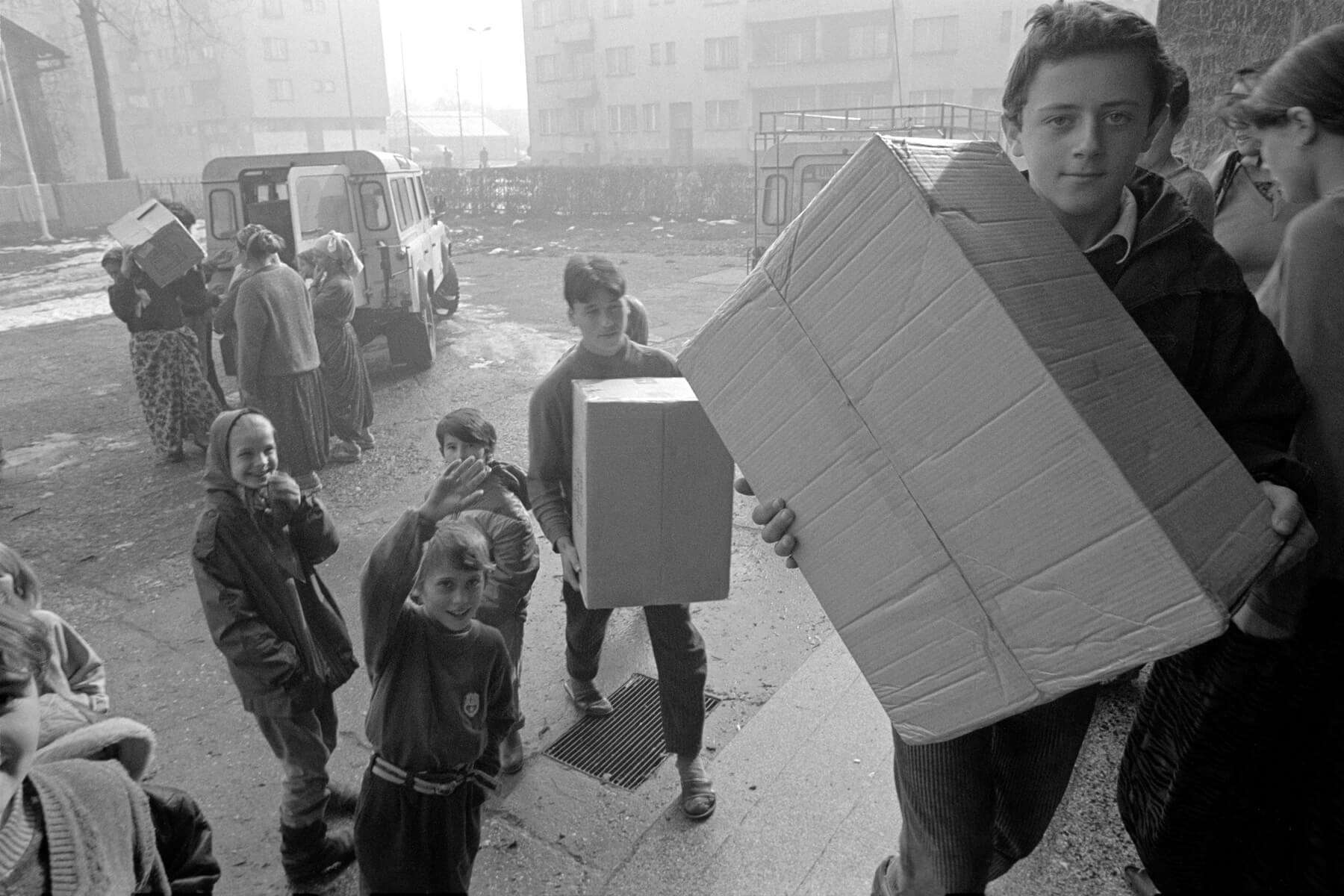
[BOS 37] Winter clothing and shoes being unloaded from Oxfam Land Rovers by young men and women volunteers into a secure distribution centre.
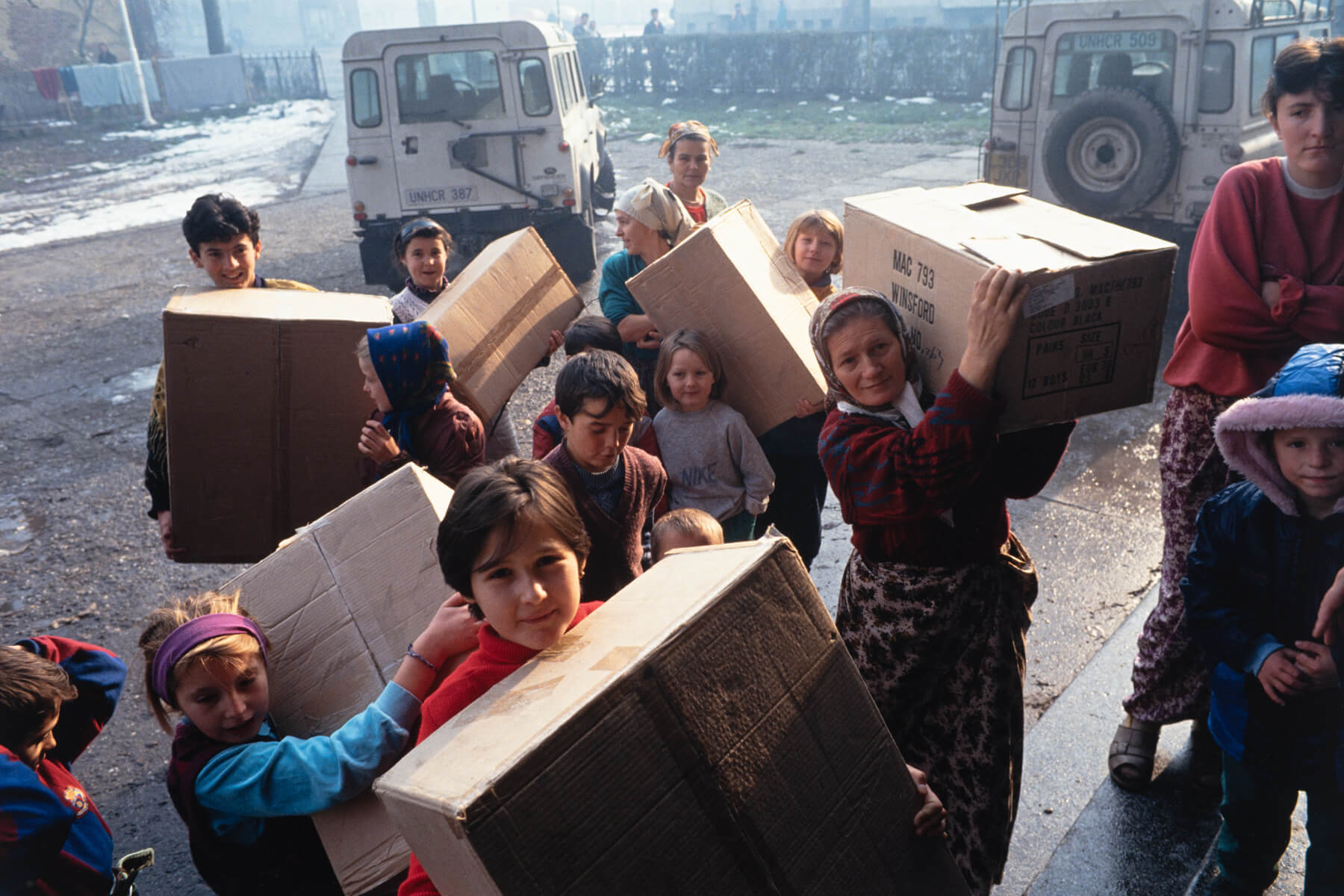
[BOS 38] Winter clothing and shoes being unloaded from Oxfam Land Rovers by women and children volunteers into a secure distribution centre.

[BOS 39] EC humanitarian aid being unloaded from a recently arrived UNHCR convoy at Lukavac.
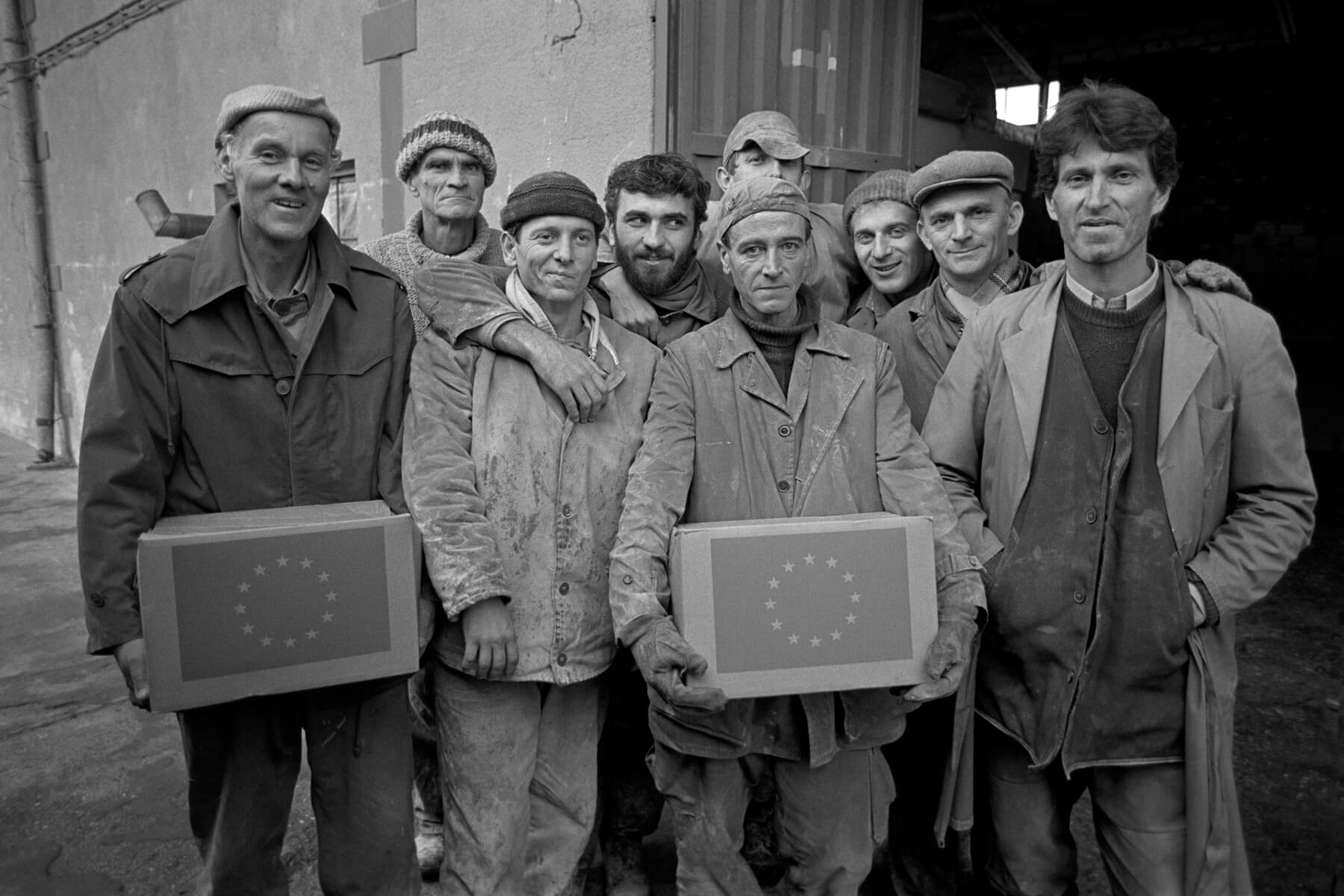
[BOS 40] Warehousemen at the UNHCR aid storage depot, Lukavac.
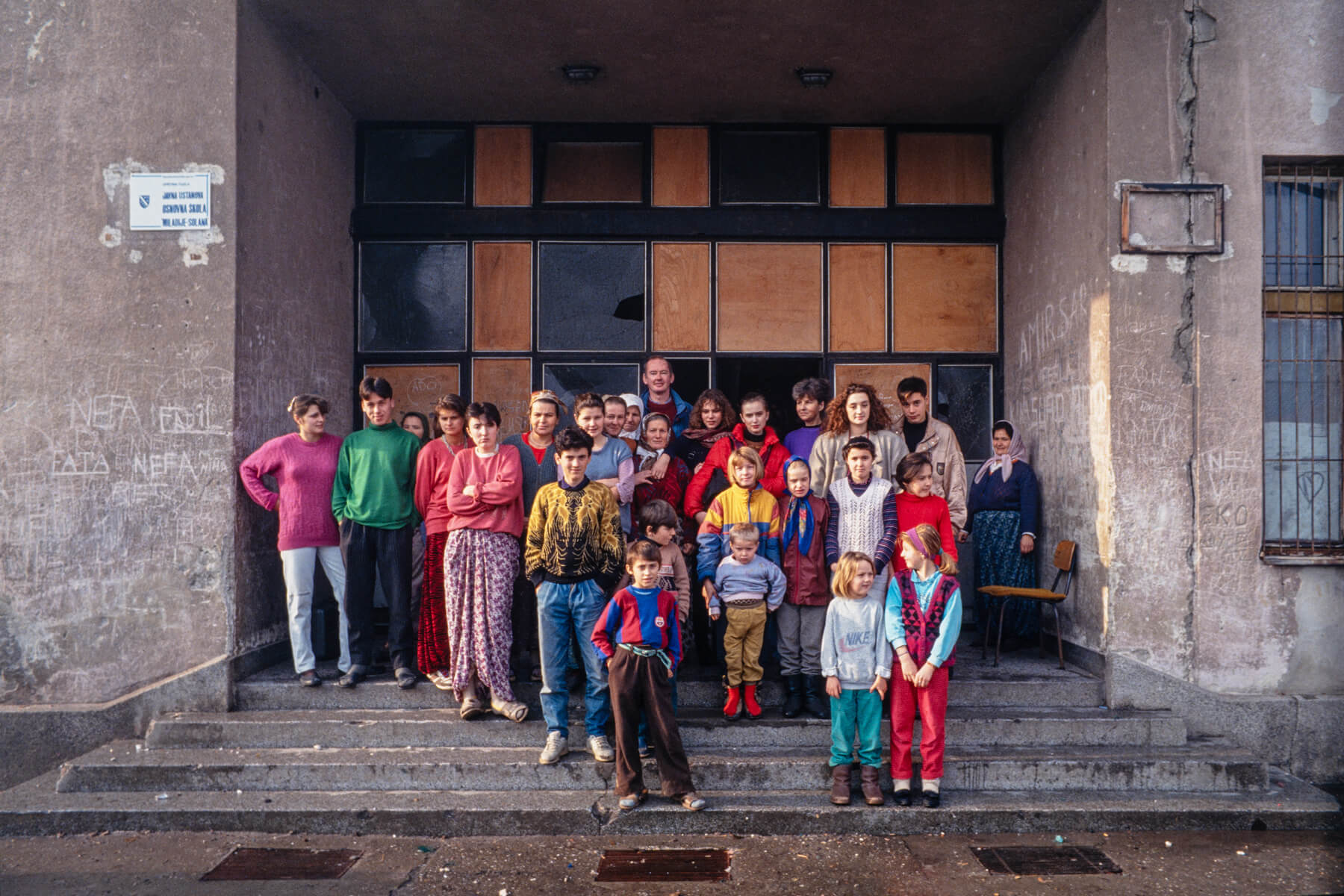
[BOS 41] Refugees and Oxfam staff outside the District School of Solana. This primary school is now a refugee centre for displaced people who have been ethically cleansed from their villages and the surrounding areas.
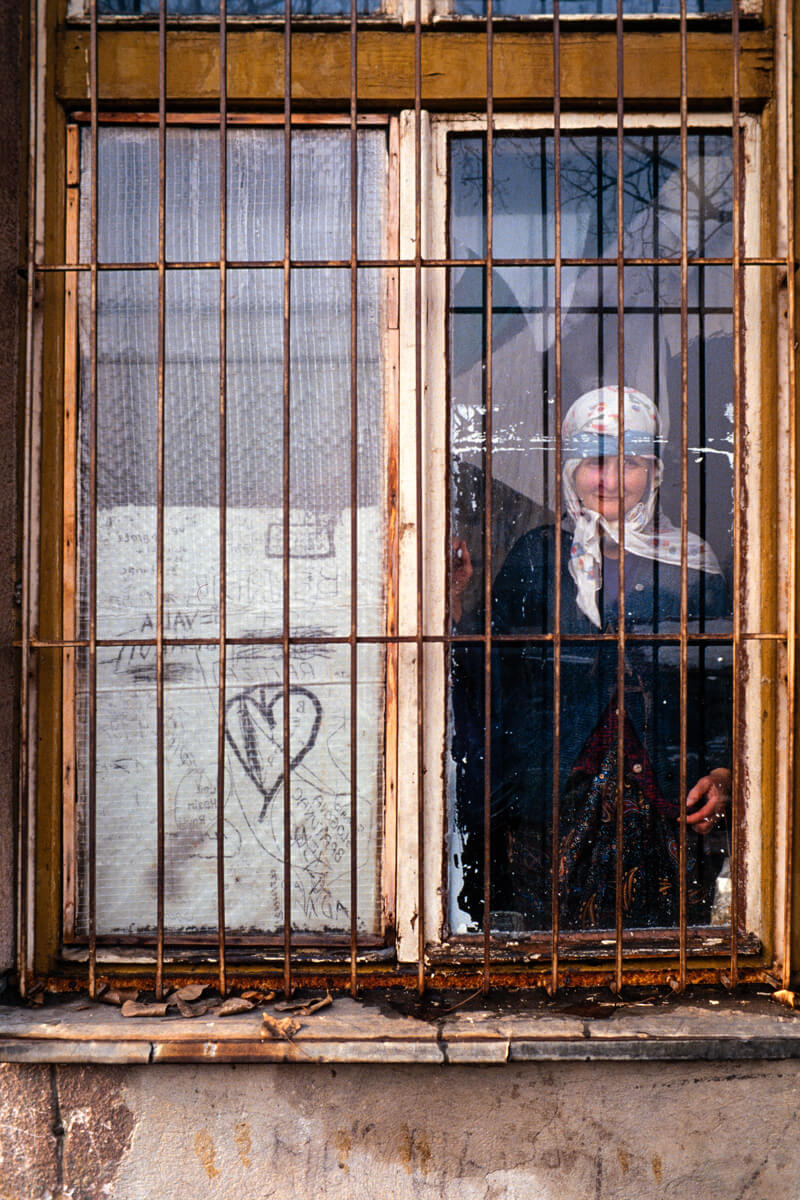
[BOS 42] Refugee looks out from the school.
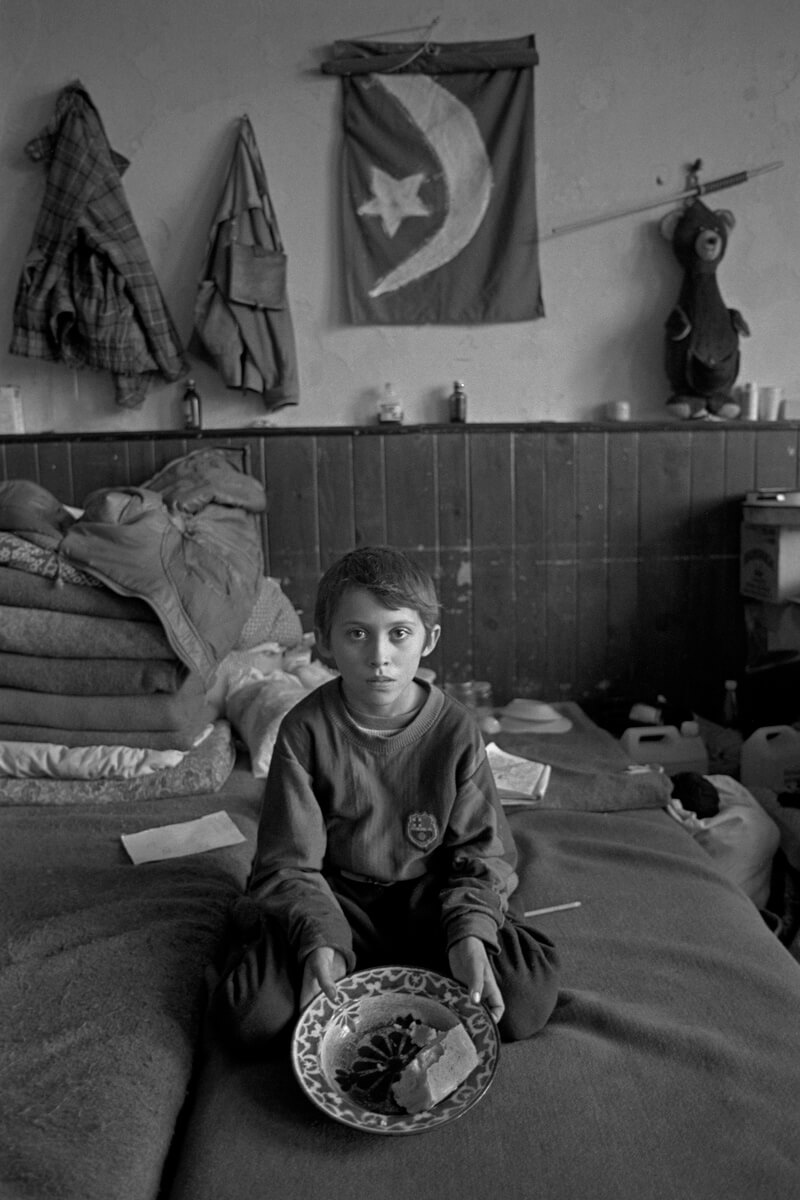
[BOS 43] Boy in a school classroom which is now used as a dormitory, he receives just bread for his midday meal.
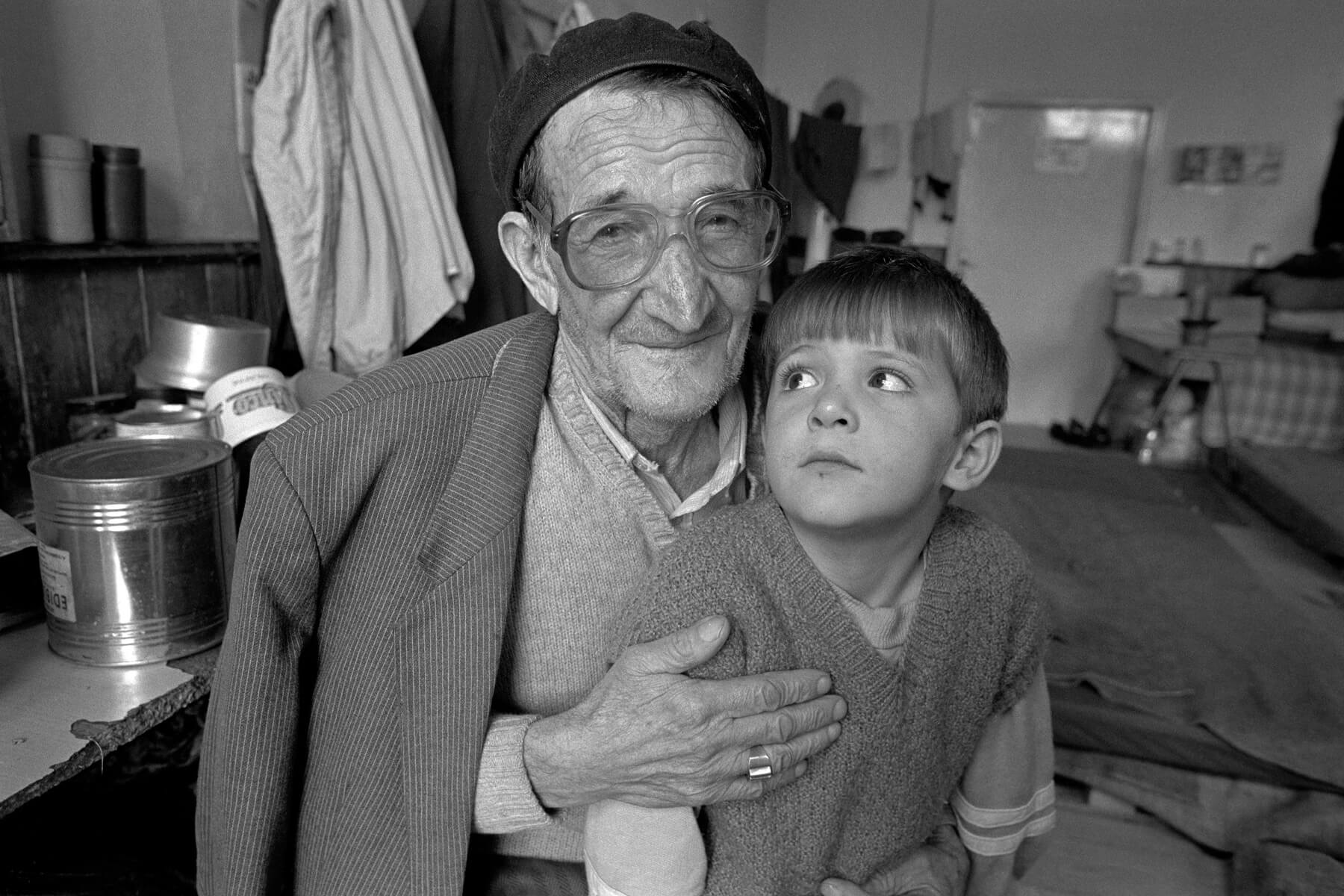
[BOS 44] Elderly man and his grandson at the school.
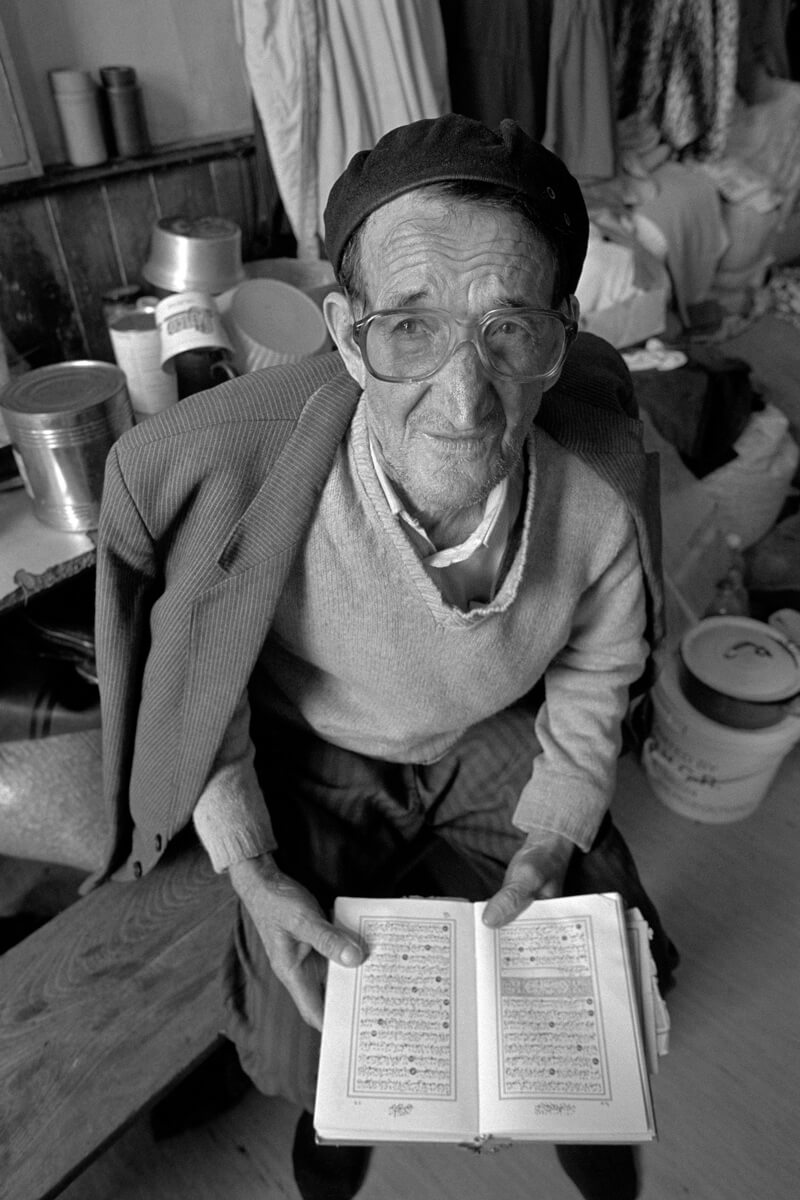
[BOS 45] He finds a quiet place to read the Qur’an.
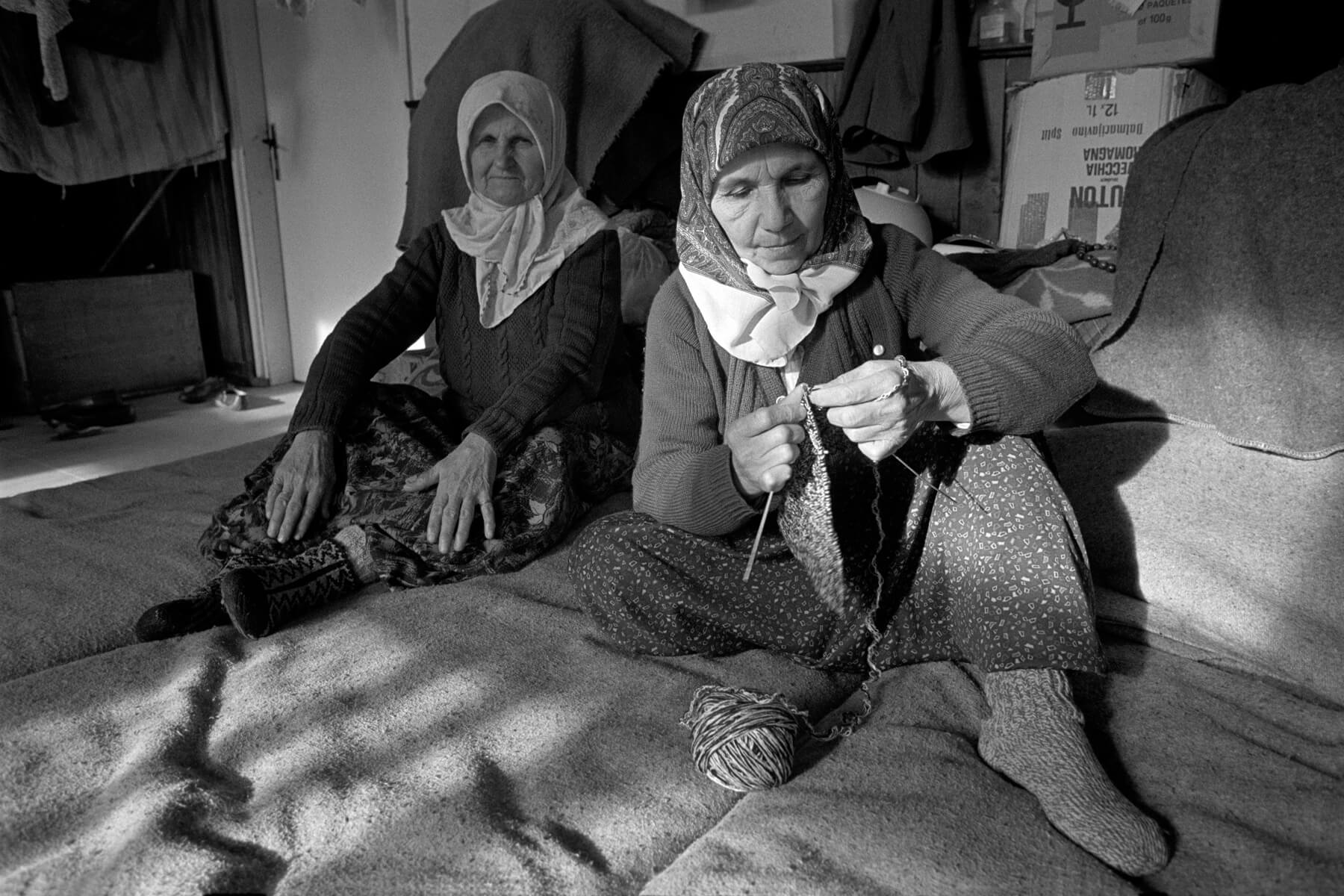
[BOS 46] Women knitting winter clothing at the school with wool supplied by Oxfam.
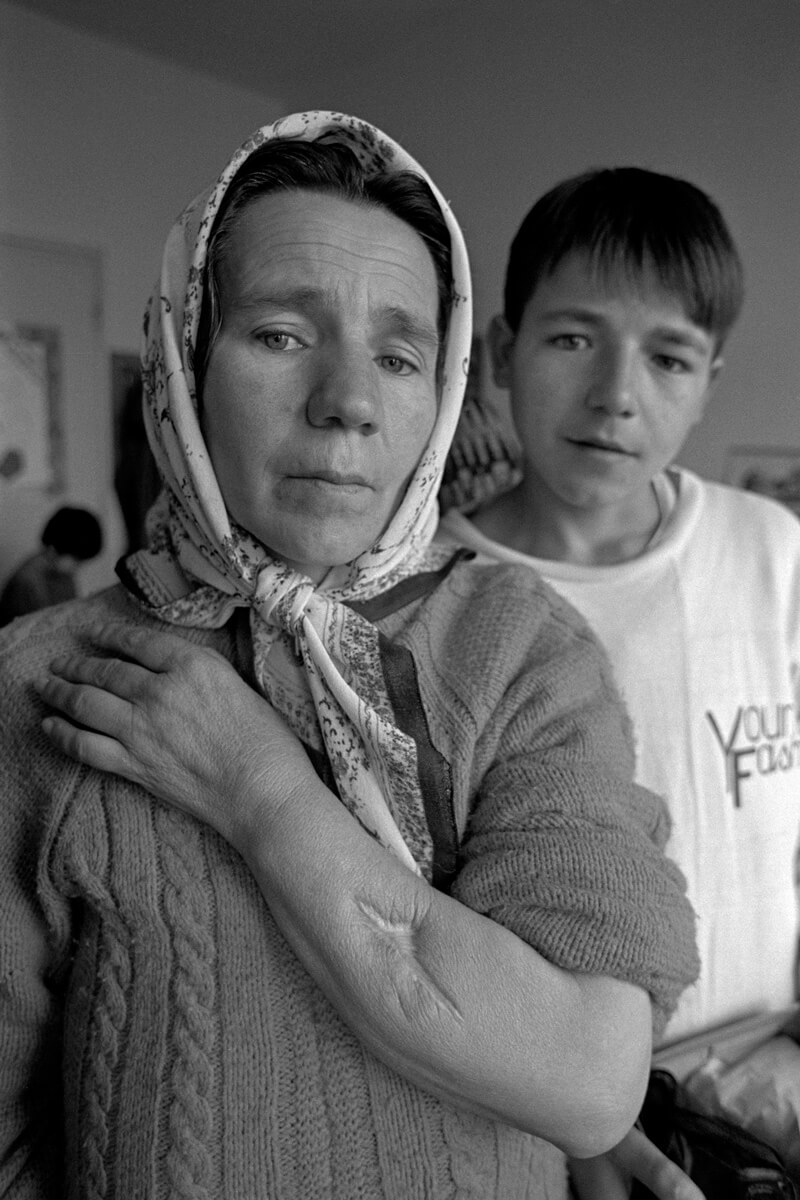
[BOS 47] This woman (age 43) and her son (age 14) are from a village near Srebrenica , she made this statement:
“I was wounded during a Serbian attack on my village and with the help of my brother was dragged to safety and evacuated to Tuzla by helicopter. I was able to survive and escape from the initial Serbian attack due to a strong counter-attack made by the Bosnian Muslim Army which briefly retook the village. The village was later retaken and is now back under Serbian control, however my husband and my other children are still trapped in the village.
We do not have shoes for the winter and do not have enough to eat. Our life is hard as a refugee, we have no money, job or relatives nearby and are completely dependant on humanitarian aid”.
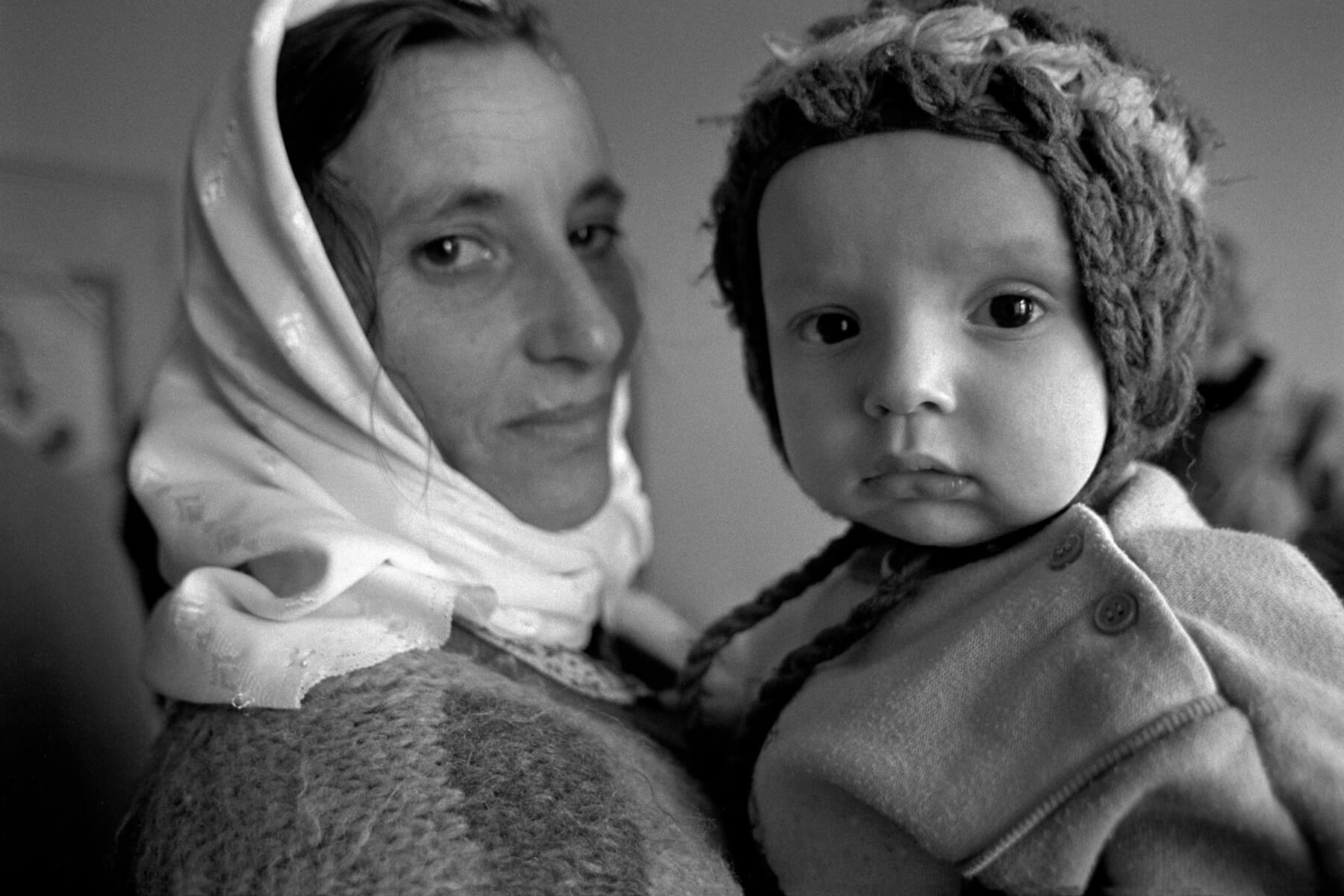
[BOS 48] Refugee mother and her child from the school. This photograph was used to promote Oxfam’s Cold Front Appeal in 1994. It was used prominently in full page nation newspaper advertisements to raise awareness to the plight of Bosnian Muslims who are facing extreme hardship during the coming winter months.
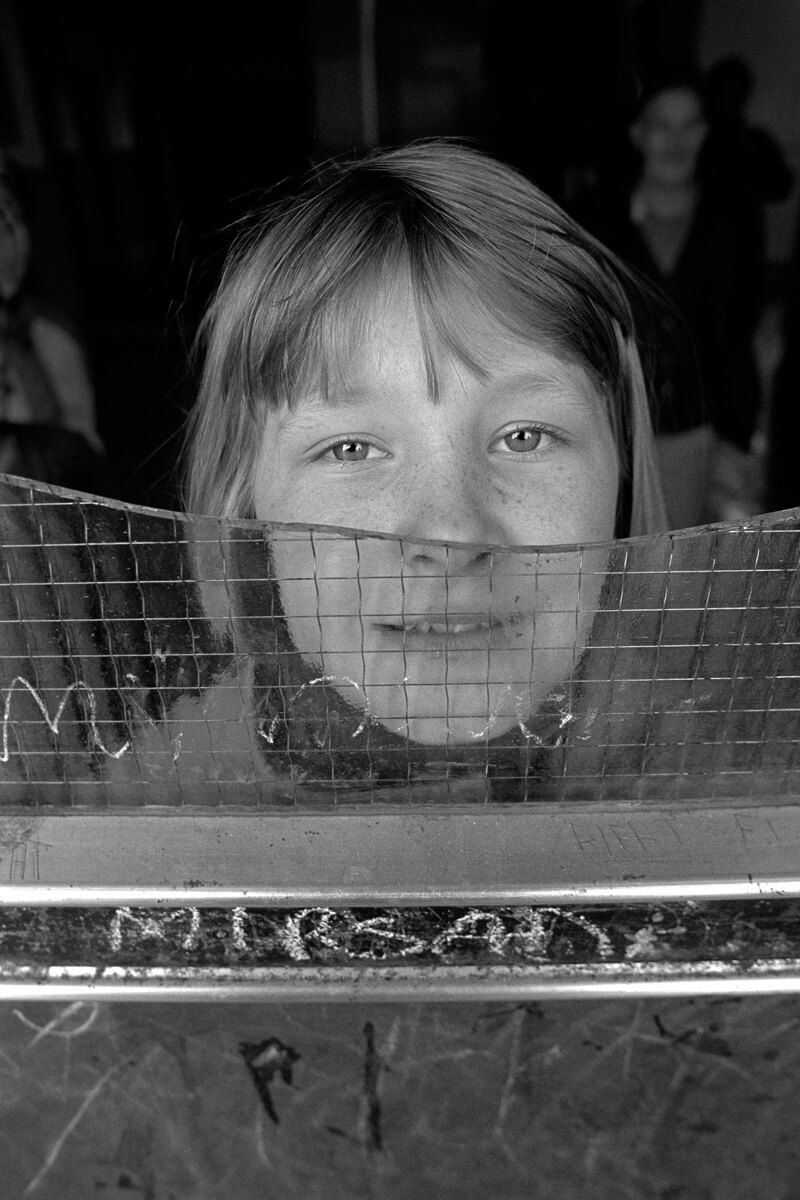
[BOS 49] Girl looks out over a broken window at the school.
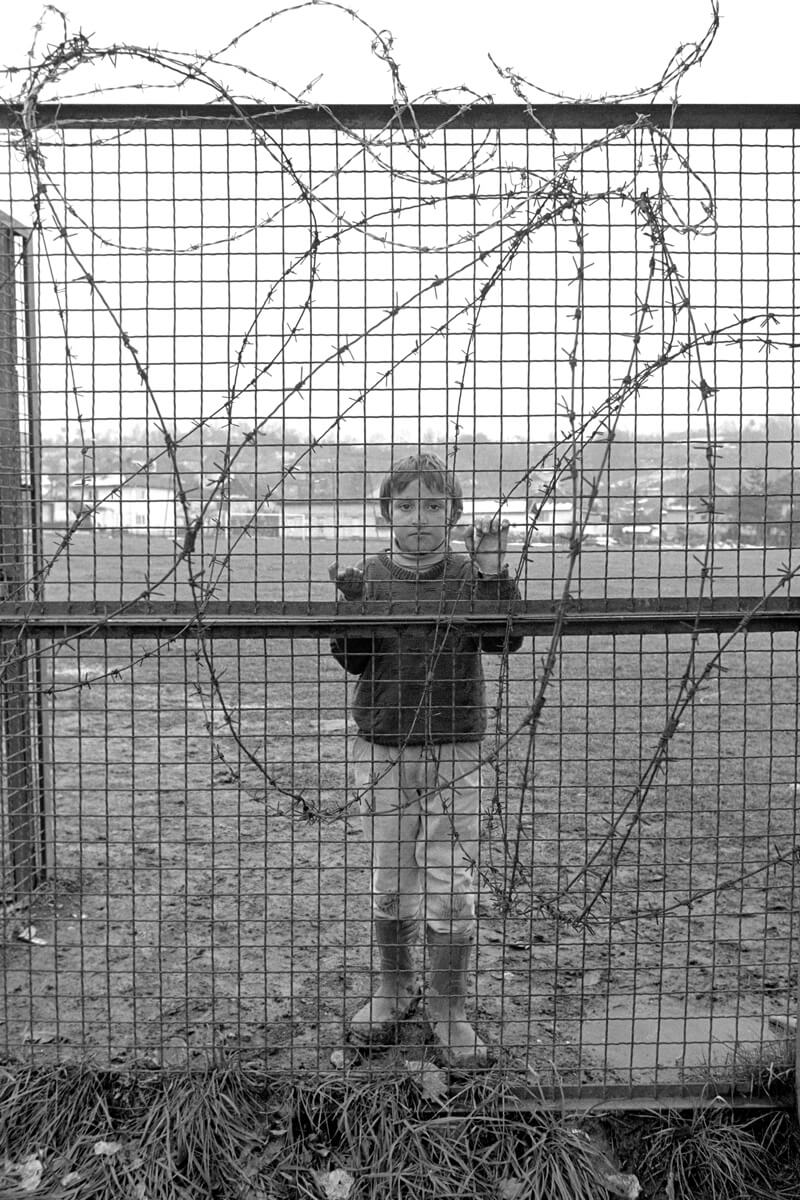
[BOS 50] Refugee boy begs through the fence at a UNHCR aid storage depot asking for food and money.
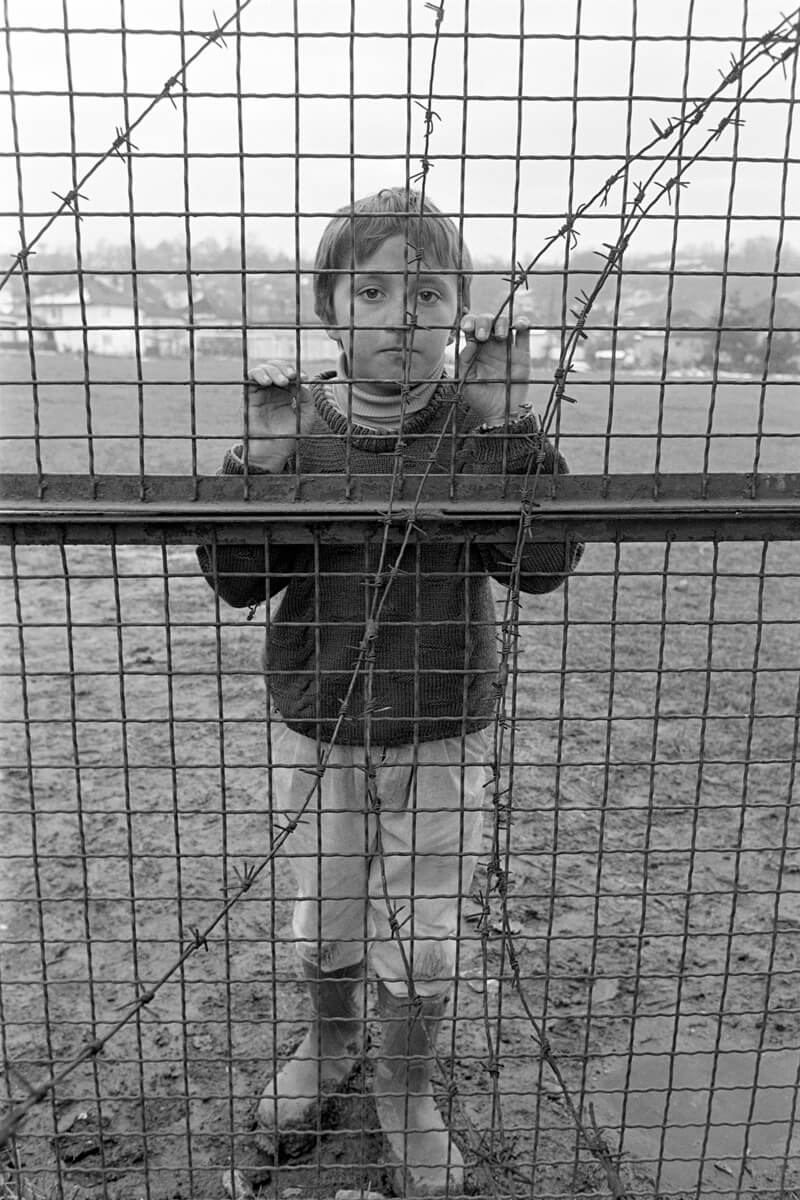
[BOS 51] This photograph of the refugee boy was used for the Oxford Playhouse production poster for Mirad: A Boy from Bosnia and the Safe But Not Protected newspaper awareness and fundraising campaign.
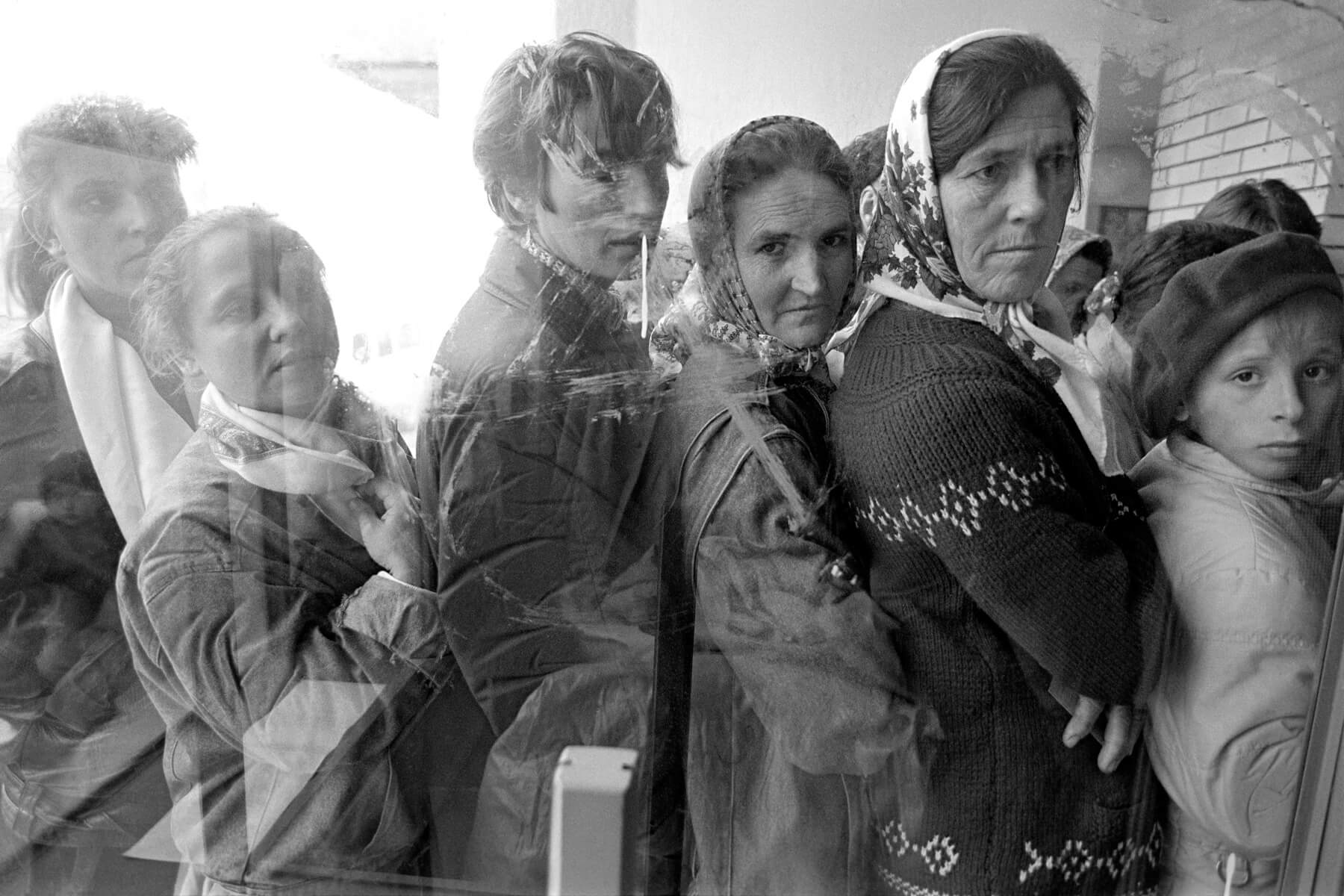
[BOS 52] Refugees queue in the cold and rain waiting to enter Oxfam’s recycled clothing distribution shop.
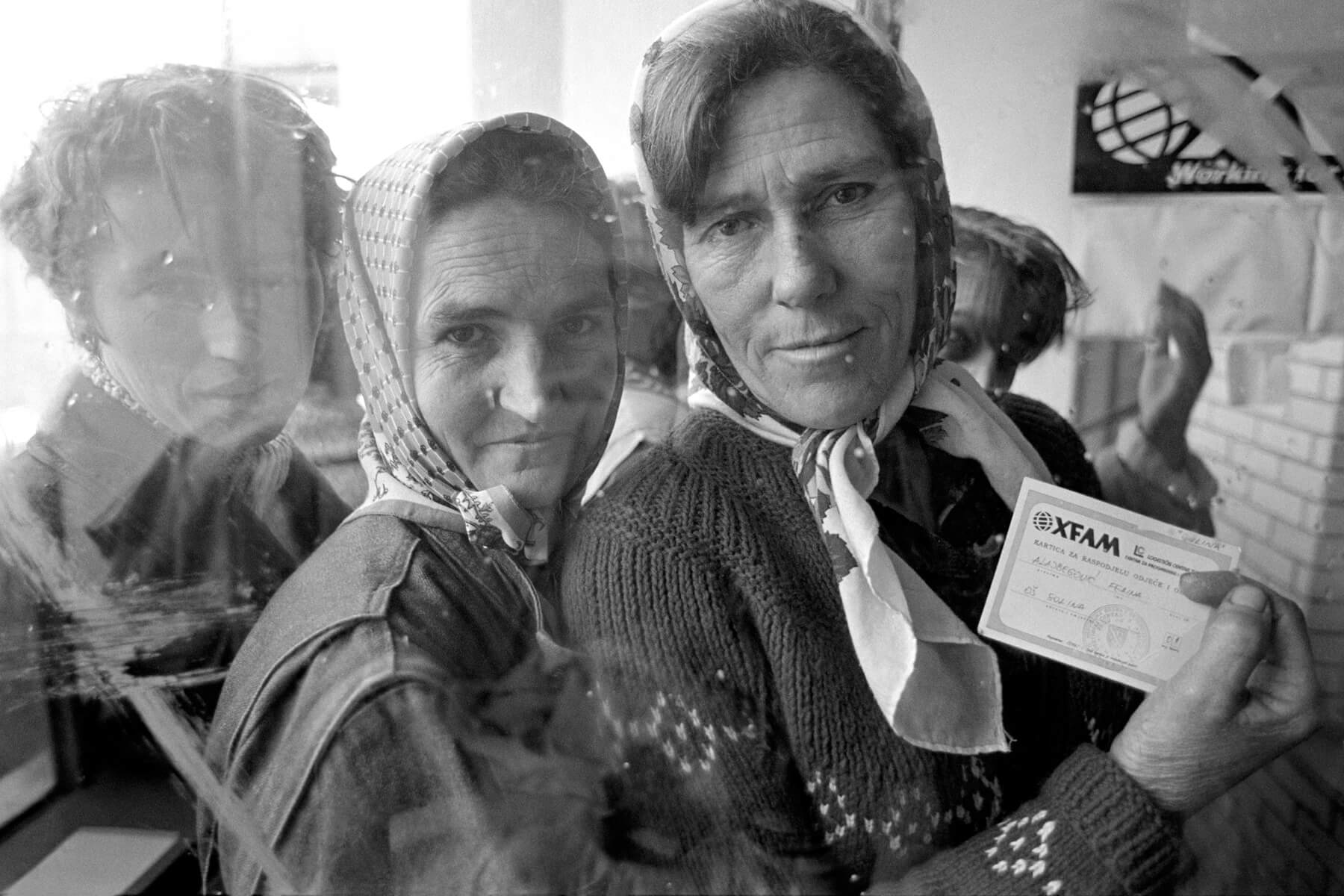
[BOS 53] Woman holding her Oxfam clothing entitlement card.
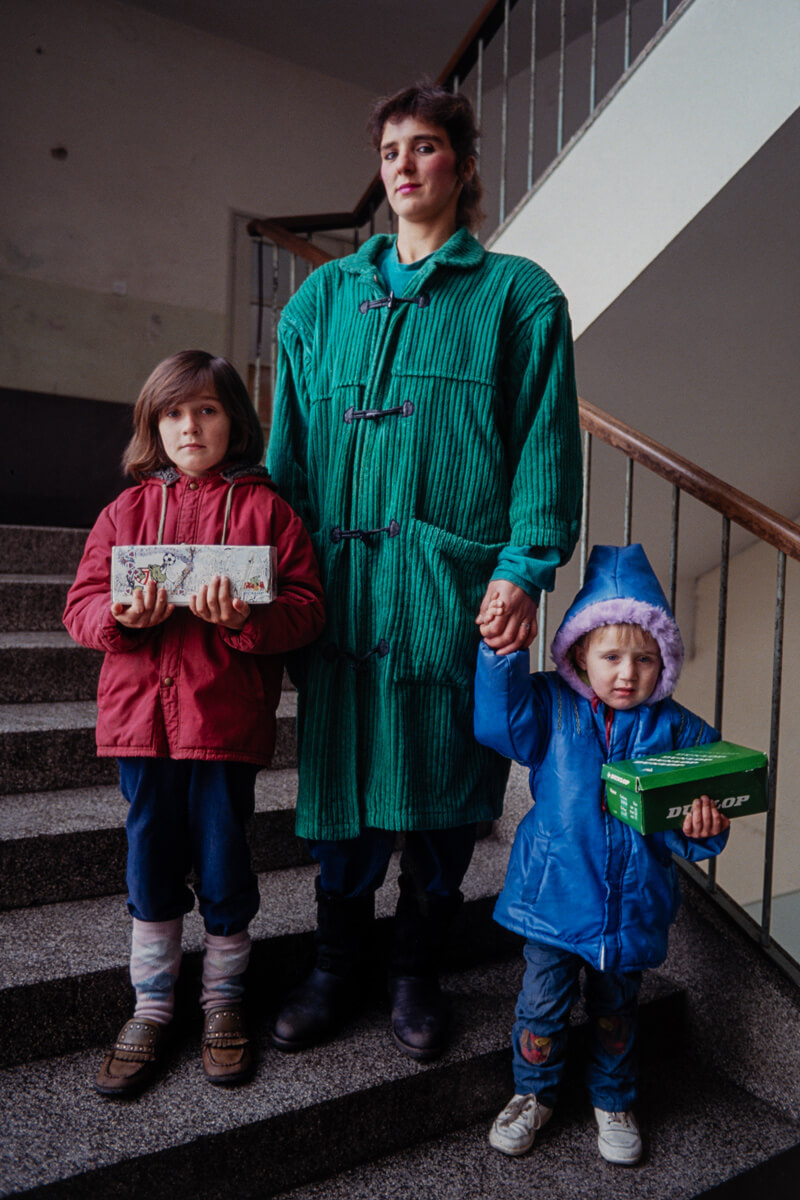
[BOS 54] Woman and her children return from Oxfam’s winter shoe distribution office.
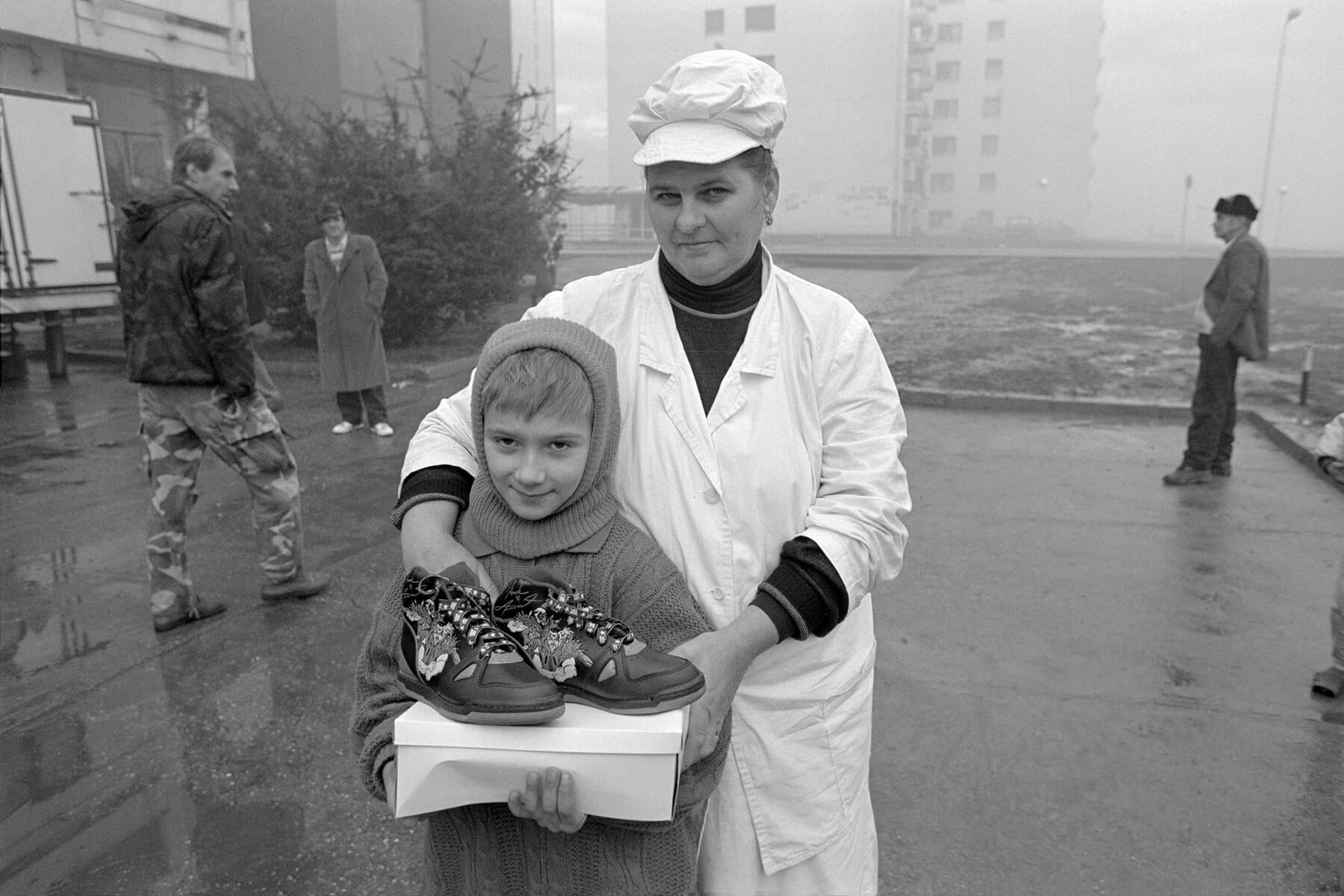
[BOS 55] Bakery worker and her son is happy show his new trainers.
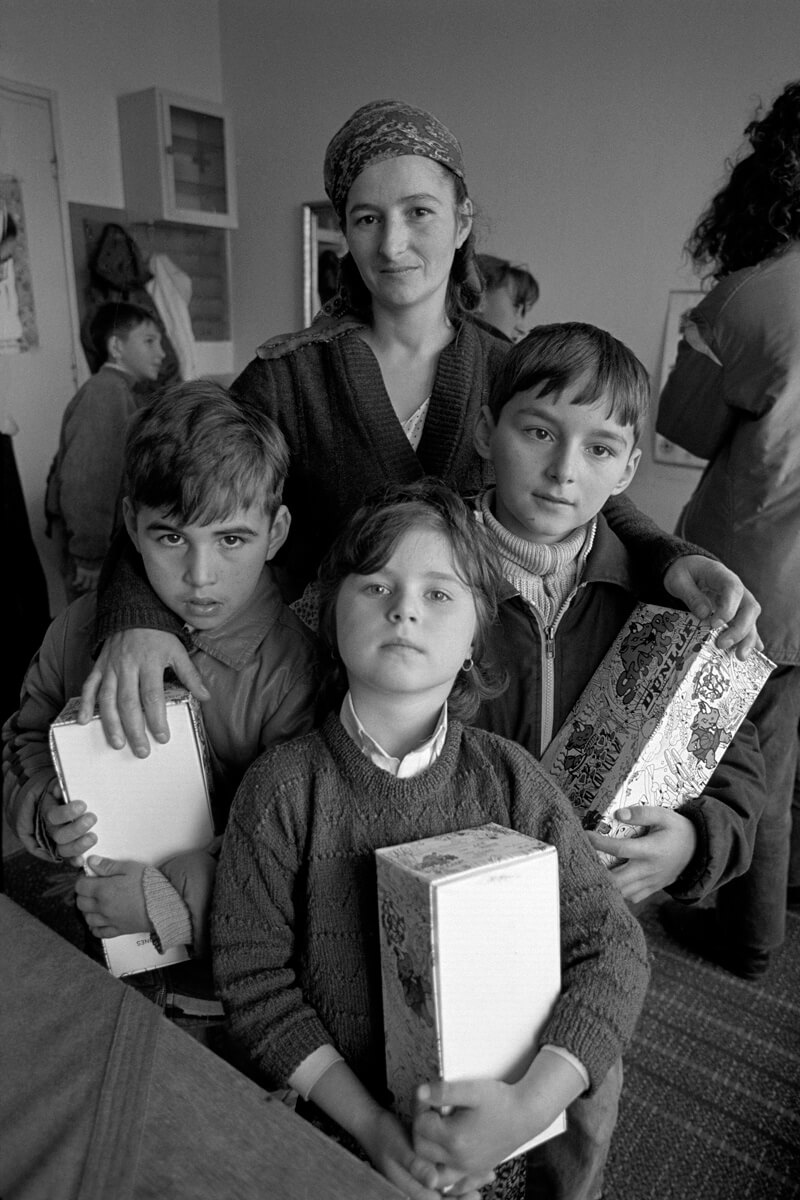
[BOS 56] Women and her children hold their new winter shoes distributed by Oxfam.
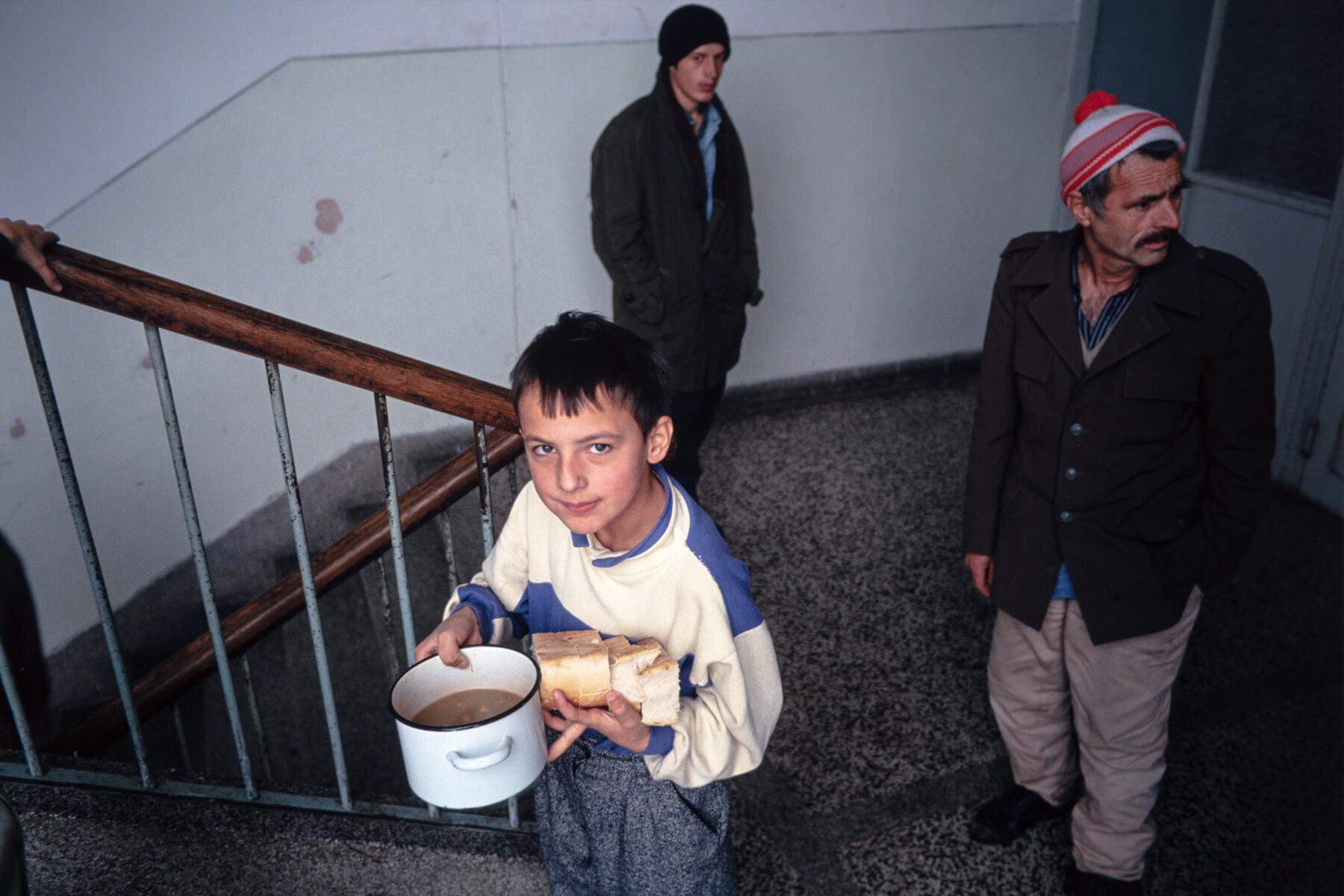
[BOS 57] Boy carrying soup and bread from a community canteen in the basement of a tower block up to his family.
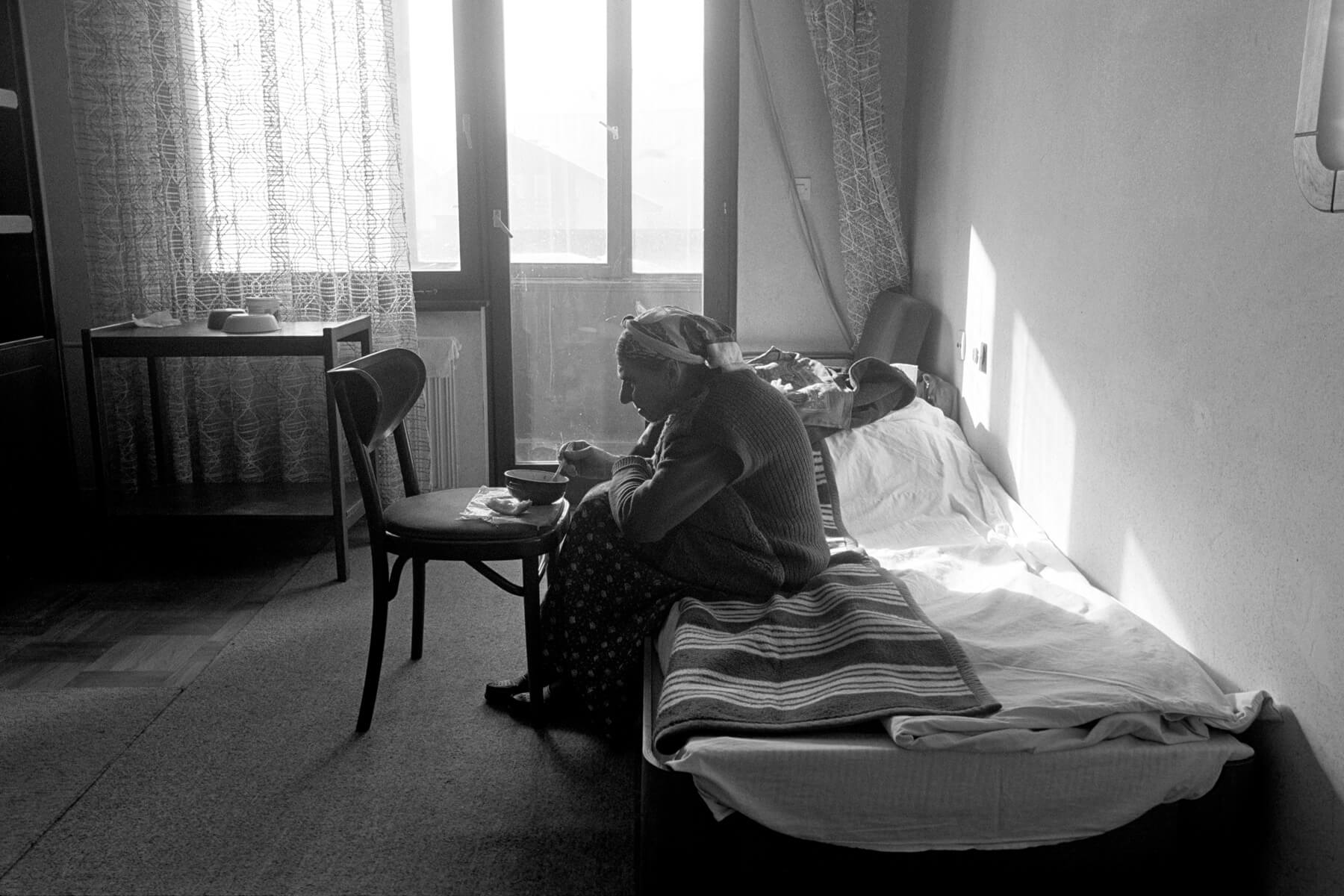
[BOS 58] Elderly woman living in a housing block which has only limited electricity providing heating each day. Soup and bread is delivered to her from a community canteen.
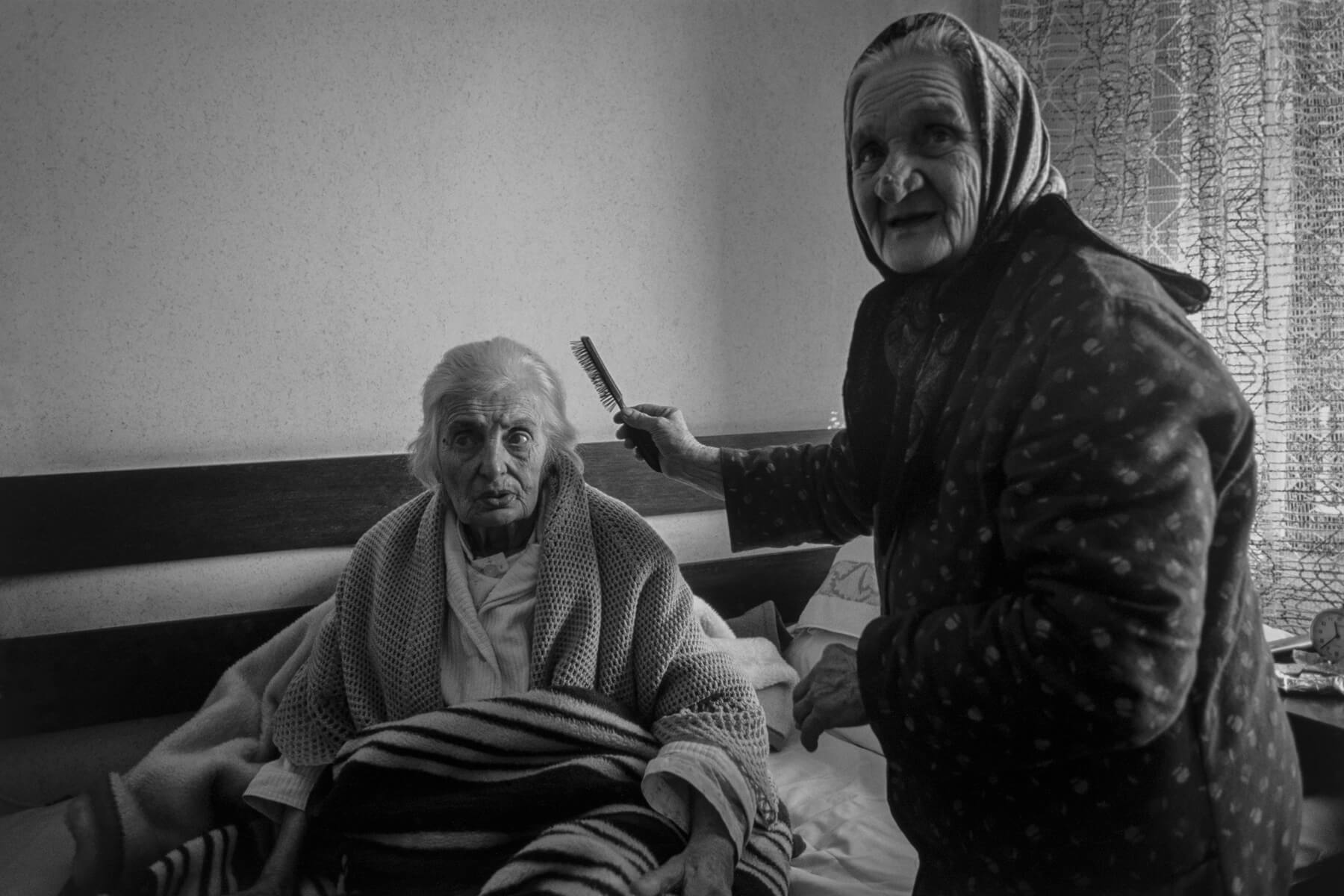
[BOS 59] Women brushes her friend’s hair. Many elderly people stay in bed all day to keep warm.
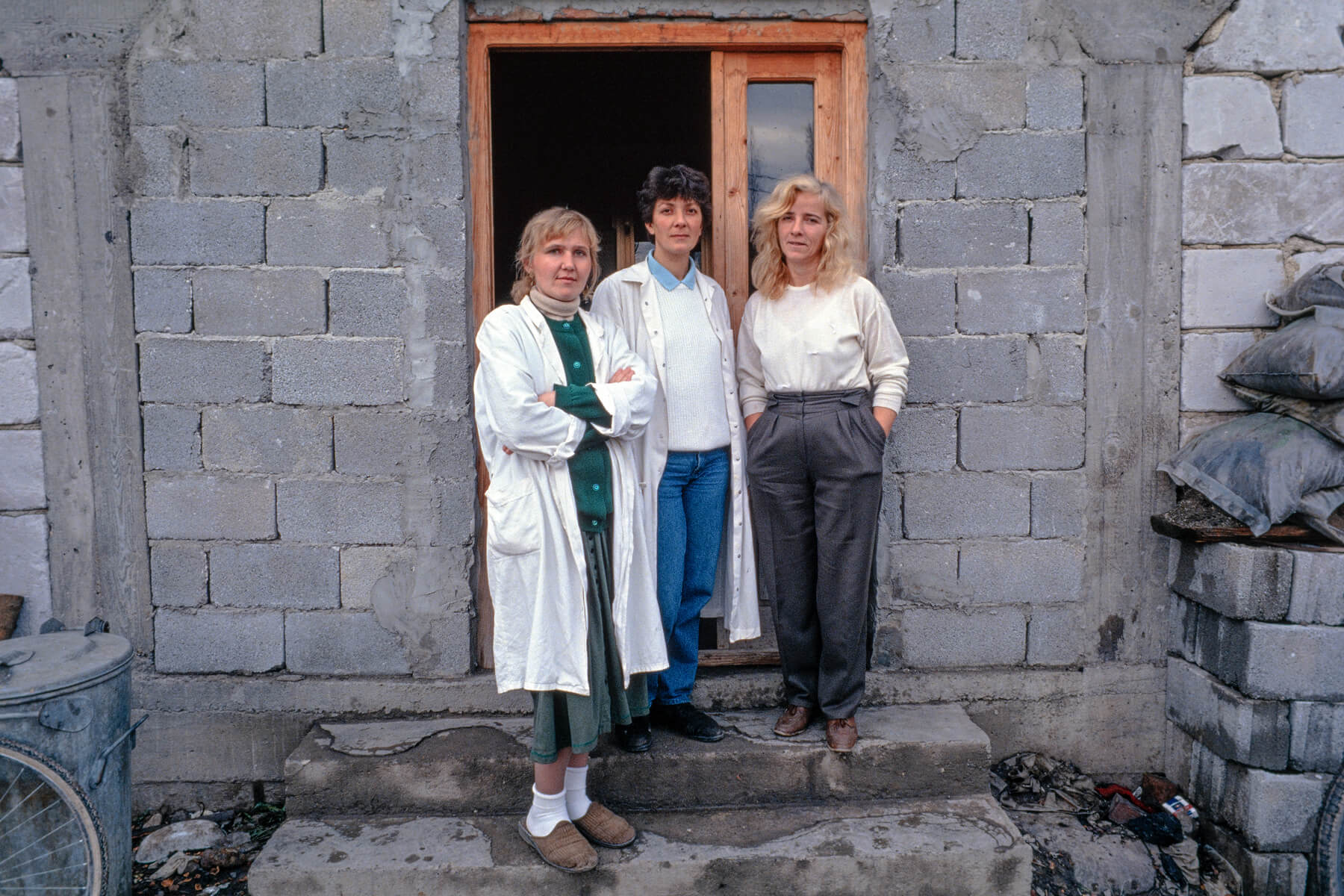
[BOS 60] Medics outside a field dressing station (ratna bolnica) at Kalesija 23km east of Tuzla. This field dressing station provided immediate first aid to wounded soldiers and was located close the battle zone.
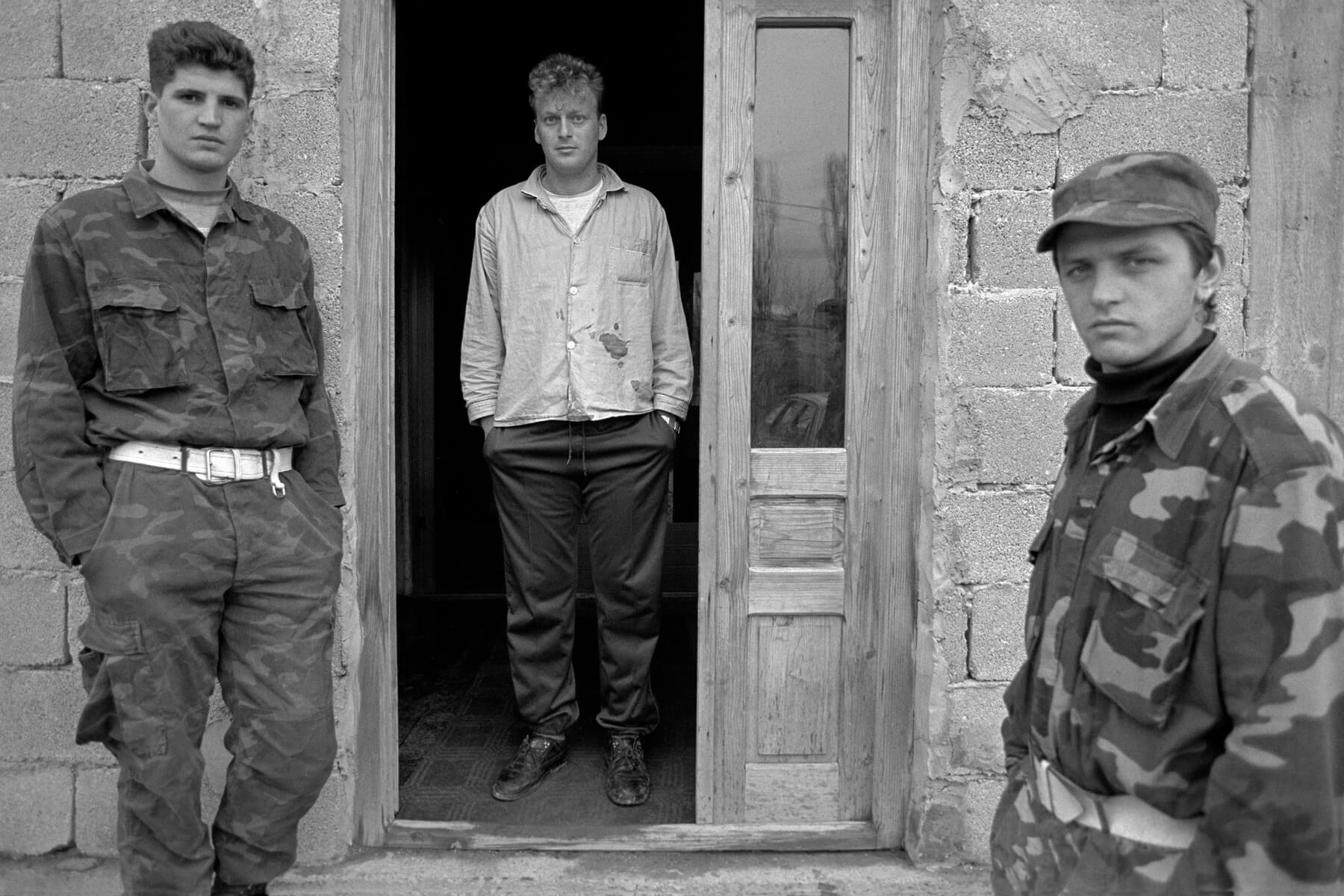
[BOS 61] A soldier wounded by mortar shrapnel earlier that morning is visited by his friends at the field dressing station.
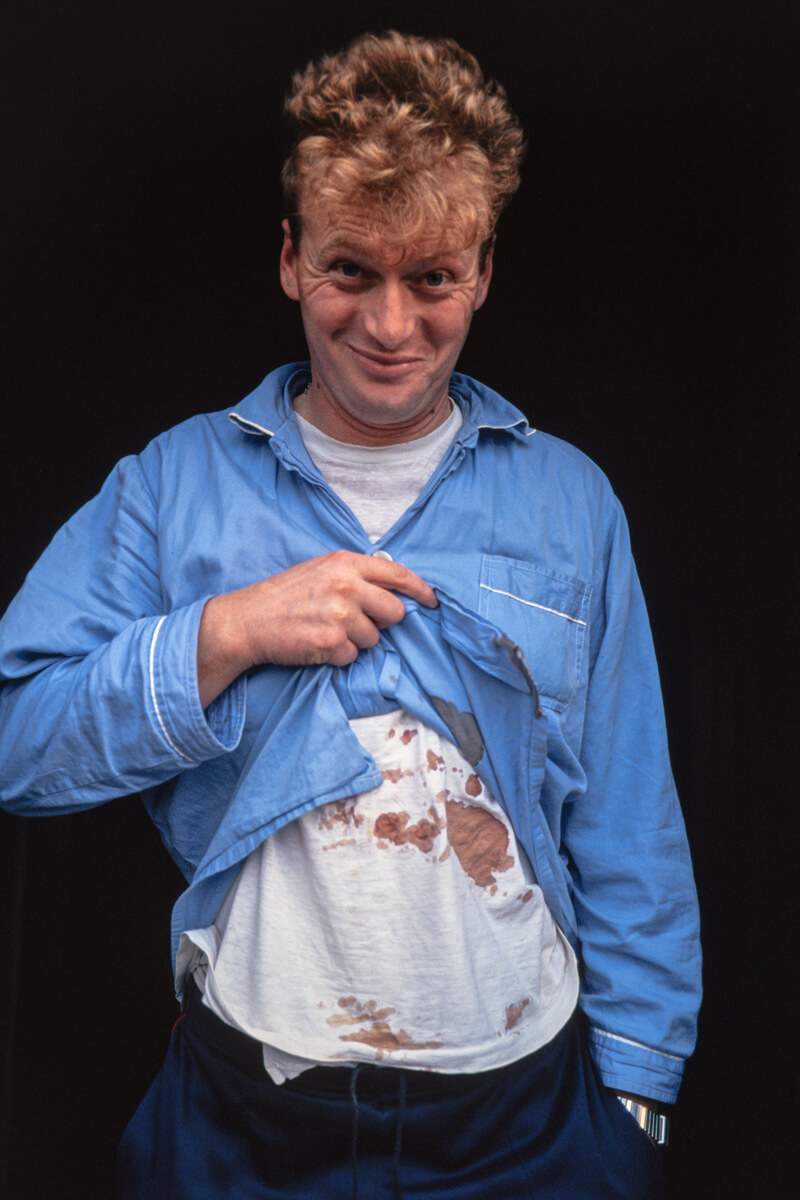
[BOS 62] Wounded soldier at the field dressing station.
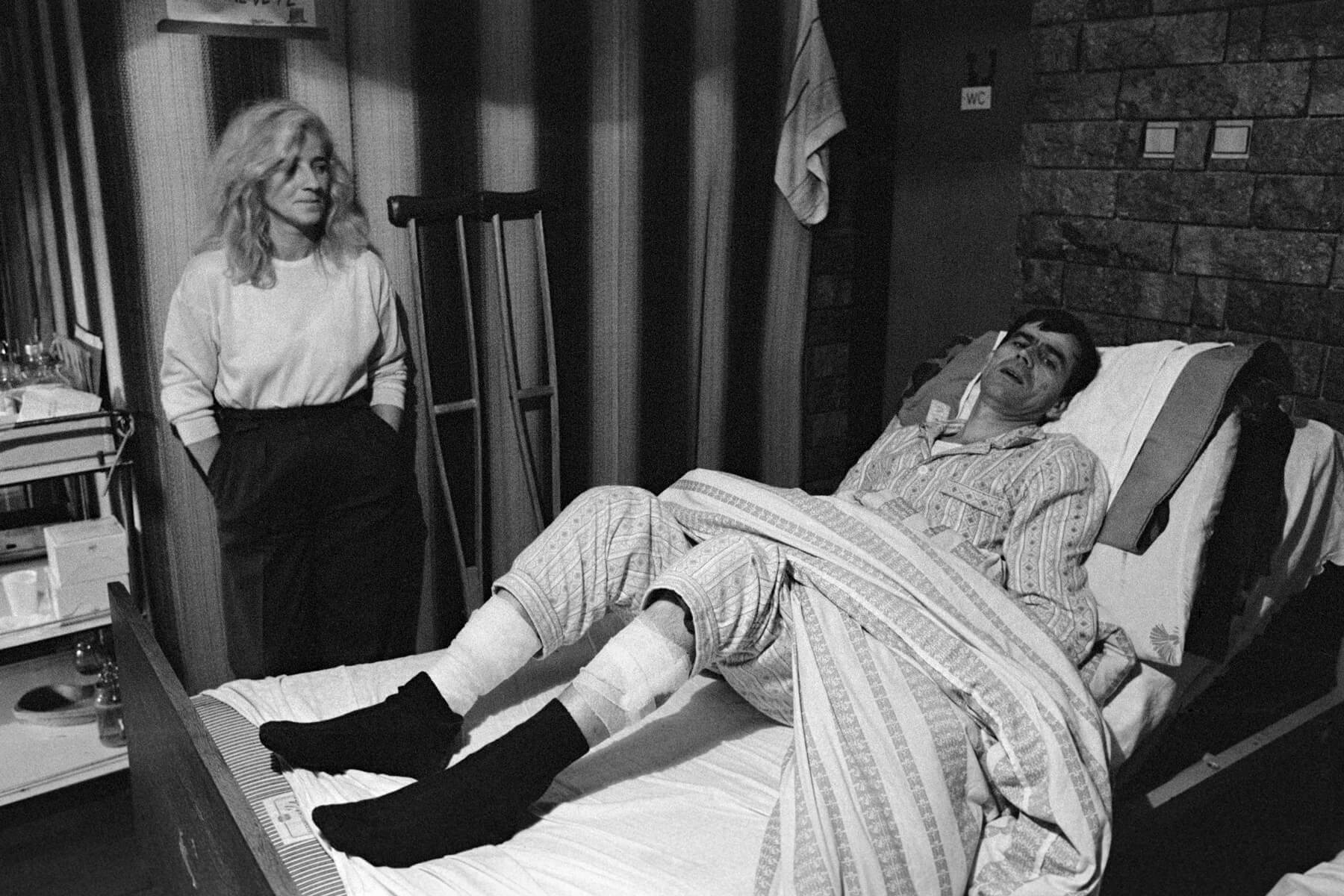
[BOS 63] Medic and wounded soldier in the basement at the field dressing station. He is being treated for shrapnel wounds to his legs.
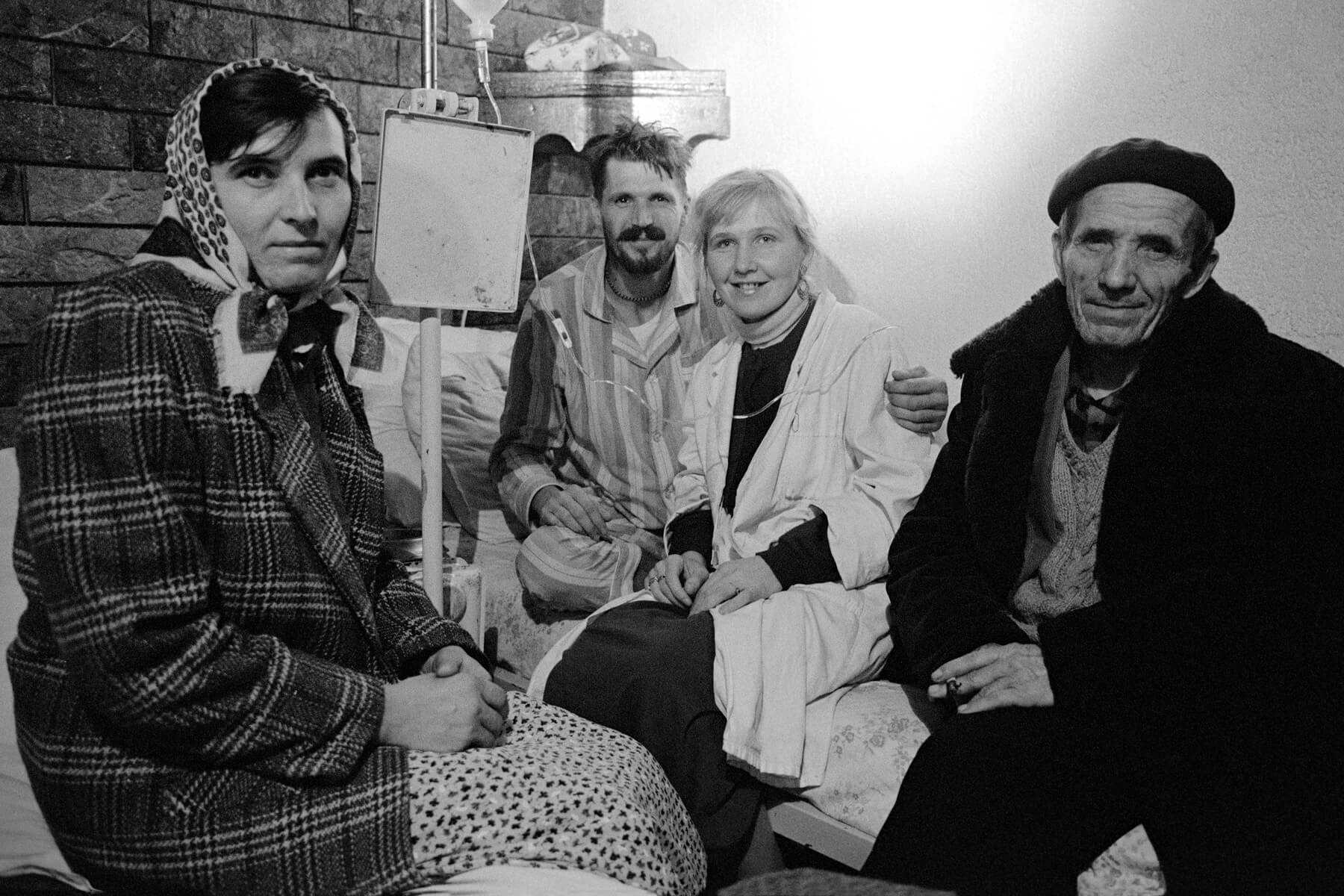
[BOS 64] Medic and wounded soldier. He is visited by his wife and father in the basement of the field dressing station.
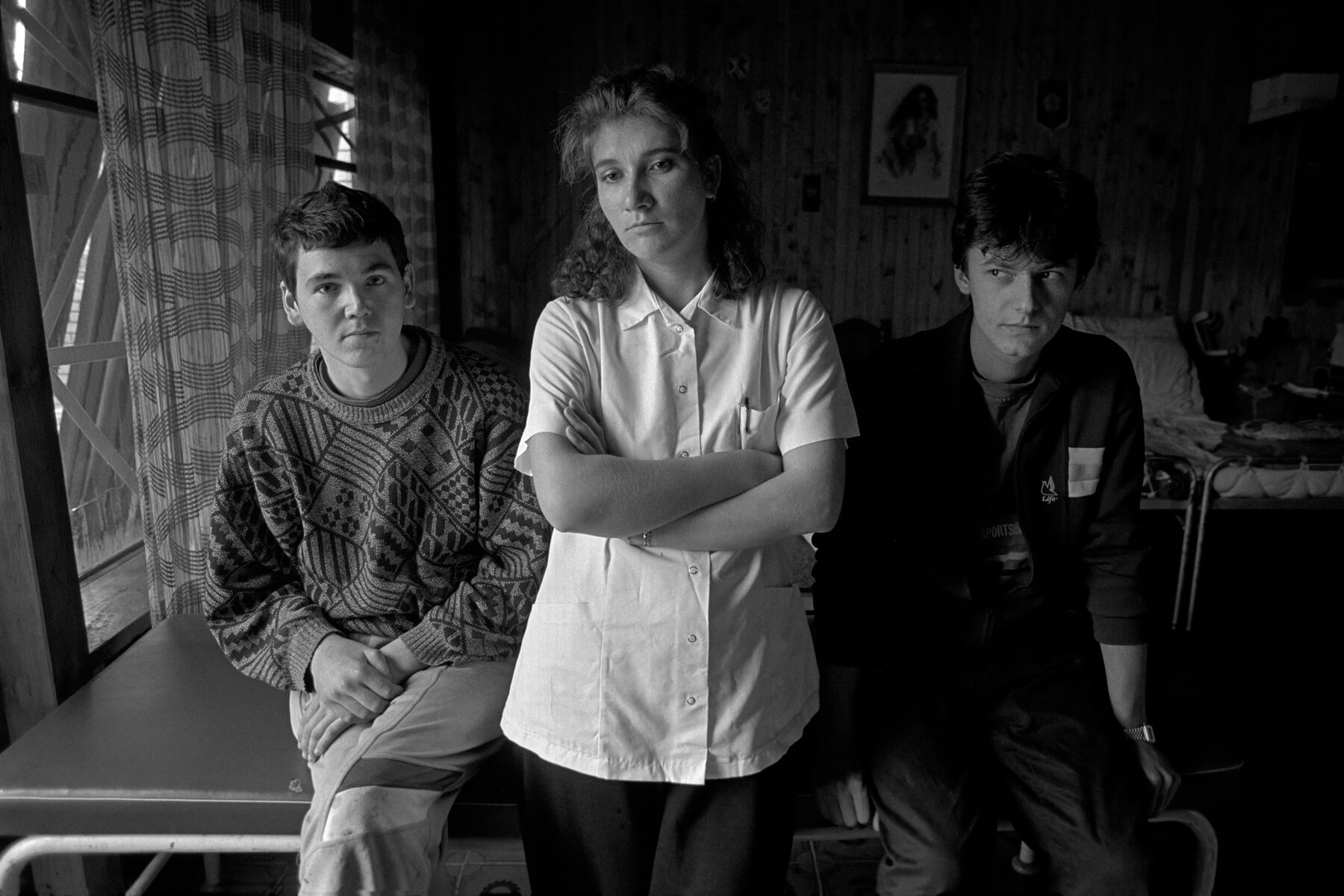
[BOS 65] Exhausted medic and volunteer orderlies at the field dressing station.
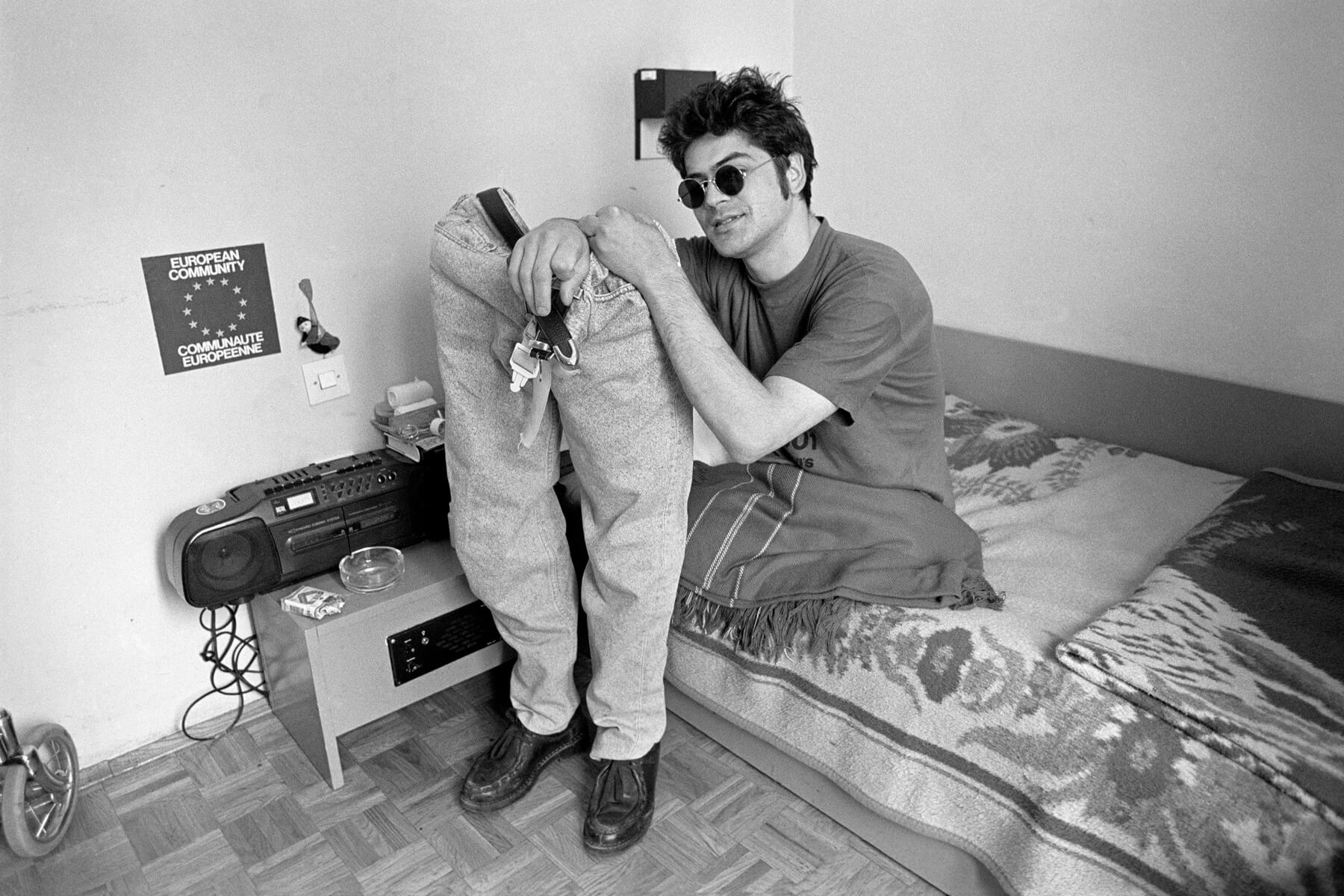
[BOS 66] Emil Razvaliac aged 25 is a double amputee and former waiter who is now being treated at the University Clinical Center (UKC) rehabilitation centre.
He made this statement:
“I am a soldier injured by a mortar shell in Srebrenica which killed my two friends, I was transported to hospital two days later. I consider myself lucky as the shell landed at my feet, cutting my legs off immediately, however, the trajectory of the shrapnel hit my comrades in the chest and head killing them. I want to return to the front line again and want to thank Handicap International for my new legs and jeans”.
This photograph of Emil was used by Students Against GEnocide (SAGE), as a postcard and sent in their thousands to President Bill Clinton appealing to him to lift an arms embargo. The arms embargo was imposed to prevent the war escalating in September 1991. However, all this achieved was to create an imbalance in weaponry between the Serbs to the disadvantage of the Bosnian Army.
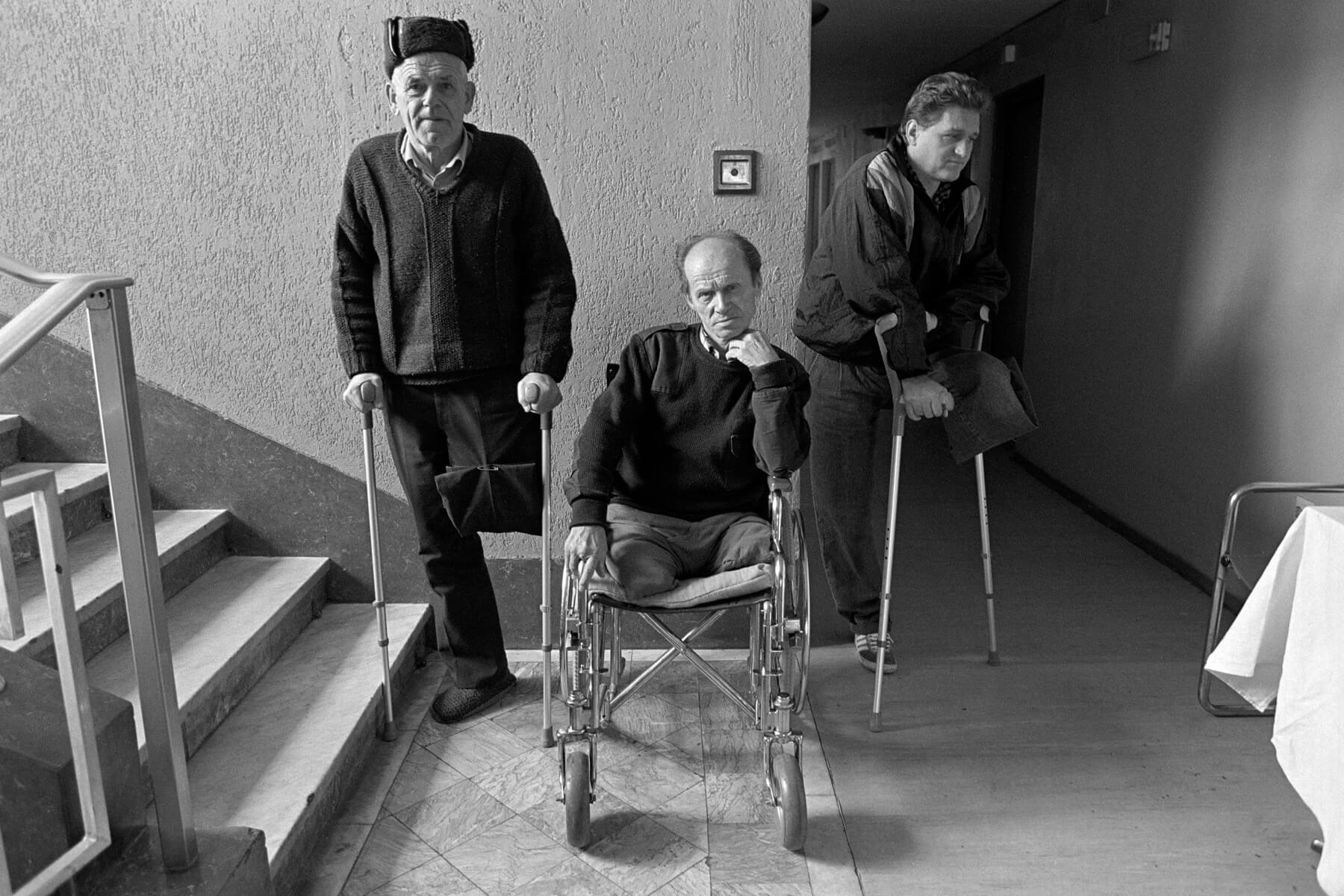
[BOS 67] Civilian amputees injured by bomblets from cluster bombs. Cluster bombs were dropped over a wide area surrounding Tuzla from Serbian jets. These bomblets are designed to detonate and maim when stood on or touched.
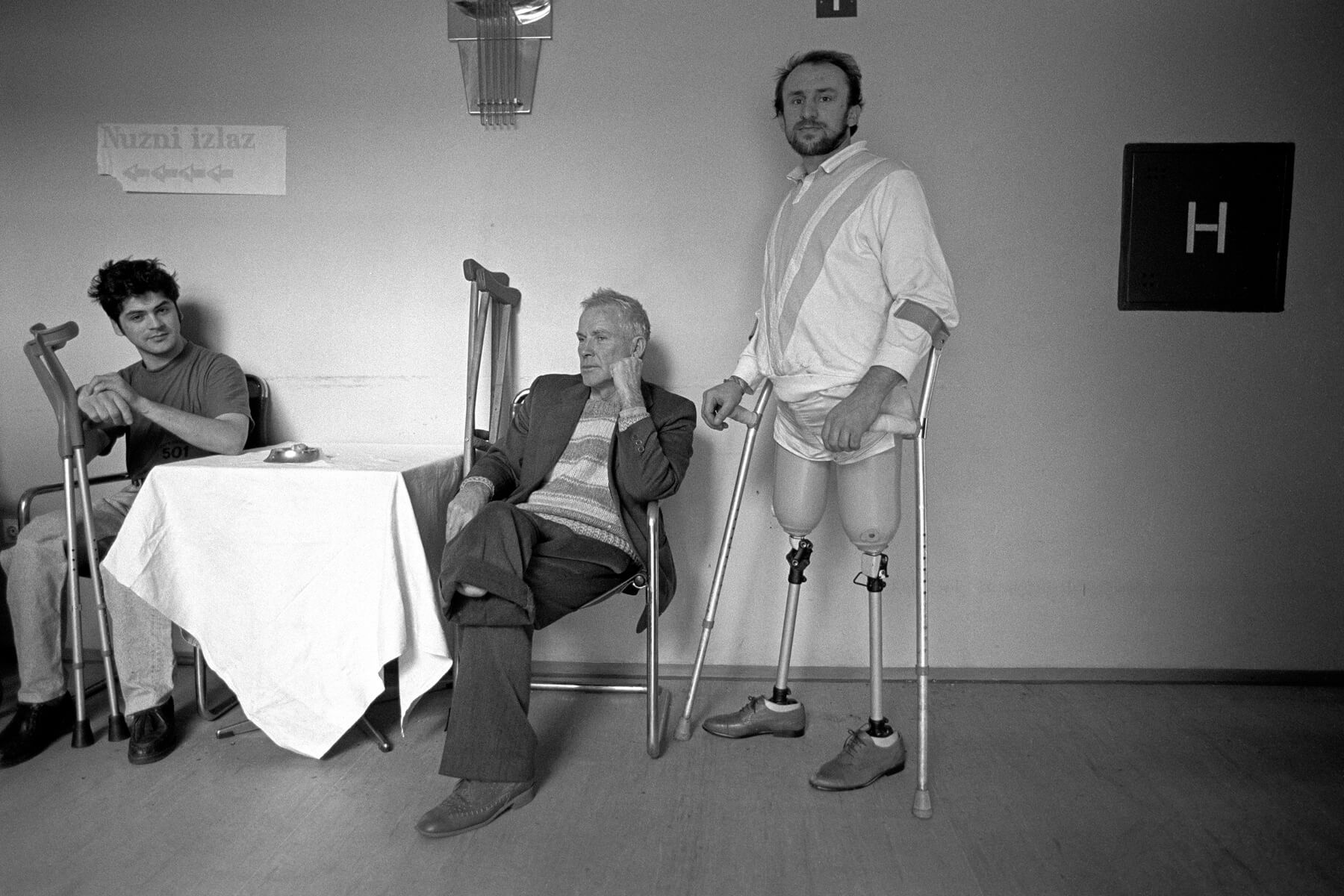
[BOS 68] Civilian and military amputees at University Clinical Center (UKC) rehabilitation centre.
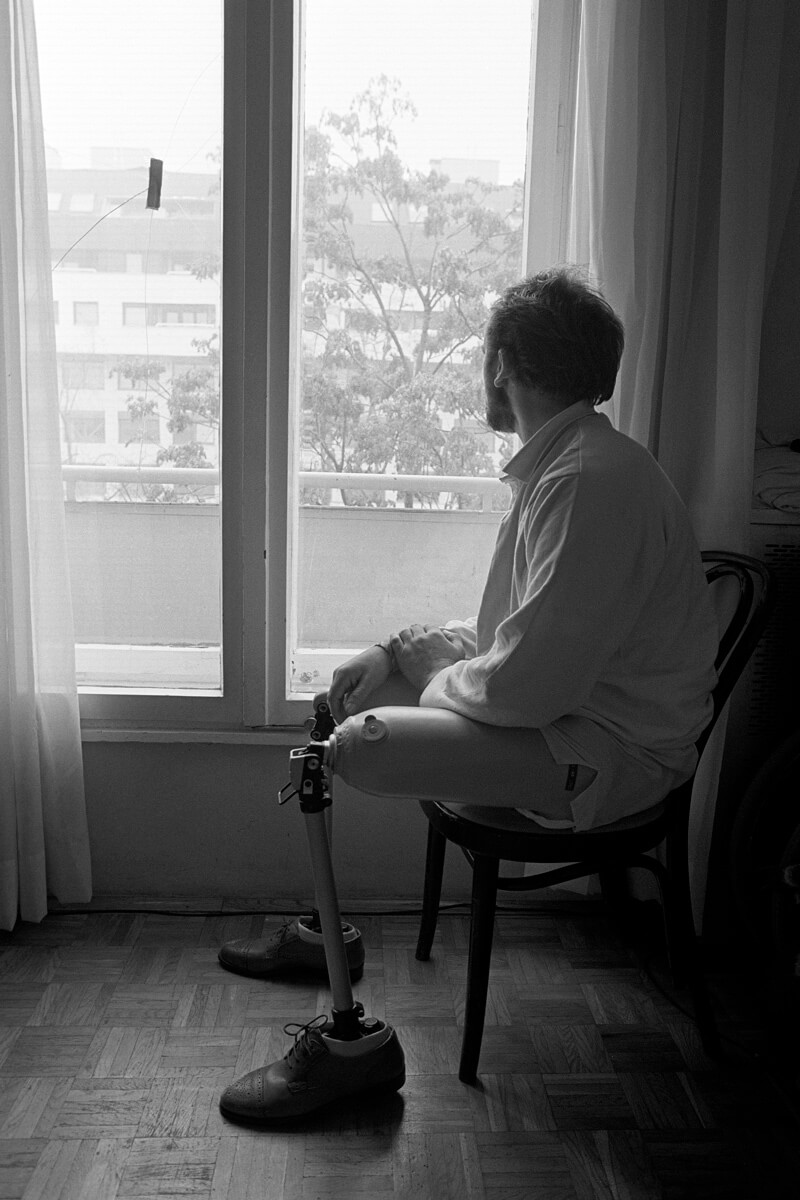
[BOS 69] Military double amputee at the rehabilitation centre. The plaster on the window covers a bullet hole.
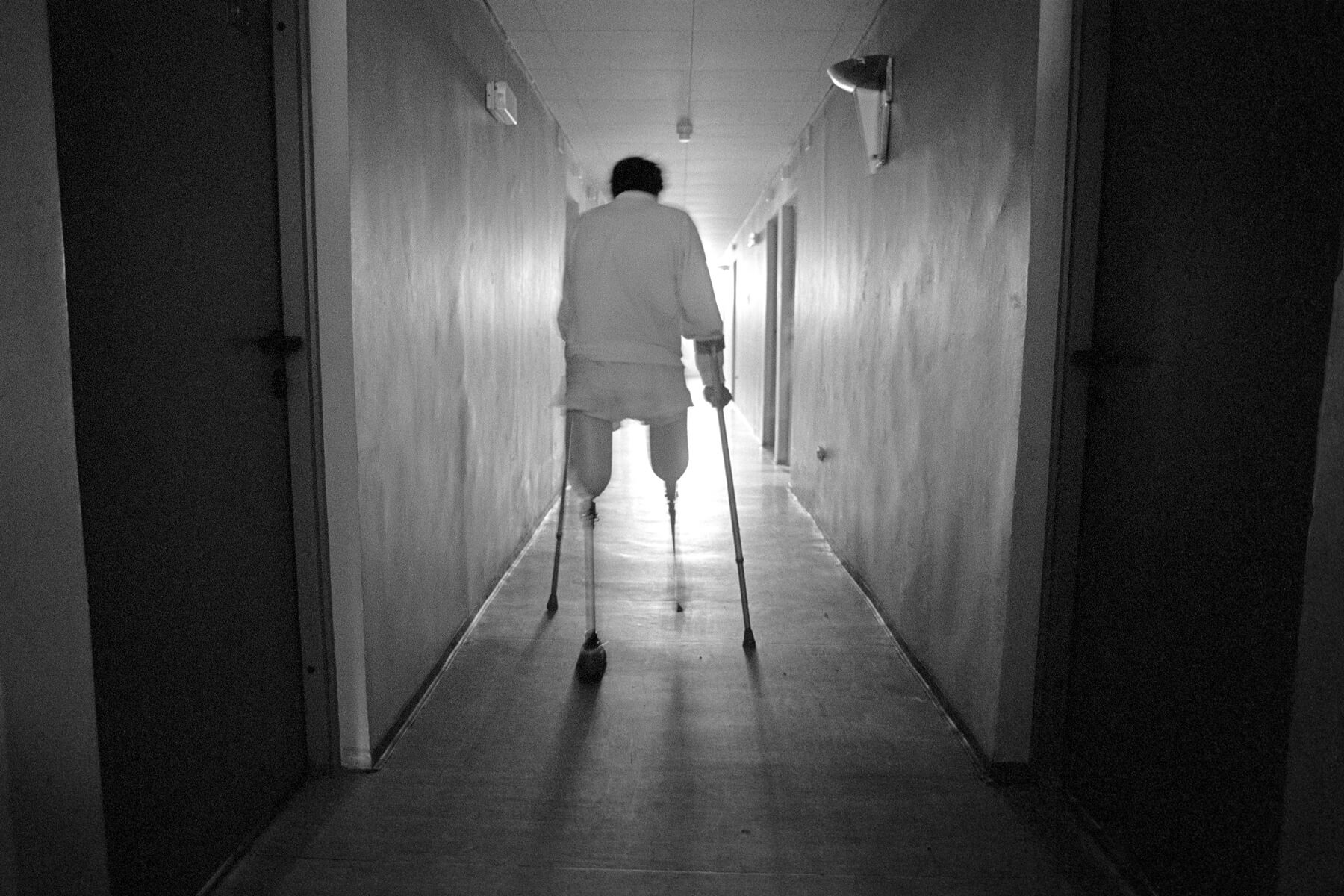
[BOS 70] He practices walking down the corridor.
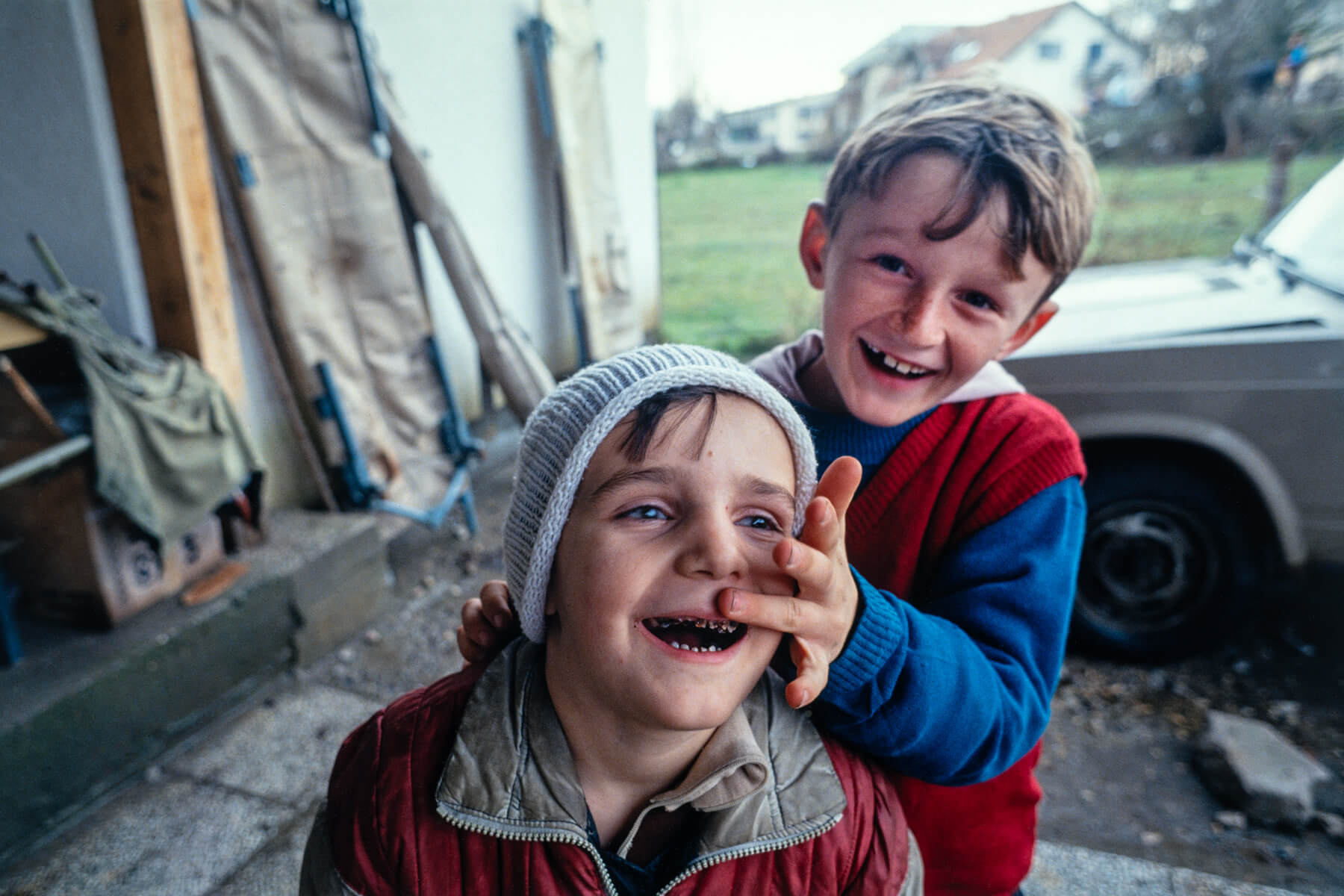
[BOS 71] Boy shows me his younger brother’s decayed teeth at the Public Orphanage at Kozaračka.
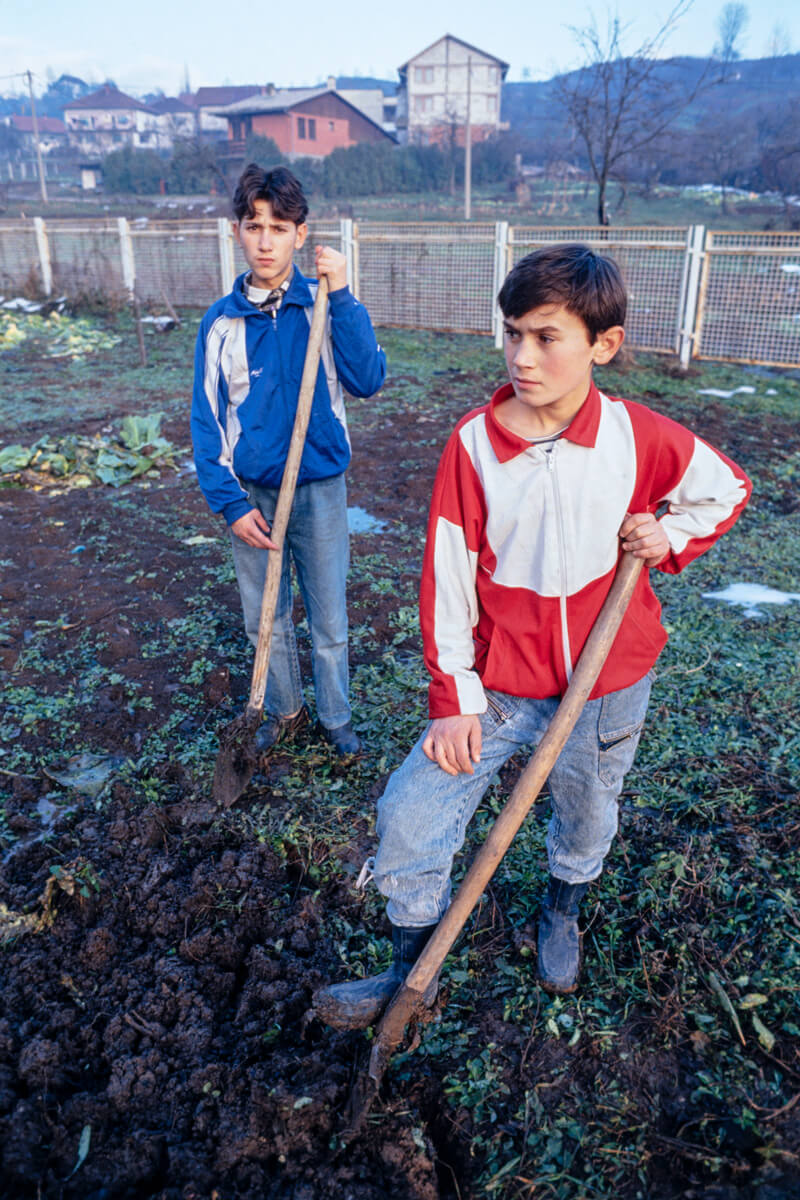
[BOS 72] Boys prepare the soil to grow cabbages in the orphanage vegetable garden.
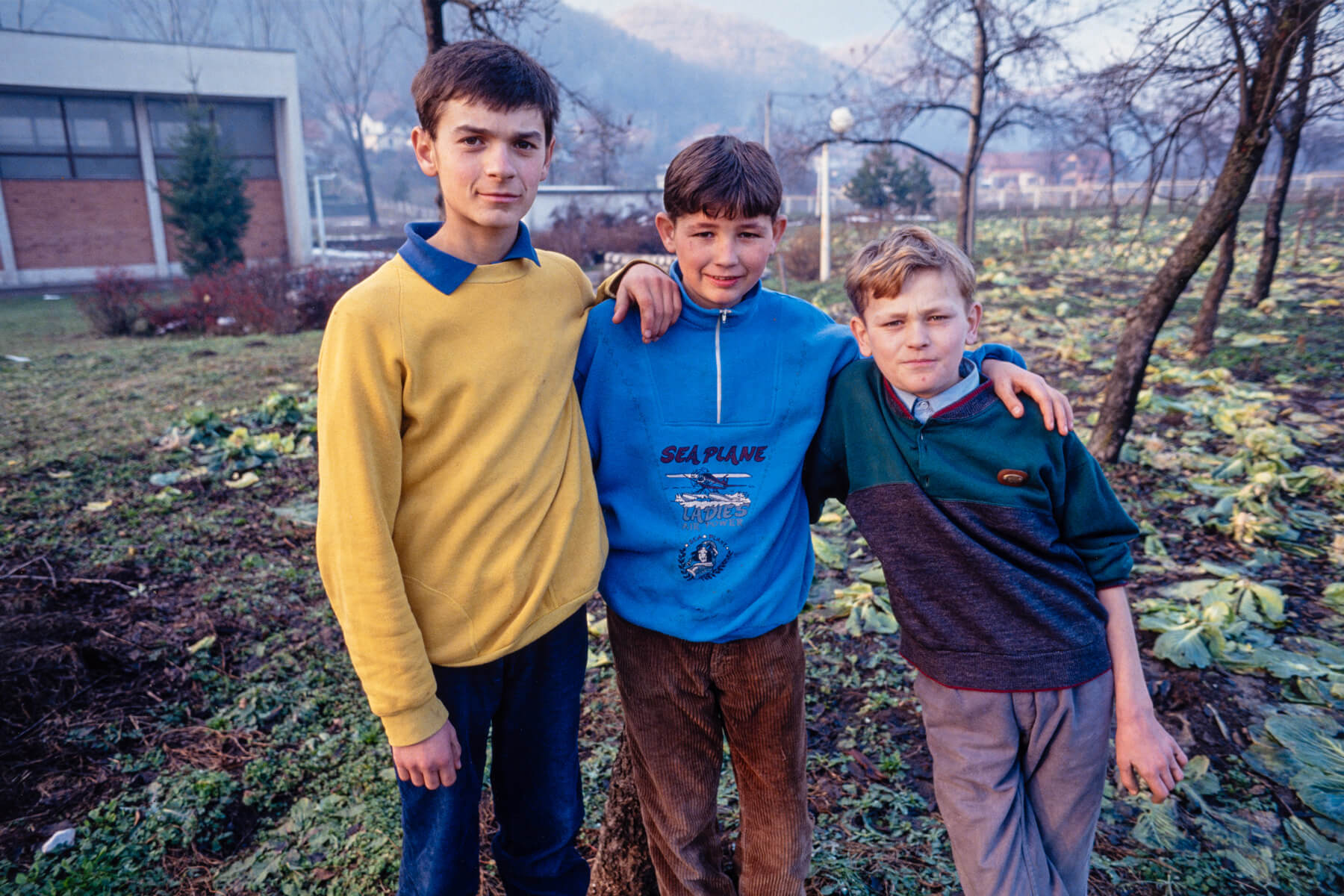
[BOS 73] Boys take a break from working in the orphanage vegetable garden.
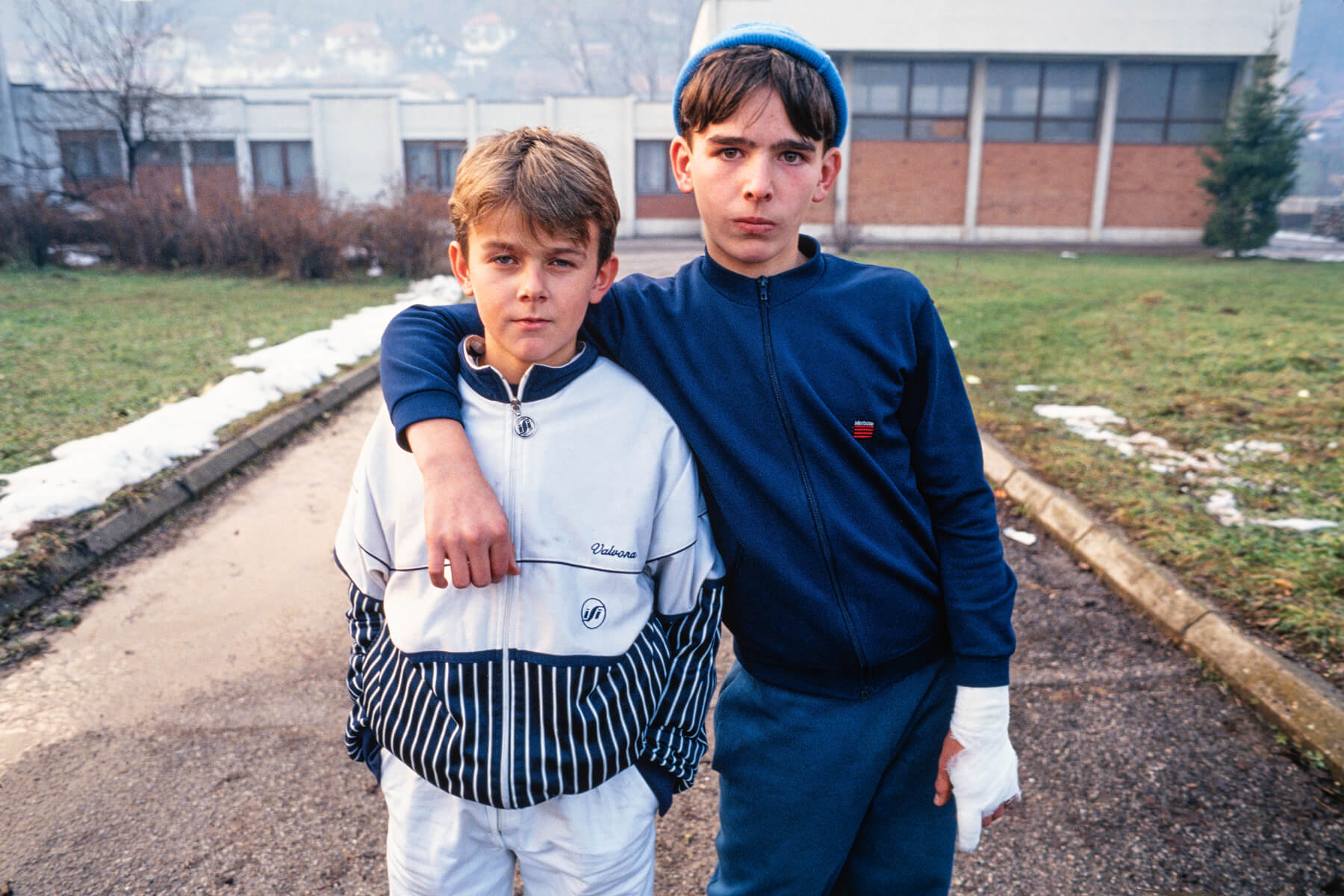
[BOS 74] Defiant boys outside the orphanage.
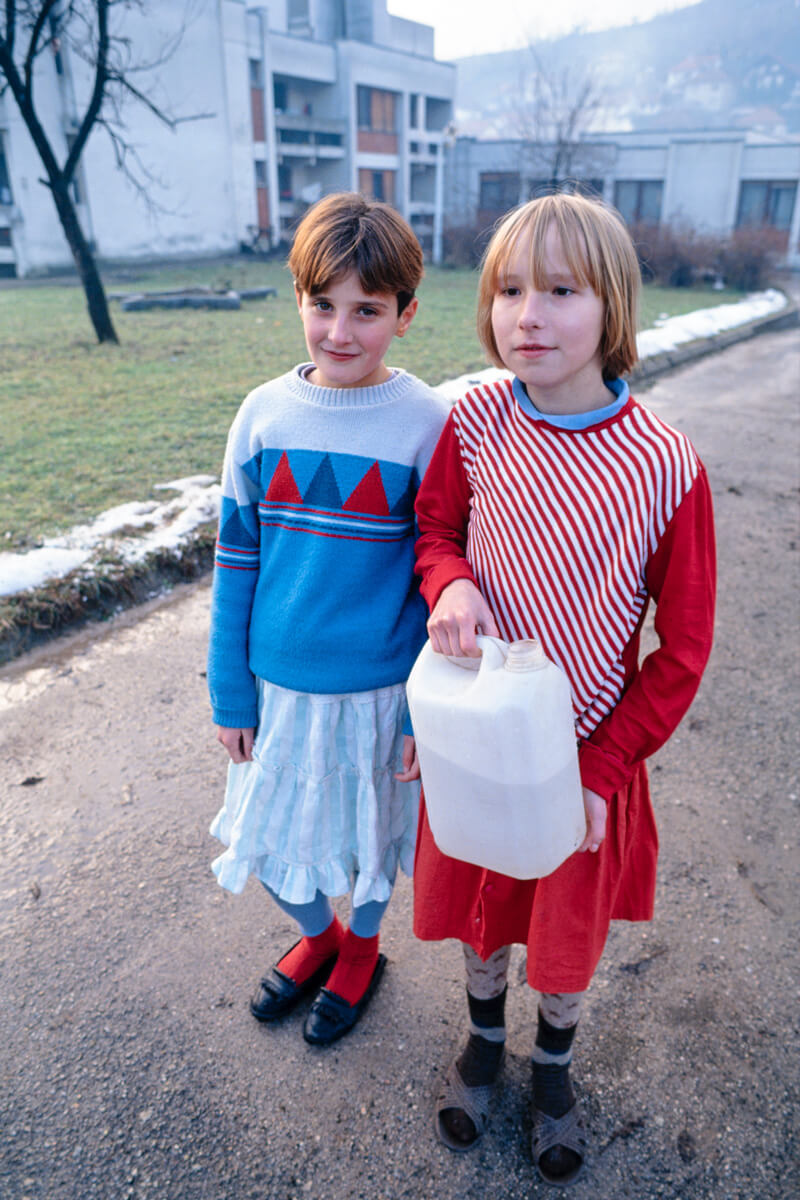
[BOS 75] Girls carry clean water to the orphanage kitchen. They are still waiting to receive their winter shoes.
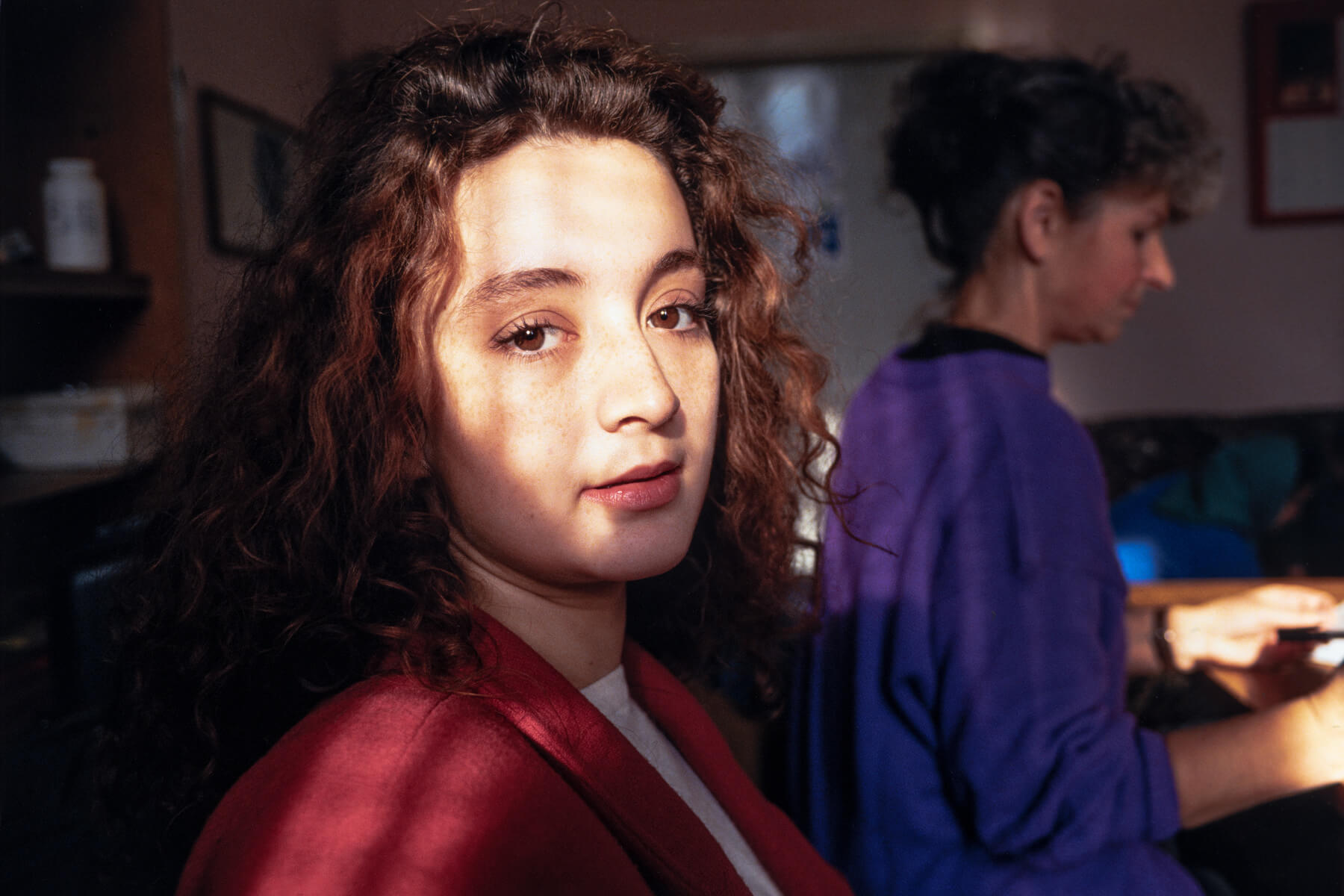
[BOS 76] Many thanks to Jasmina Husanovic, Oxfam’s programme manager in Tuzla who assisted me as translator and facilitator during this assignment.
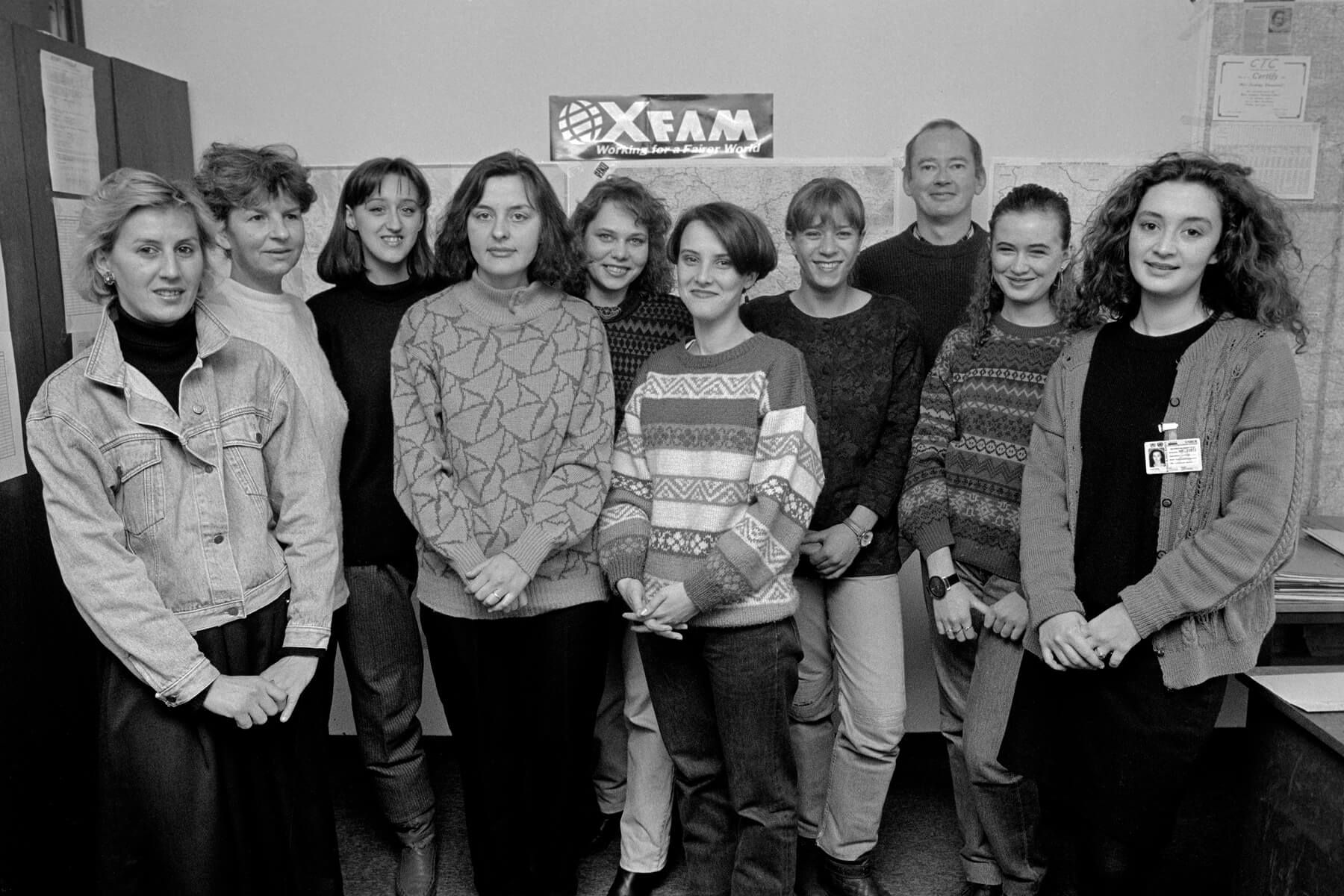
[BOS 77] Staff at Oxfam’s office Tuzla, December 1993. Many thanks to Oxfam’s Bosnia representative in Tuzla, Andrew Chadwick and Geoff Sayer at Oxfam GB’s HQ, Oxford, UK.
Return Journey from Tuzla to Split, Croatia, via Sarajevo
The first part of this journey was made overland from Tuzla by UNPROFOR armoured personnel carrier to the Holiday Inn, Sarajevo. The following day I travelled in a lightly armoured UNPROFOR Land Rover to Sarajevo Airport. The final leg to Split Airport was made by UNHCR C-130 Hercules military transporter.
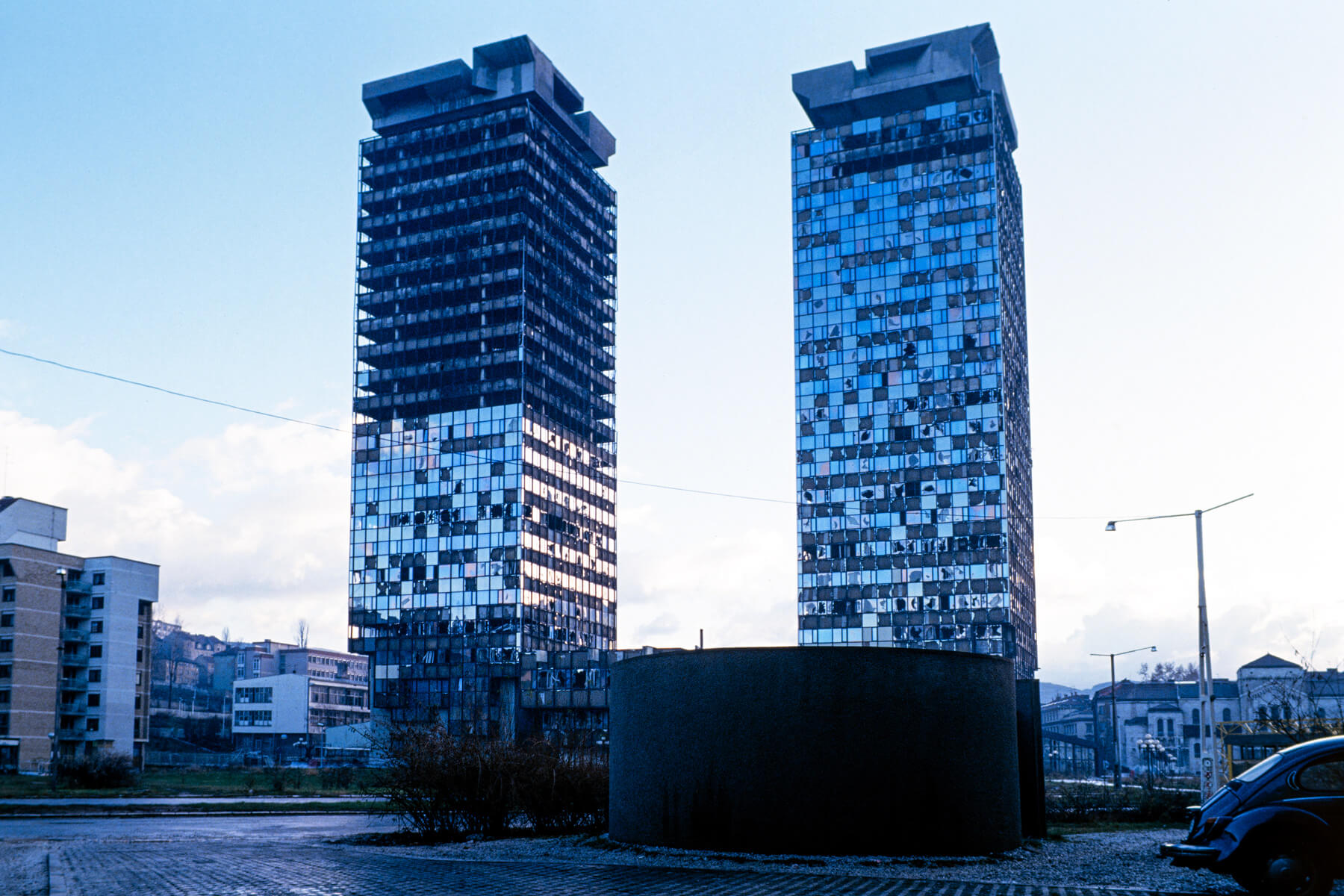
[BOS 78] Early morning view of the twin Unis Towers nicknamed Momo and Uzeir opposite the Holiday Inn, Sarajevo. They were extensively damaged by shelling in June 1992 and became symbols of resistance during the Siege of Sarajevo.
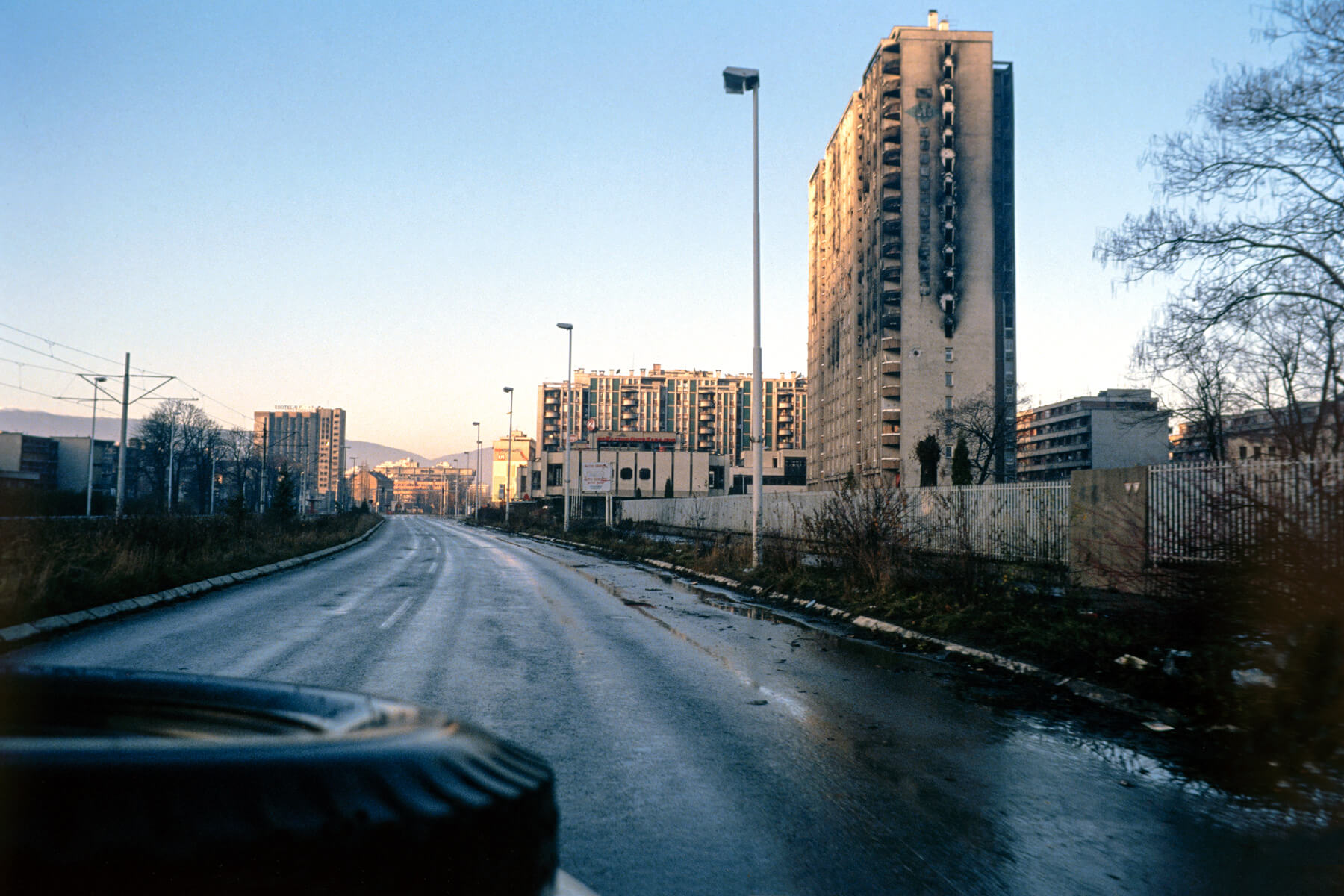
[BOS 79] View from a lightly armoured UNPROFOR Land Rover travelling along Sniper Alley en route to Sarajevo airport. Sarajevo was encircled by the Bosnian Serb Army forces between April 1992 -Feb 1996, known as the Siege of Sarajevo. It was the longest siege of a city in the history of modern warfare. High ground around the city gave snipers an extensive field of fire. The main road out of the city to the airport was infamously known as Sniper Alley due to large number of sniper positions that aimed to control all movement in the city.
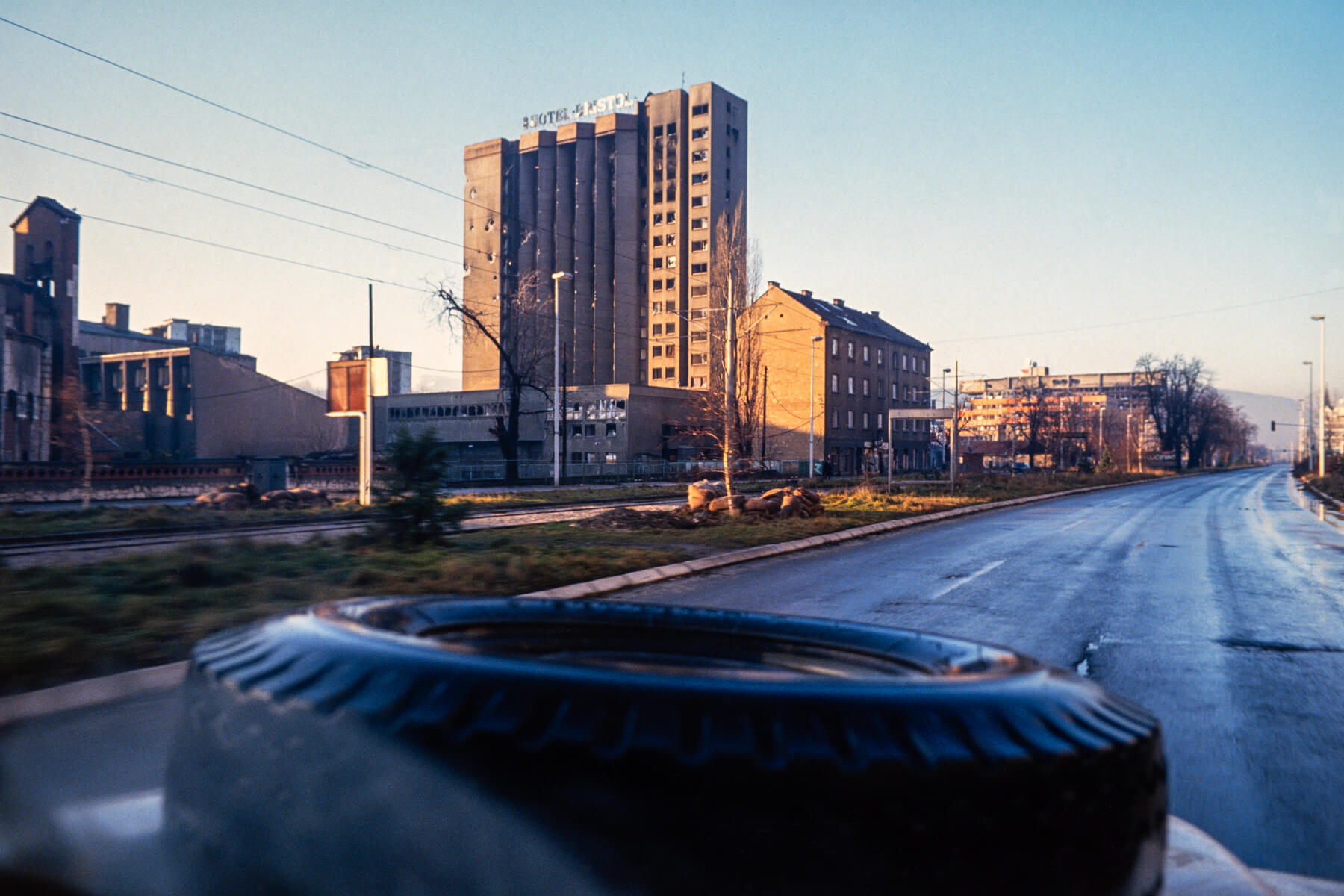
[BOS 80] View of the Hotel Bristol from sniper alley. The hotel has artillery shell impact damage from Serbian forces which bombarded the building from across the river Milijacka. The hotel was restored in 2010.
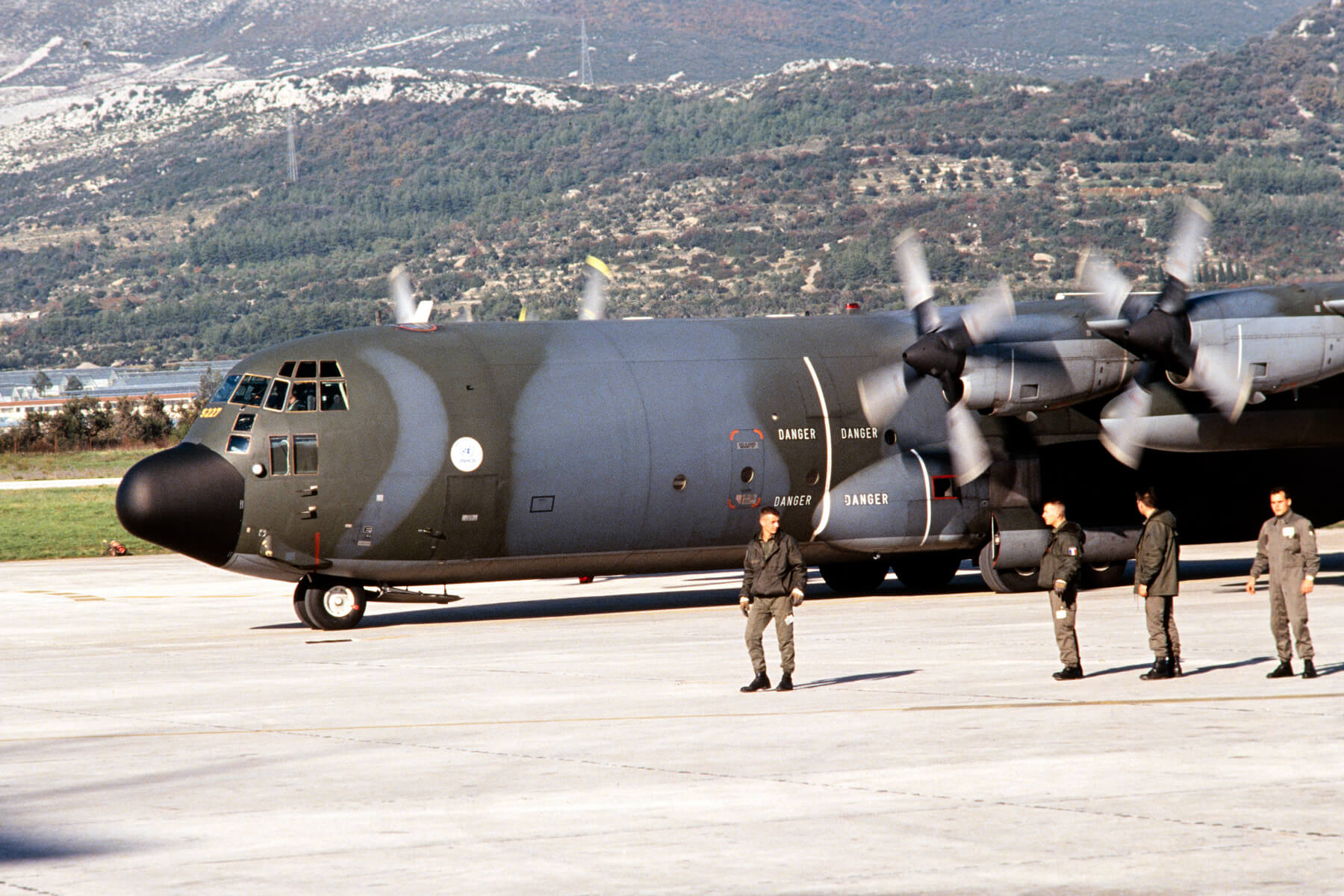
[BOS 81] Arrival at Split Airport, Croatia by UNHCR C-130 Hercules military transport aircraft with Maybe Airlines. Maybe Airlines was a nickname of the official UN airline operated out of Sarajevo during the Bosnian War. It was called Maybe Airlines as it was never known if there would be a flight or not.
Images from this assignment were used widely in full page national newspaper campaigns and magazine articles to inform the public and appeal to governments to intervene in the unfolding humanitarian disaster.
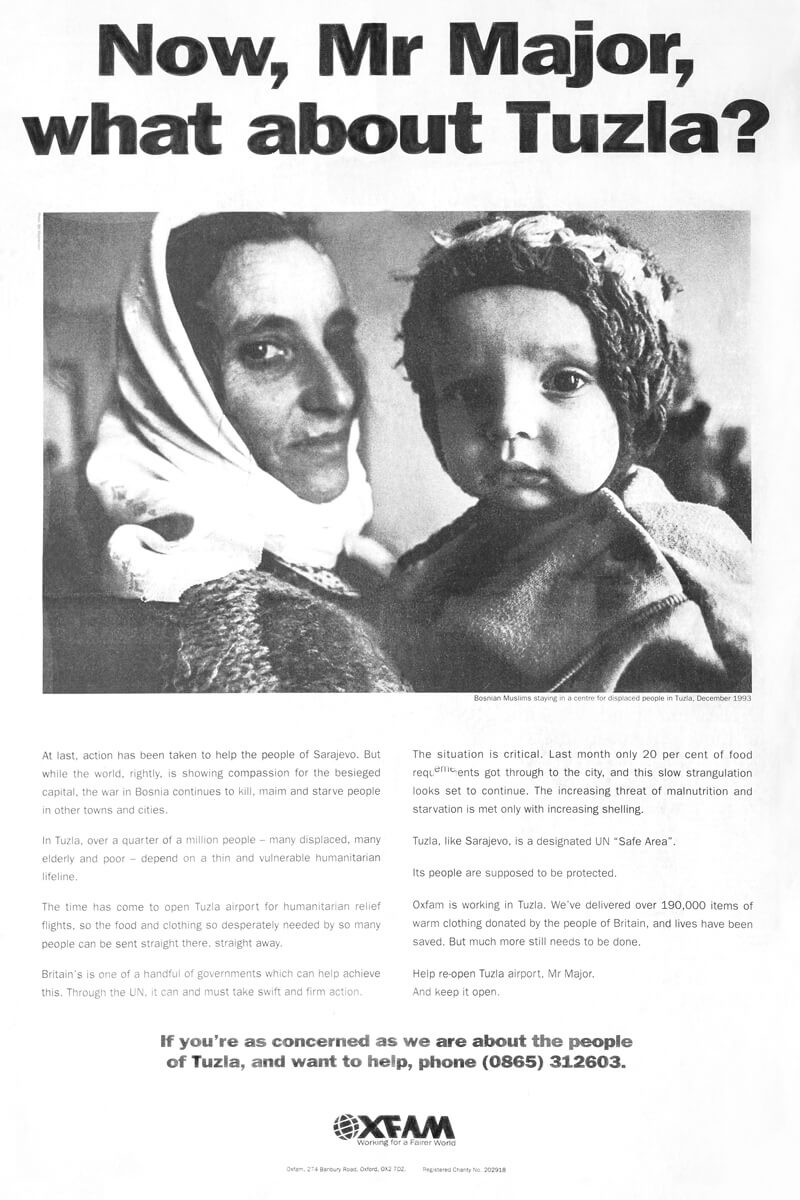
[BOS 84] This advertisement used image BOS 48 and captioned Now, Mr Major, what about Tuzla? Full page advertisements were placed in the Independent, Guardian, Daily Telegraph, Times and other national newspapers on Monday, 14th February 1994.
The purpose of this advertising campaign by Oxfam was to raise awareness to the plight of a quarter of a million displaced people in the besieged city of Tuzla. These civilians were totally dependant on humanitarian aid that currently arrives infrequently overland. It is demanding that UK prime minister John Major takes action to open Tuzla airport so that aid can quickly and directly reach a population that is increasingly at risk of starvation.
The advert says that only 20% of the food needed to sustain this population arrived by road last month, clearly the threat of starvation and malnutrition is increasing. It also makes the point that Tuzla, like Sarajevo is a designated UN Safe Area. Displaced people have a right to be protected from a war that continues to kill, maim and starve, especially the poor and elderly.
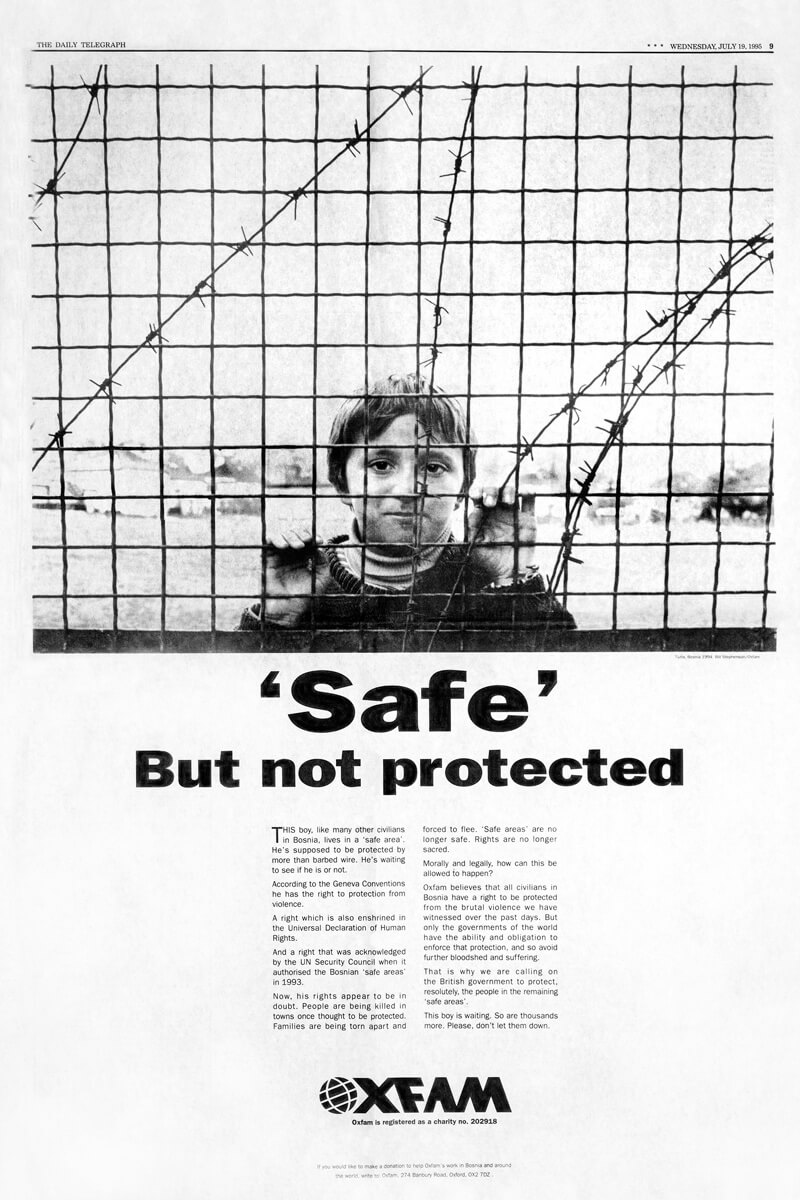
[BOS 85] Safe But Not Protected was a newspaper advertising campaign produced by Oxfam using image BOS 51. Full page advertisements were placed in the Daily Telegraph, Guardian, Independent, Times and other national newspapers on the Wednesday 19th July 1995.
The purpose of the advertisement was to inform the UK public that Safe Areas designated by the UN Security Council in 1993 were no longer places where civilians can be protected from the brutal violence affecting the region. It appeals to the British and other world governments to ensure that civilians in Safe Areas are protected in accordance with the Geneva Conventions Universal Declaration of Human Rights.
Sadly this advert coincided with the Srebrenica genocide between 11th-22nd July 1995 where over 8,000 men and boys were executed. These killings were the single largest massacre of civilians since WW2.
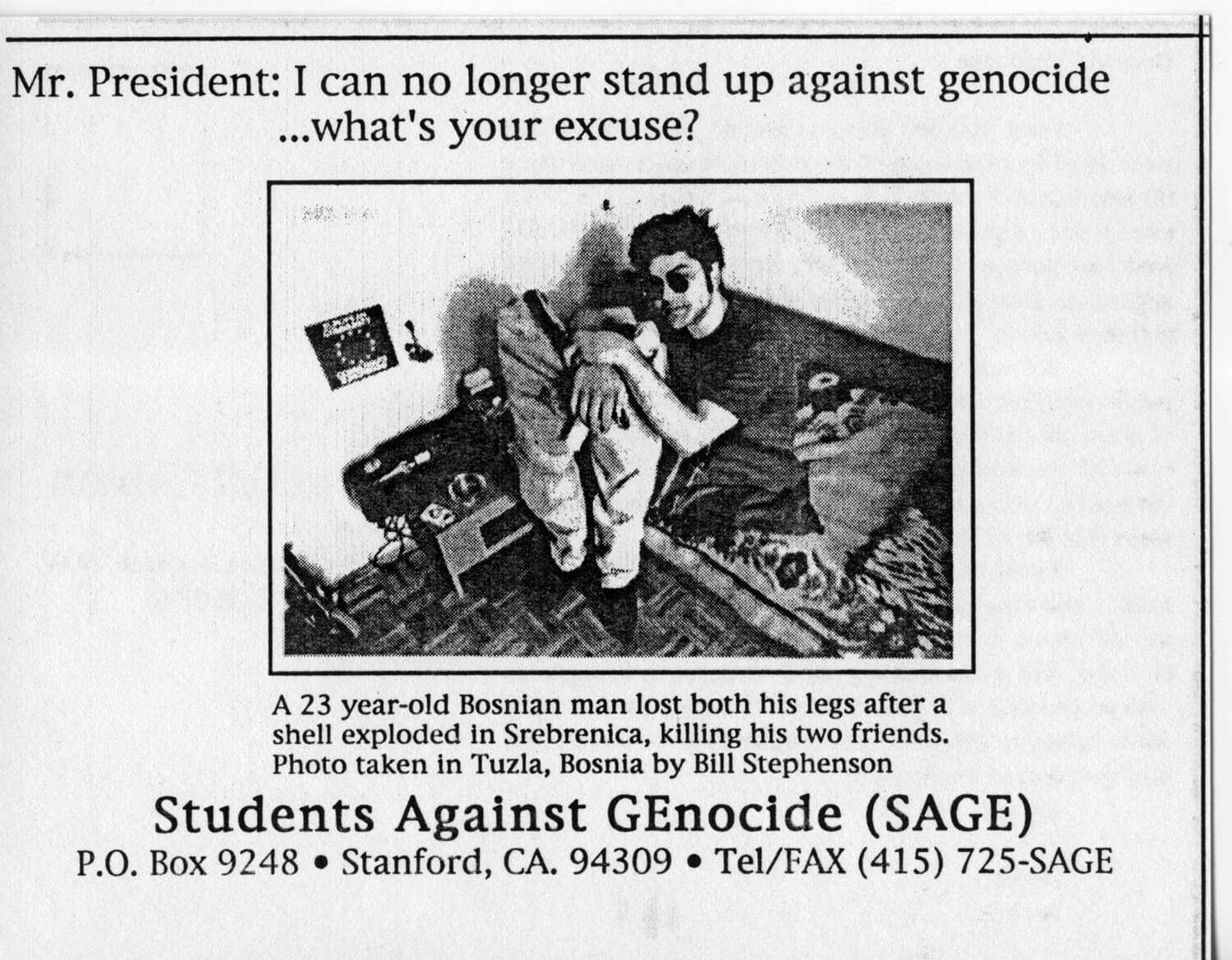
[BOS 86] Tens of thousands of postcards captioned: Mr President: I can no longer stand up against genocide… what’s your excuse? were printed during April 1994 at Stanford University, California, USA using this image BOS 66 of a wounded Bosnian soldier by Students Against GEnocide (SAGE).
They were sent to President Bill Clinton protesting at the Serbian genocide and ethnic cleansing. They were demanding the lifting of an arms embargo which was denying The Republic of Bosnia and Herzegovina the right to self-defence.
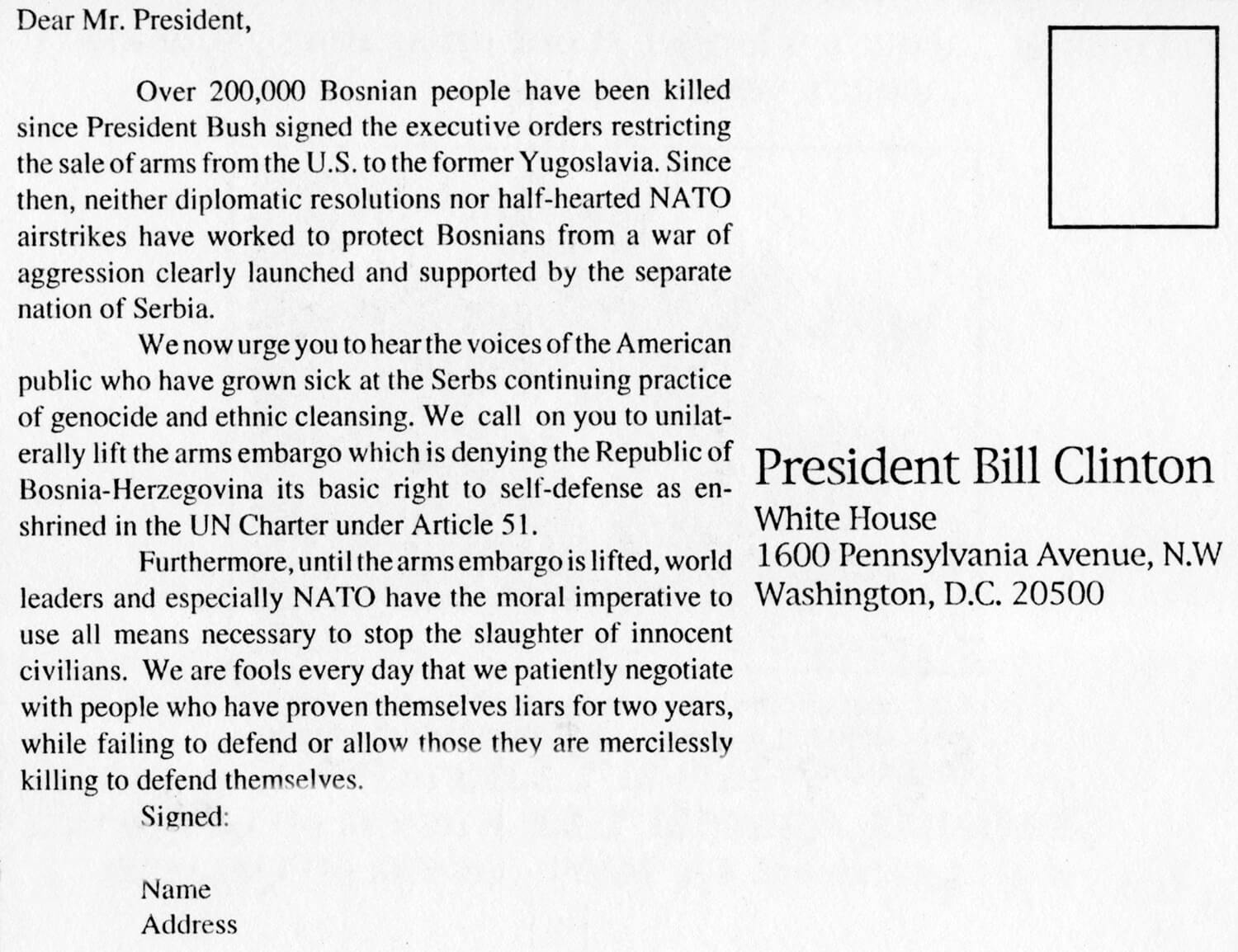
[BOS 87] Postcard reverse text.
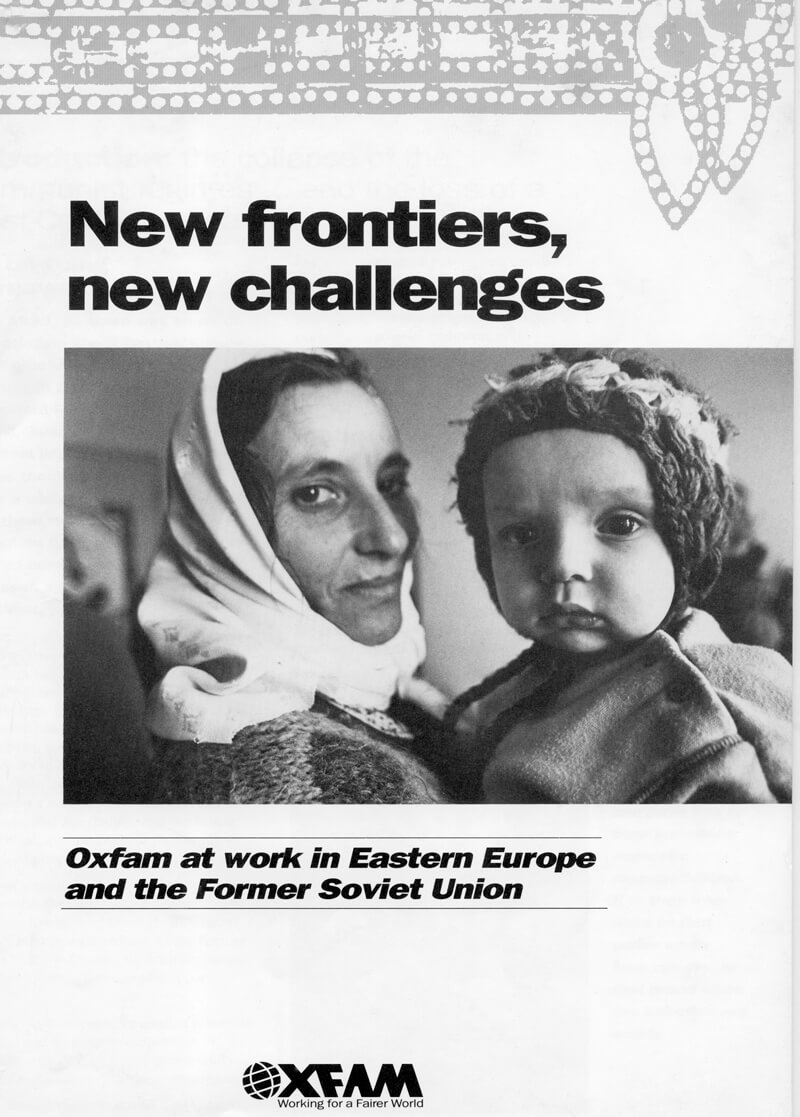
[BOS 88] An illustrated report using cover image BOS 48 and others produced by Oxfam detailing their work in Eastern Europe and the former Soviet Union. September 1994.
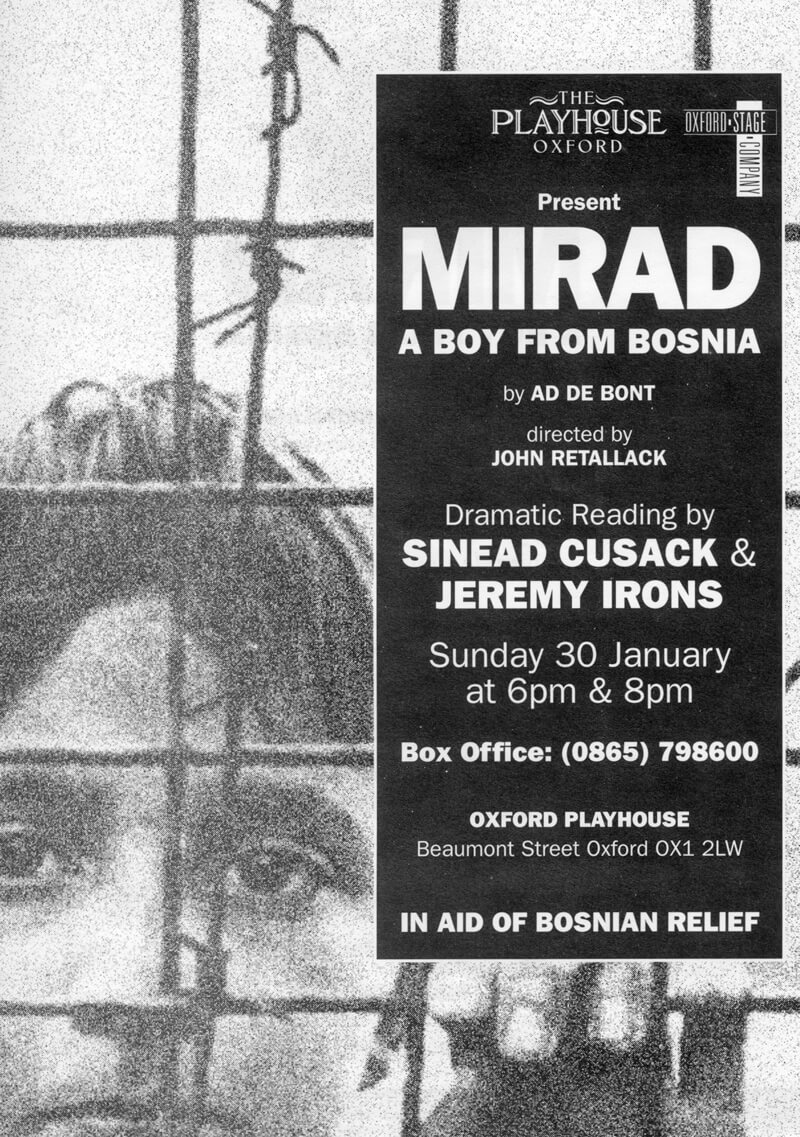
[BOS 89] Poster using image BOS 51 promoting Mirad : A Boy from Bosnia at The Playhouse Oxford, January 1994. Dramatic readings by Sinead Cusack and Jeremy Irons were made in aid of the charity Bosnian Relief.
Additional Photographs from Split, Croatia
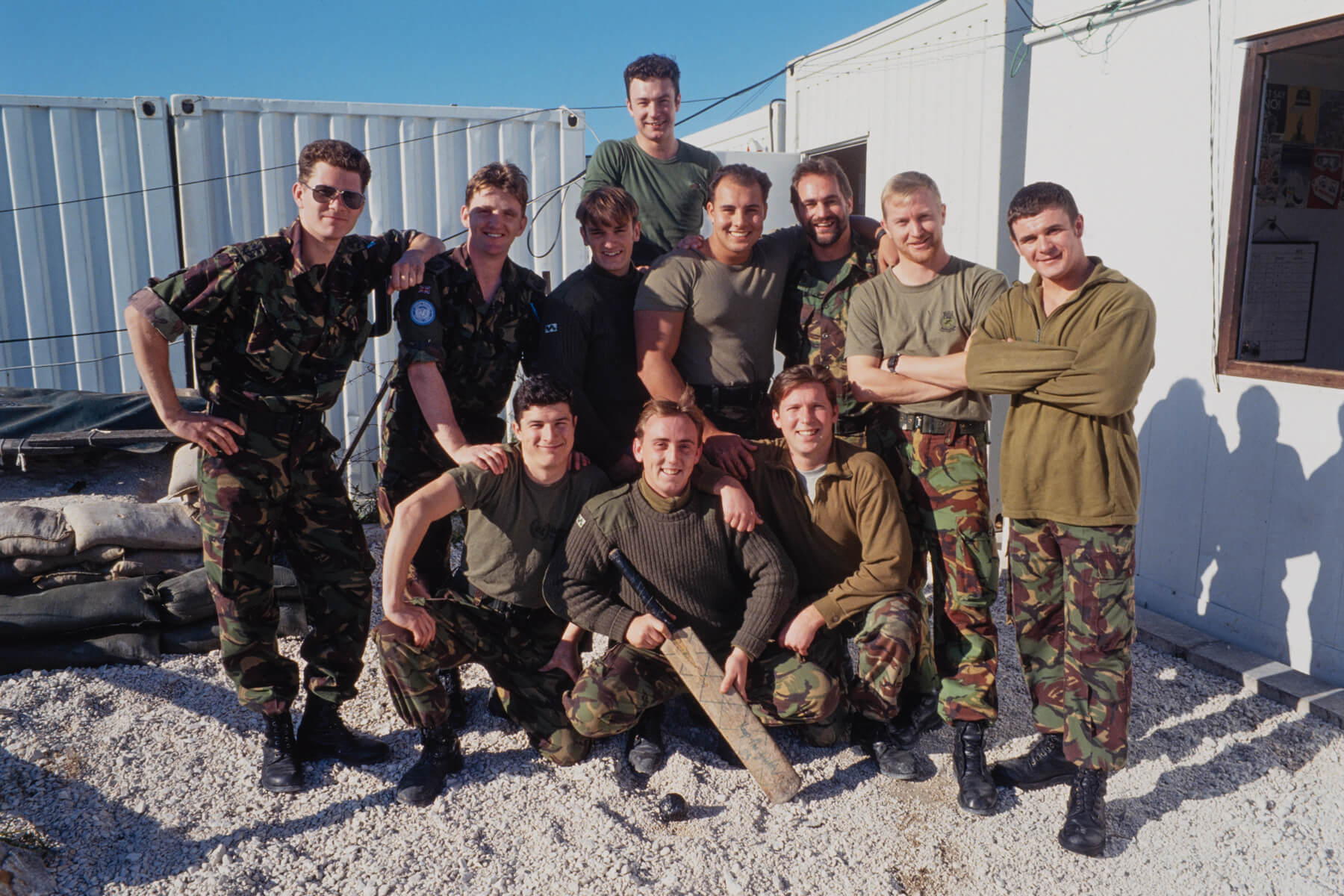
[BOS 90] British United Nations Protection Force (UNPROFOR) soldiers from The Cheshire Regiment await deployment from The Divulje Barracks near Split, Croatia. Their initial mandate of this multi-national force was to ensure stable conditions for peace talks, provide security in three designated demilitarized safe-haven enclaves and protect UNHCR convoys delivering humanitarian aid.
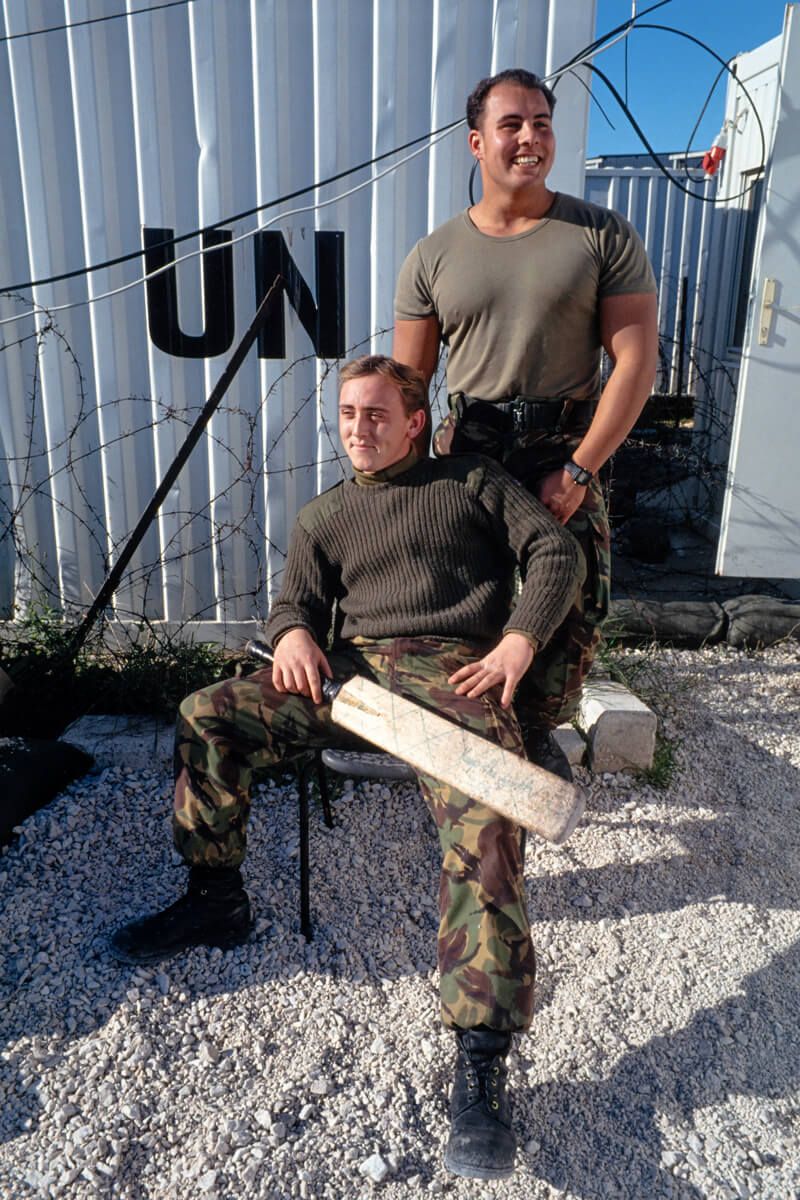
[BOS 91] UNPROFOR soldiers from the Cheshire Regiment pose after playing cricket during R&R.
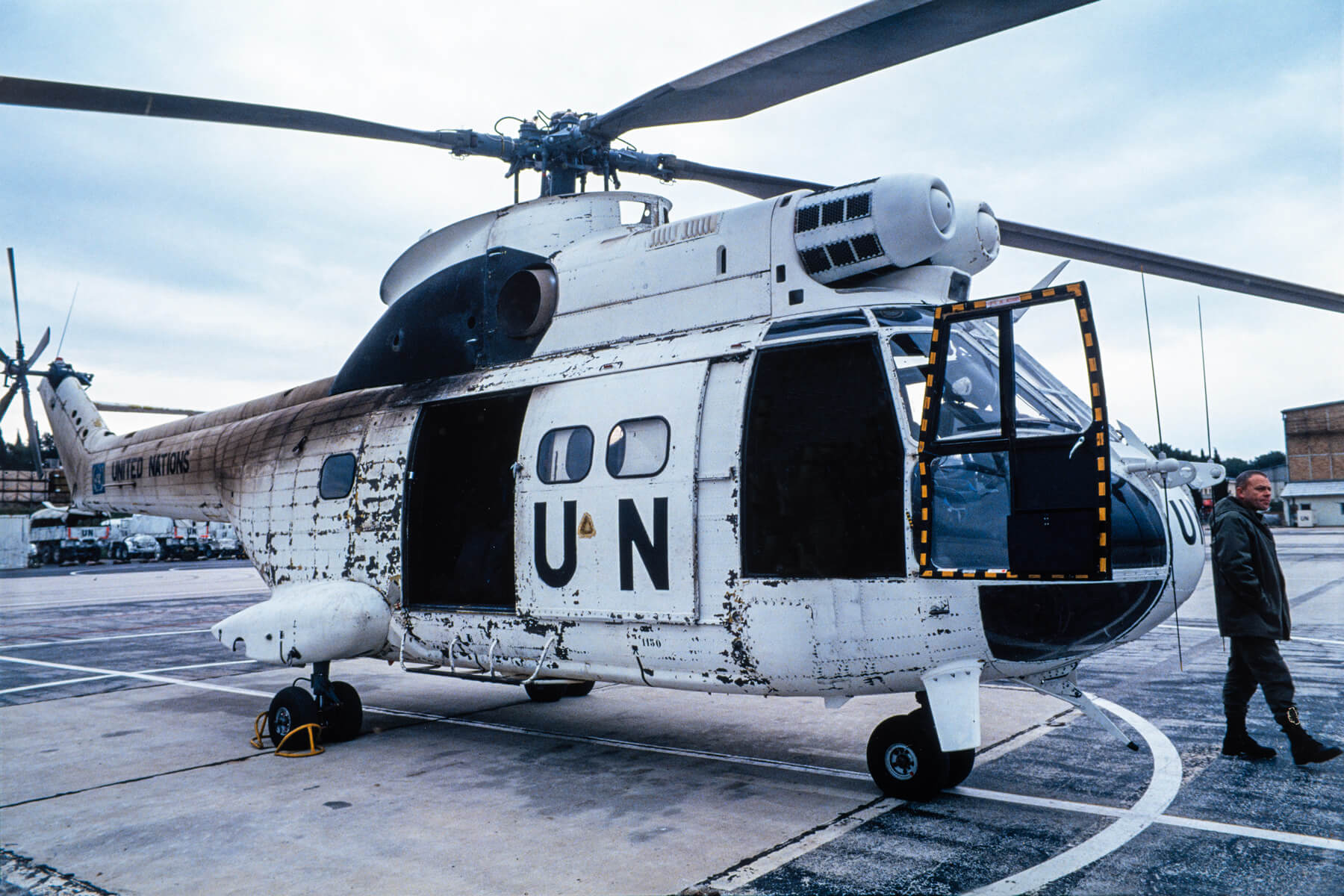
[BOS 92] UN Puma helicopter is prepared for take-off at Split airbase, Croatia.
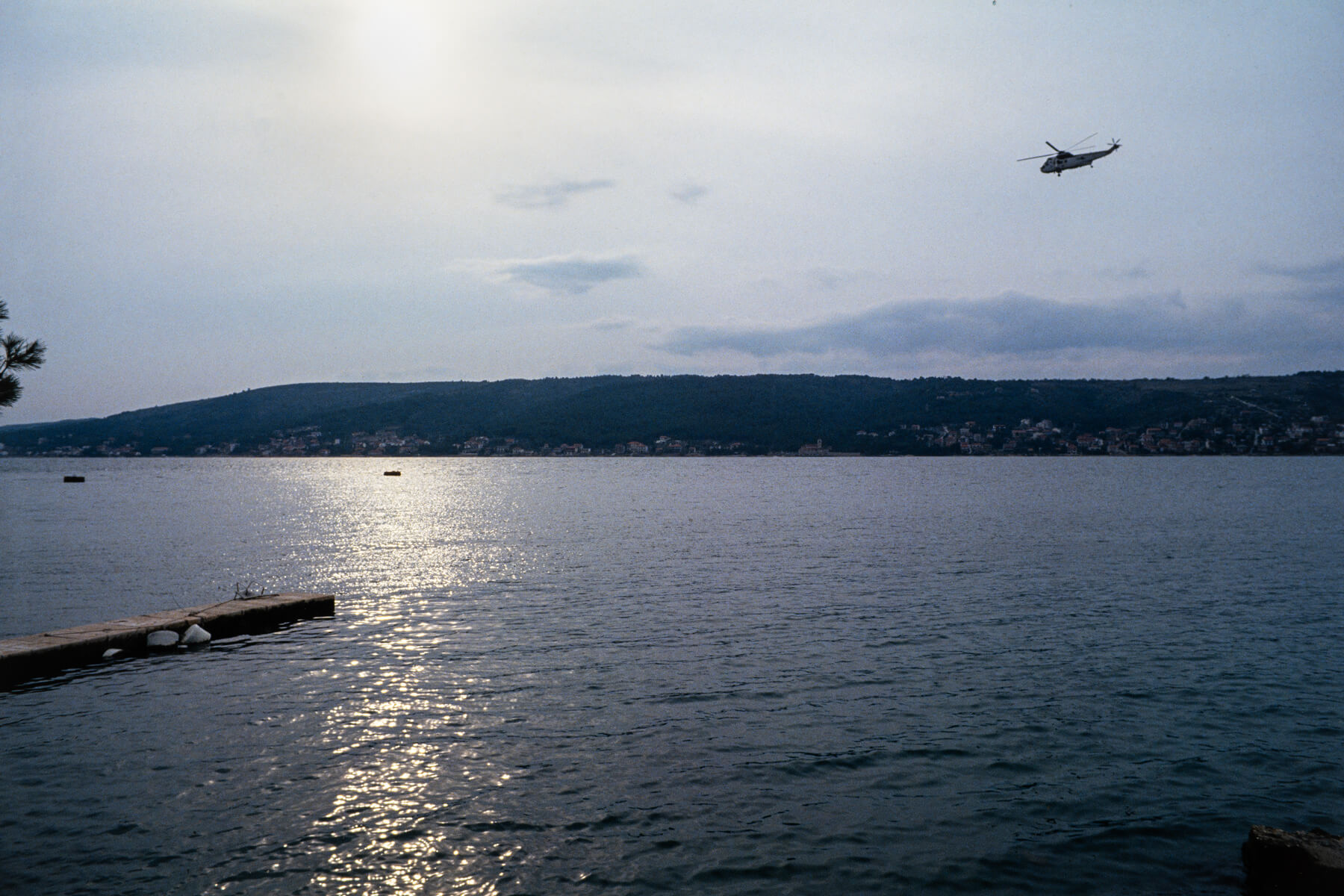
[BOS 93] UN Puma helicopter flies from the relative peace of the Split airbase over the Adriatic en route to Bosnia.
Additional Supporting Material
I recorded these events on my dictaphone while in Tuzla.
“…a solder came into the Oxfam office today and said his daughter was very ill and his family hungry. He said that unless he received some help he would kill his family and then kill himself, but before he did so he would make sure he took a lot of UNHCR staff with him. I gave him a 100 dinar note and he left, we all felt quite useless and wondered why we were all here”.
“…an elderly lady came up to me and threw a ball of ice in my face and shouted ‘help us we are starving’, I could do nothing and kept on walking”‘.
The following photographs and interview was carried out at the Hotel Marjan, Split, Croatia in late November 1993
The Hotel Marjan was a former tourist hotel that had been requisitioned to house 500 refugees from the village of Vjliva. The interviewee and her family were part of the non Serbian population that were expelled or ethnically cleansed, from their village by Serbian Armed Forces in 1991 during the Croatian War of Independence, March 1991-Nov 1995.
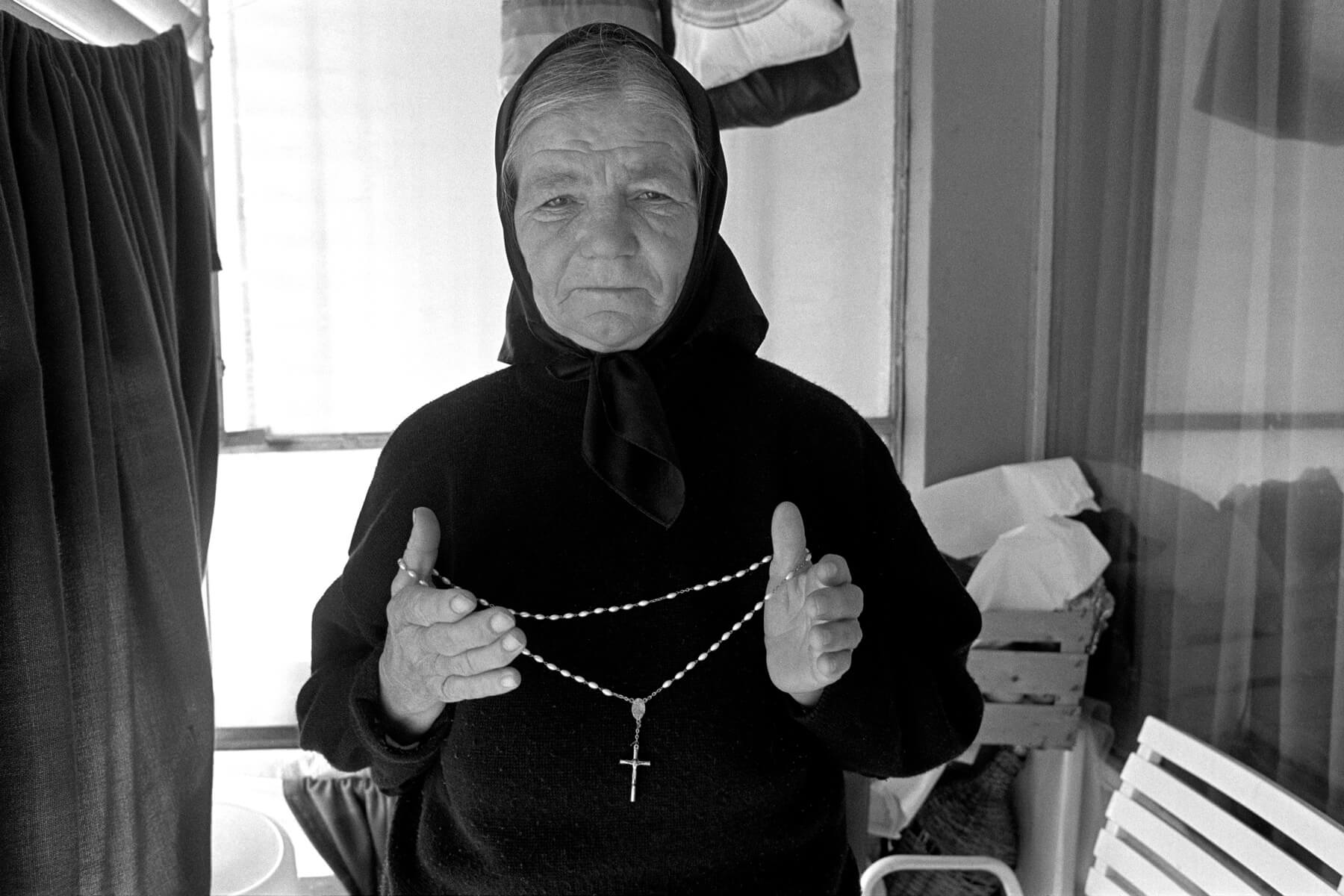
[BOS 93] Croatian refugee at the Hotel Marjan, Split.
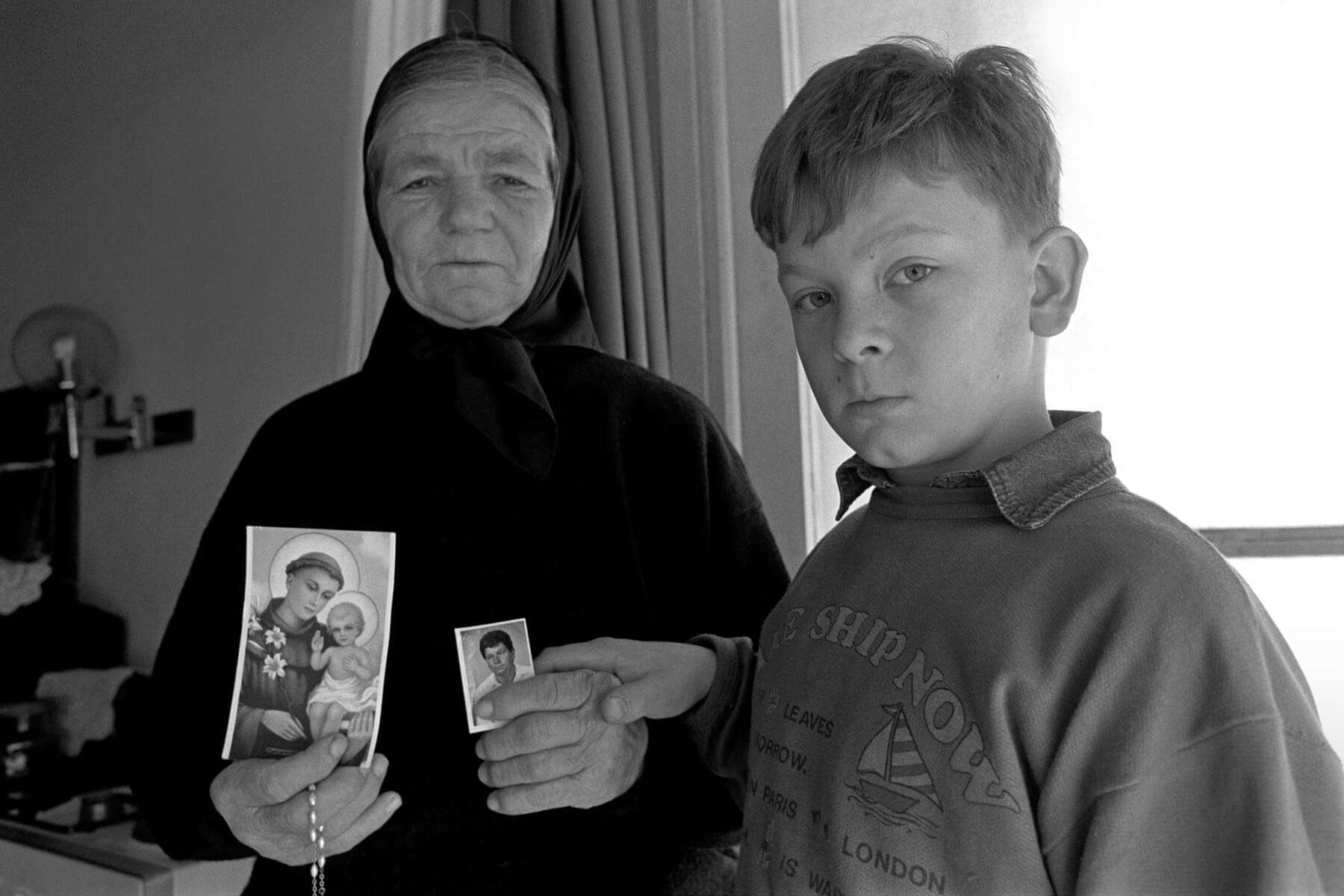
[BOS 94] Croatian refugee and her grandson at the Hotel Marjan, Split.
This statement was made by the daughter of the woman featured in the photographs
“We are Catholic Croats from the village of Vrlika, around 40 km from here. On the 25th August 1991, Serbs, some of whom were our neighbours came to the house beat us and took our money. My mother had her teeth knocked out during the beating. Vrlika was later burnt to the ground by Serb Chetniks at the end of 1991, it was the second time for us, as our houses and churches were burnt by them during WWII.
Between that war and this one, things seemed good between us Croats and the Serbians, but you cannot tell what Serbs really think in their minds. We had even intermarried with some of our Serbian neighbours, we are not political, we are Roman Catholics, some of the Serbians were communist.
When we first arrived here we were optimistic about returning to our village, however now we are depressed living here and are pessimistic about the future. Many people have died at this hotel. They have died from broken hearts and losing hope. A man killed himself in the lobby last week because his government cheque did not arrive.
We cannot see what kind of a future there is for us. Some of us believe they can still see our ruined houses at Vrlika from the top of this hotel”.
Journey from Split, Croatia, via Kisejak, to Tuzla airbase

[BOS 01] French UN Puma pilot smokes a cigarette while his helicopter refuels at UNPROFOR headquarters at Kiseljak en route from Split, Croatia to Tuzla Air Base near Dubrave.

[BOS 02] UN Puma helicopter taking off from UNPROFOR HQ, Kiseljak airbase.

[BOS 03] View from our helicopter flying low, frequently changing direction to avoid detection over the Dinaric Alps en route to Tuzla. It was standard procedure for UN helicopters to fly in pairs for increased safety in hostile locations.

[BOS 04] View of the Dinaric Alps flying towards Tuzla.
The Siege and Blockade of Tuzla
Tuzla is the third largest city in Bosnia and had been blockaded by Serbian Armed Forces to the east and Croatian nationalists to the west for 10 months. The blockade was partly lifted in March 1994 when Tuzla airport opened to UN humanitarian aid flights. However in December 1993 all the key roads around Tuzla had been barricaded, the airport closed, resulting in only small amounts of food and humanitarian aid arriving overland irregularly by UNHCR convoys known as the Tuzla Nomads. The only other way to enter or leave Tuzla was by UNPROFOR armoured personal carriers or UN helicopters.

[BOS 05] Rudarska is the main highway running through Tuzla. The building on the right is pockmarked from gunfire. The 10 months blockade has meant that no petrol or diesel fuel has been delivered for public or private transport, therefore everyone has to walk.

[BOS 06] View along the empty M4, the main road through Tuzla. Photograph taken from Oxfam’s Land Rover.

[BOS 07] View of the empty M4, the main road through Tuzla.

[BOS 08] Soldiers from the Army of the Republic of Bosnia and Herzegovina are mobilised for the defence of Tuzla, they are marching down the main road through Irac. The photograph was taken from Oxfam’s Land Rover.

[BOS 09] People walking down the main road through Irac on their way to work. Many factories and businesses are located in this district. Everyone is on foot as there is no fuel for private cars or public transport.

[BOS 10] Boys delivery goods on a horse drawn wagon past the river Jala.

[BOS 11] Building in the central district of Korzo, pockmarked with shrapnel from an artillery shell. Tuzla was randomly shelled each day from Serbian artillery positions 9km away.

[BOS 12] People rush past the building recently pockmarked from an artillery shell in the central district of Korzo.

[BOS 13] Men collecting firewood from woodland in the Paša Bunar, Skojevska and Slavinovići districts of Tuzla for heating and cooking. Often only one hour of electricity is available each day.

[BOS 14] Man returns with firewood from woodland on the outskirts of Tuzla.

[BOS 15] Man stacks firewood near abandoned cars. No diesel or petrol has been available for 10 months therefore unused cars are everywhere.

[BOS 16] Trees have been cut down for firewood on a hillside on the edge of Tuzla.

[BOS 17] Man shovels through wet coal looking for anything that is suitable to burn.

[BOS 18] Wood and coal smoke from domestic fires partly obscures the city at sunset. Photograph taken from the bridge at Irac overlooking the river Jala.

[BOS 19] With no cars or lorries, a man walks through the silent streets in the old city. This area contains historic buildings from the Austro-Hungarian period. Wood smoke and fog permeate the air. The tree tops (left) have been cut down and burnt for cooking and heating.for cooking and heating.

[BOS 20] Horse drawn wagons wait to haul goods from the Gradska Pijaca market place.

[BOS 21] Men drink wine and smoke in the market place at Gradska Pijaca, where used wood and coal burning cooking stoves are being sold and are in great demand.

[BOS 22] Man selling single cigarettes, packets of cigarettes and soap from a box in the Mosnik district. Despite food and medical shortages, smuggled contraband cigarettes were easily available everywhere.

[BOS 23] Woman selling cigarettes, matches and secondhand clothing from a makeshift stall.

[BOS 24] Man selling mouse poison, mouse glue and soap in the Gradska Pijaca market place. As the collection of household waste has been curtailed the rodent population has multiplied causing infestations throughout the city.

[BOS 25] Weighing out prunes (preserved dried plums) at a market place stall. They were harvested during the previous autumn.

[BOS 26] Woman selling tobacco in the market place.

[BOS 27] Elderly man with neck goitre returns home through the Mosnik district from the market with the only food that is available and can afford, a cabbage.

[BOS 28] The man (and others) make a joke with me.

[BOS 29] Boys try to make a little extra money for themselves and their families selling smuggled cigarettes near the UNHCR office.

[BOS 30] Boys wander the streets getting into mischief.

[BOS 31] Intoxicated man wanders around the streets near the stadium at Batva asking for alcohol and cigarettes.

[BOS 32] A house recently destroyed by a Serbian artillery shell fired from 9km away.

[BOS 33] Boy sits in the ruins of a house in the district of Kula near the city centre, destroyed by a Serbian artillery shell earlier that week. His badge says ARMIJ which is the Army of the Republic of Bosnia and Herzegovina, also known as the Bosnian Army or Bosniak Army. He says he will join the army as soon as he is old enough.

[BOS 34] Terry Hopper is a UNHCR convoy driver from Cambridgeshire, UK. He has been a driver for 6 months. He said that at first he started driving for the money but now it’s for humanitarian reasons. He says, “The drivers ease the stress of each day by talking about their often dangerous journey with each other… we are called The Tuzla Nomads”. A particularly risky section of the road to Tuzla is nicknamed Bomb Alley as UN convoys are frequently attacked along it.

[BOS 35] A newly arrived UNHCR convoy lorry is quickly unloaded at a secure UN storage depot, before the 7pm curfew.

[BOS 36] Winter clothing and shoes being unloaded from the Oxfam Land Rovers by young men and women volunteers into a secure distribution centre.

[BOS 37] Winter clothing and shoes being unloaded from Oxfam Land Rovers by young men and women volunteers into a secure distribution centre.

[BOS 38] Winter clothing and shoes being unloaded from Oxfam Land Rovers by women and children volunteers into a secure distribution centre.

[BOS 39] EC humanitarian aid being unloaded from a recently arrived UNHCR convoy at Lukavac.

[BOS 40] Warehousemen at the UNHCR aid storage depot, Lukavac.

[BOS 41] Refugees and Oxfam staff outside the District School of Solana. This primary school is now a refugee centre for displaced people who have been ethically cleansed from their villages and the surrounding areas.

[BOS 42] Refugee looks out from the school.

[BOS 43] Boy in a school classroom which is now used as a dormitory, he receives just bread for his midday meal.

[BOS 44] Elderly man and his grandson at the school.

[BOS 45] He finds a quiet place to read the Qur’an.

[BOS 46] Women knitting winter clothing at the school with wool supplied by Oxfam.

[BOS 47] This woman (age 43) and her son (age 14) are from a village near Srebrenica , she made this statement:
“I was wounded during a Serbian attack on my village and with the help of my brother was dragged to safety and evacuated to Tuzla by helicopter. I was able to survive and escape from the initial Serbian attack due to a strong counter-attack made by the Bosnian Muslim Army which briefly retook the village. The village was later retaken and is now back under Serbian control, however my husband and my other children are still trapped in the village.
We do not have shoes for the winter and do not have enough to eat. Our life is hard as a refugee, we have no money, job or relatives nearby and are completely dependant on humanitarian aid”.

[BOS 48] Refugee mother and her child from the school. This photograph was used to promote Oxfam’s Cold Front Appeal in 1994. It was used prominently in full page nation newspaper advertisements to raise awareness to the plight of Bosnian Muslims who are facing extreme hardship during the coming winter months.

[BOS 49] Girl looks out over a broken window at the school.

[BOS 50] Refugee boy begs through the fence at a UNHCR aid storage depot asking for food and money.

[BOS 51] This photograph of the refugee boy was used for the Oxford Playhouse production poster for Mirad: A Boy from Bosnia and the Safe But Not Protected newspaper awareness and fundraising campaign.

[BOS 52] Refugees queue in the cold and rain waiting to enter Oxfam’s recycled clothing distribution shop.

[BOS 53] Woman holding her Oxfam clothing entitlement card.

[BOS 54] Woman and her children return from Oxfam’s winter shoe distribution office.

[BOS 55] Bakery worker and her son is happy show his new trainers.

[BOS 56] Women and her children hold their new winter shoes distributed by Oxfam.

[BOS 57] Boy carrying soup and bread from a community canteen in the basement of a tower block up to his family.

[BOS 58] Elderly woman living in a housing block which has only limited electricity providing heating each day. Soup and bread is delivered to her from a community canteen.

[BOS 59] Women brushes her friend’s hair. Many elderly people stay in bed all day to keep warm.

[BOS 60] Medics outside a field dressing station (ratna bolnica) at Kalesija 23km east of Tuzla. This field dressing station provided immediate first aid to wounded soldiers and was located close the battle zone.

[BOS 61] A soldier wounded by mortar shrapnel earlier that morning is visited by his friends at the field dressing station.

[BOS 62] Wounded soldier at the field dressing station.

[BOS 63] Medic and wounded soldier in the basement at the field dressing station. He is being treated for shrapnel wounds to his legs.

[BOS 64] Medic and wounded soldier. He is visited by his wife and father in the basement of the field dressing station.

[BOS 65] Exhausted medic and volunteer orderlies at the field dressing station.

[BOS 66] Emil Razvaliac aged 25 is a double amputee and former waiter who is now being treated at the University Clinical Center (UKC) rehabilitation centre.
He made this statement:
“I am a soldier injured by a mortar shell in Srebrenica which killed my two friends, I was transported to hospital two days later. I consider myself lucky as the shell landed at my feet, cutting my legs off immediately, however, the trajectory of the shrapnel hit my comrades in the chest and head killing them. I want to return to the front line again and want to thank Handicap International for my new legs and jeans”.
This photograph of Emil was used by Students Against GEnocide (SAGE), as a postcard and sent in their thousands to President Bill Clinton appealing to him to lift an arms embargo. The arms embargo was imposed to prevent the war escalating in September 1991. However, all this achieved was to create an imbalance in weaponry between the Serbs to the disadvantage of the Bosnian Army.

[BOS 67] Civilian amputees injured by bomblets from cluster bombs. Cluster bombs were dropped over a wide area surrounding Tuzla from Serbian jets. These bomblets are designed to detonate and maim when stood on or touched.

[BOS 68] Civilian and military amputees at University Clinical Center (UKC) rehabilitation centre.

[BOS 69] Military double amputee at the rehabilitation centre. The plaster on the window covers a bullet hole.

[BOS 70] He practices walking down the corridor.

[BOS 71] Boy shows me his younger brother’s decayed teeth at the Public Orphanage at Kozaračka.

[BOS 72] Boys prepare the soil to grow cabbages in the orphanage vegetable garden.

[BOS 73] Boys take a break from working in the orphanage vegetable garden.

[BOS 74] Defiant boys outside the orphanage.

[BOS 75] Girls carry clean water to the orphanage kitchen. They are still waiting to receive their winter shoes.

[BOS 76] Many thanks to Jasmina Husanovic, Oxfam’s programme manager in Tuzla who assisted me as translator and facilitator during this assignment.

[BOS 77] Staff at Oxfam’s office Tuzla, December 1993. Many thanks to Oxfam’s Bosnia representative in Tuzla, Andrew Chadwick and Geoff Sayer at Oxfam GB’s HQ, Oxford, UK.
Return Journey from Tuzla to Split, Croatia, via Sarajevo
The first part of this journey was made overland from Tuzla by UNPROFOR armoured personnel carrier to the Holiday Inn, Sarajevo. The following day I travelled in a lightly armoured UNPROFOR Land Rover to Sarajevo Airport. The final leg to Split Airport was made by UNHCR C-130 Hercules military transporter.

[BOS 78] Early morning view of the twin Unis Towers nicknamed Momo and Uzeir opposite the Holiday Inn, Sarajevo. They were extensively damaged by shelling in June 1992 and became symbols of resistance during the Siege of Sarajevo.

[BOS 79] View from a lightly armoured UNPROFOR Land Rover travelling along Sniper Alley en route to Sarajevo airport. Sarajevo was encircled by the Bosnian Serb Army forces between April 1992 -Feb 1996, known as the Siege of Sarajevo. It was the longest siege of a city in the history of modern warfare. High ground around the city gave snipers an extensive field of fire. The main road out of the city to the airport was infamously known as Sniper Alley due to large number of sniper positions that aimed to control all movement in the city.

[BOS 80] View of the Hotel Bristol from sniper alley. The hotel has artillery shell impact damage from Serbian forces which bombarded the building from across the river Milijacka. The hotel was restored in 2010.

[BOS 81] Arrival at Split Airport, Croatia by UNHCR C-130 Hercules military transport aircraft with Maybe Airlines. Maybe Airlines was a nickname of the official UN airline operated out of Sarajevo during the Bosnian War. It was called Maybe Airlines as it was never known if there would be a flight or not.
Images from this assignment were used widely in full page national newspaper campaigns and magazine articles to inform the public and appeal to governments to intervene in the unfolding humanitarian disaster.

[BOS 84] This advertisement used image BOS 48 and captioned Now, Mr Major, what about Tuzla? Full page advertisements were placed in the Independent, Guardian, Daily Telegraph, Times and other national newspapers on Monday, 14th February 1994.
The purpose of this advertising campaign by Oxfam was to raise awareness to the plight of a quarter of a million displaced people in the besieged city of Tuzla. These civilians were totally dependant on humanitarian aid that currently arrives infrequently overland. It is demanding that UK prime minister John Major takes action to open Tuzla airport so that aid can quickly and directly reach a population that is increasingly at risk of starvation.
The advert says that only 20% of the food needed to sustain this population arrived by road last month, clearly the threat of starvation and malnutrition is increasing. It also makes the point that Tuzla, like Sarajevo is a designated UN Safe Area. Displaced people have a right to be protected from a war that continues to kill, maim and starve, especially the poor and elderly.

[BOS 85] Safe But Not Protected was a newspaper advertising campaign produced by Oxfam using image BOS 51. Full page advertisements were placed in the Daily Telegraph, Guardian, Independent, Times and other national newspapers on the Wednesday 19th July 1995.
The purpose of the advertisement was to inform the UK public that Safe Areas designated by the UN Security Council in 1993 were no longer places where civilians can be protected from the brutal violence affecting the region. It appeals to the British and other world governments to ensure that civilians in Safe Areas are protected in accordance with the Geneva Conventions Universal Declaration of Human Rights.
Sadly this advert coincided with the Srebrenica genocide between 11th-22nd July 1995 where over 8,000 men and boys were executed. These killings were the single largest massacre of civilians since WW2.

[BOS 86] Tens of thousands of postcards captioned: Mr President: I can no longer stand up against genocide… what’s your excuse? were printed during April 1994 at Stanford University, California, USA using this image BOS 66 of a wounded Bosnian soldier by Students Against GEnocide (SAGE).
They were sent to President Bill Clinton protesting at the Serbian genocide and ethnic cleansing. They were demanding the lifting of an arms embargo which was denying The Republic of Bosnia and Herzegovina the right to self-defence.

[BOS 87] Postcard reverse text.

[BOS 88] An illustrated report using cover image BOS 48 and others produced by Oxfam detailing their work in Eastern Europe and the former Soviet Union. September 1994.

[BOS 89] Poster using image BOS 51 promoting Mirad : A Boy from Bosnia at The Playhouse Oxford, January 1994. Dramatic readings by Sinead Cusack and Jeremy Irons were made in aid of the charity Bosnian Relief.
Additional Photographs from Split, Croatia

[BOS 90] British United Nations Protection Force (UNPROFOR) soldiers from The Cheshire Regiment await deployment from The Divulje Barracks near Split, Croatia. Their initial mandate of this multi-national force was to ensure stable conditions for peace talks, provide security in three designated demilitarized safe-haven enclaves and protect UNHCR convoys delivering humanitarian aid.

[BOS 91] UNPROFOR soldiers from the Cheshire Regiment pose after playing cricket during R&R.

[BOS 92] UN Puma helicopter is prepared for take-off at Split airbase, Croatia.

[BOS 93] UN Puma helicopter flies from the relative peace of the Split airbase over the Adriatic en route to Bosnia.
Additional Supporting Material
I recorded these events on my dictaphone while in Tuzla.
“…a solder came into the Oxfam office today and said his daughter was very ill and his family hungry. He said that unless he received some help he would kill his family and then kill himself, but before he did so he would make sure he took a lot of UNHCR staff with him. I gave him a 100 dinar note and he left, we all felt quite useless and wondered why we were all here”.
“…an elderly lady came up to me and threw a ball of ice in my face and shouted ‘help us we are starving’, I could do nothing and kept on walking”‘.
The following photographs and interview was carried out at the Hotel Marjan, Split, Croatia in late November 1993
The Hotel Marjan was a former tourist hotel that had been requisitioned to house 500 refugees from the village of Vjliva. The interviewee and her family were part of the non Serbian population that were expelled or ethnically cleansed, from their village by Serbian Armed Forces in 1991 during the Croatian War of Independence, March 1991-Nov 1995.

[BOS 93] Croatian refugee at the Hotel Marjan, Split.

[BOS 94] Croatian refugee and her grandson at the Hotel Marjan, Split.
This statement was made by the daughter of the woman featured in the photographs
“We are Catholic Croats from the village of Vrlika, around 40 km from here. On the 25th August 1991, Serbs, some of whom were our neighbours came to the house beat us and took our money. My mother had her teeth knocked out during the beating. Vrlika was later burnt to the ground by Serb Chetniks at the end of 1991, it was the second time for us, as our houses and churches were burnt by them during WWII.
Between that war and this one, things seemed good between us Croats and the Serbians, but you cannot tell what Serbs really think in their minds. We had even intermarried with some of our Serbian neighbours, we are not political, we are Roman Catholics, some of the Serbians were communist.
When we first arrived here we were optimistic about returning to our village, however now we are depressed living here and are pessimistic about the future. Many people have died at this hotel. They have died from broken hearts and losing hope. A man killed himself in the lobby last week because his government cheque did not arrive.
We cannot see what kind of a future there is for us. Some of us believe they can still see our ruined houses at Vrlika from the top of this hotel”.
All the photographs from this assignment were shot on Nikon F3 film cameras using mostly a 28mm wide angle lens. I used 400asa Tmax b/w film and 100asa Fujichrome transparency film.
All images are Strictly Copyright © Bill Stephenson All Rights Reserved
